

The PERFECT 3 Days in Kyoto Itinerary (2024 Update)
- Last Updated: January 26, 2024
Everything you need to know to plan your perfect 3 days in Kyoto itinerary!
Kyoto, once the capital of Japan, is home to a seemingly unlimited number of things to do .
From strolling quiet bonsai filled gardens to temple-hopping an unforgettable gold and silver pavilions.
This Kyoto 3 day itinerary will guide you through what you cannot miss out on in such a short window.
You’ll get some stunning views overlooking parts of Kyoto and walks through thousands of torii gates. Visit temples and shrines and stroll through a bamboo forest.
Also, plan on having some interesting cuisine of Kyoto – including fire ramen.
Yes, a bowl of ramen that is literally lit on fire just before serving!
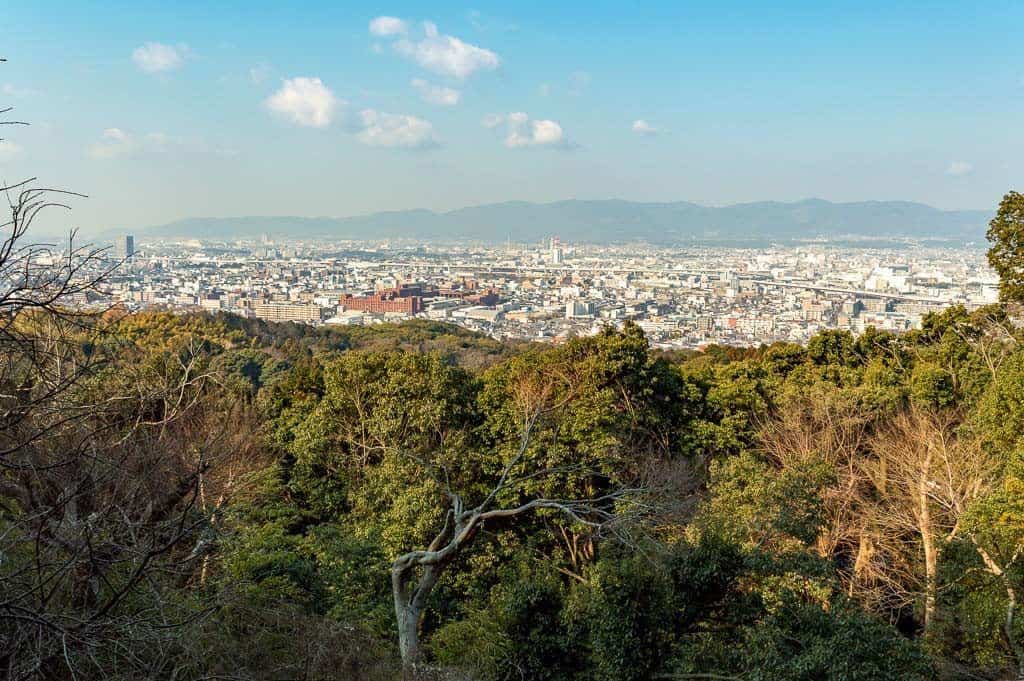
With all these memorable sights and attractions, 3 days in Kyoto might not sound like enough – as there will always be more to see in a city with a vast history and a unique, and often quirky Japanese culture.
Before we dive right into this 3 day Kyoto itinerary, here is a short history lesson for one of Japan’s best places to visit .
Table of Contents
History of Kyoto
8:45am – nijo castle, 11 am – menbakaichida fire ramen – lunch, 1 pm – kyoto imperial palace, 4 pm – nishiki market, 8 am – kiyomizu dera temple, 10 am – fushimi inari shrine, 12 pm – lunch, 1 pm – toji temple, 3 pm – ginkaku ji temple – silver pavilion, early – head to arashiyama, 8 am – togetsukyō bridge, 9 am – arashiyama bamboo grove, 11 am – tenryu ji temple, 12 pm – ryoanji temple and lunch, 3pm – kinkaku ji temple, summarizing your 3 day kyoto itinerary.
As mentioned above, Kyoto was once the capital city of Japan, from when it was founded in 794 to 1868.
However, Kyoto, which translates into “capital city,” has not always had the same name.
In 794, the city was founded as Heian.
Kyoto lost its capital city status when Japan handed control over from the leader of the samurai, the Shogun, back to the Emperor.
In 1868, the capital of Japan became Tokyo , where it has stayed ever since.
Today, Kyoto is Japan’s third-largest city (behind Osaka and Tokyo) and has plenty of ways to learn about the history of Kyoto.
There is plenty more on offer than just unforgettable temples.
Your Perfect 3 Days in Kyoto Itinerary
Without further ado, let me tell you what to do in Kyoto in 3 days!
First things first you need to find an awesome place to stay. We recommend staying in the Gion neighbourhood, so you’re central to everything there. You can find great accommodation here on Agoda .
Don’t forget to use our exclusive coupon code AGODANMD10 to get 10% off your booking.
READ MORE: Don’t miss our complete Travel to Japan guide !
Day 1 in Kyoto
We’re going to start off our Kyoto itinerary by tackling some of the best attractions in the city. Don’t forget to start your day early!
First up on this 3-day Kyoto itinerary is Nijo Castle .
One of 17 UNESCO Historic Monuments of Kyoto , Nijo Castle has several beautiful gardens and historical information within its giant fortified walls.
Tokugawa Ieyasu, the founder of the Tokugawa Shogunate, ordered all current feudal lords of Japan to contribute to the building of Nijo Castle.
Construction began in 1601 and completed in 1626.
Nijo Castle and the surrounding complex has been damaged by fire multiple times during the 1700s.
A lightning strike and a fire that ravaged much of Kyoto were to blame for the destruction.
Nijo Castle opens at 8:45 am.
It is a common theme to beat the crowds by arriving early, that’s why you should aim to be here by opening if you intend to have the castle grounds to yourself for a while.
Some of the main points of interest inside Nijo Castle include the Ninomaru Palace – consisting of five separate but joining buildings.
Intricate carvings from wood sand golden leaf decorations are present to this day.
They had the intention of portraying a powerful and wealthy.
One thing to look out for is the intentional “squeaky floors” to warn residents of ninja attacks as you can’t walk on the floor silently!
Nijo Castle is a great example of Japan’s final samurai period and a perfect way to start your 3 days in Kyoto.
Expect to spend 1-2 hours here, depending on how much you want to explore Nijo Castle and its grounds.
If you’re visiting Kyoto in spring, you can admire all the cherry blossoms that bloom on the grounds around the castle.
Kyoto is home to quite a unique style of ramen. In fact, the “fire ramen” is the only one in the world.
Plus, it’s a very short walk from Nijo Castle grounds.
This unforgettable bowl of ramen is in a tiny restaurant, so waiting times for your flaming bowl might take a few minutes to get seated.
That’s why I suggest getting here for a bit of an early lunch. It’s also delicious ramen as well!
Menbakaichida restaurant opens at 11 am, so if you can be within the first 5 or 6 guests, you shorten your waiting time until lunch to zero!
Now, when I say fire ramen, I mean they ignite your dish in a giant fireball in front of you, just before they serve it to you.
To make it safe, you’re given a paper apron for the oil splashes and specific instructions to lean backward on the bar stool.
Although it doesn’t feel it, the fireball is pretty cool.
It’s not just for a show, the flames help bring out the flavour in the green onions.
After a fiery lunch, it’s time to head to Kyoto’s Imperial Palace.
Today, you can visit the palace that served as the residence of the Imperial Family until Japan’s capital moved to Tokyo in 1869.
As is common with large wooden buildings, a fire destroyed the Imperial Palace a total of 8 times.
The version you see today was completed in 1855.
No reservation is currently required, and the opening hours are from 9 am to 5 pm.
Kyoto Imperial Palace is a short 5 minutes drive or 25-minute walk from Nijo Castle. You can combine your visit to the two attractions on a tour with a local guide !
Nicknames by locals as Kyoto’s Pantry, Nishiki Market is seen as the best traditional food market in the entire city.
Somehow, over 130 stalls of foods and goods line the narrow 5 block street in downtown Kyoto.
While this causes limited personal space, the atmosphere from the vendors and customers and all the tasty options to eat make Nishiki Market well worth the visit.
Nishiki Market is around 10 minutes by car or roughly 20 minutes on foot.
There is no entrance fee to enter this congested shopping street in downtown Kyoto.
It’s a perfect place to try some local Kyoto dishes and have a memorable dinner all at once.
If you love food, make sure you check out this foodie walking tour of Kyoto during the daytime!
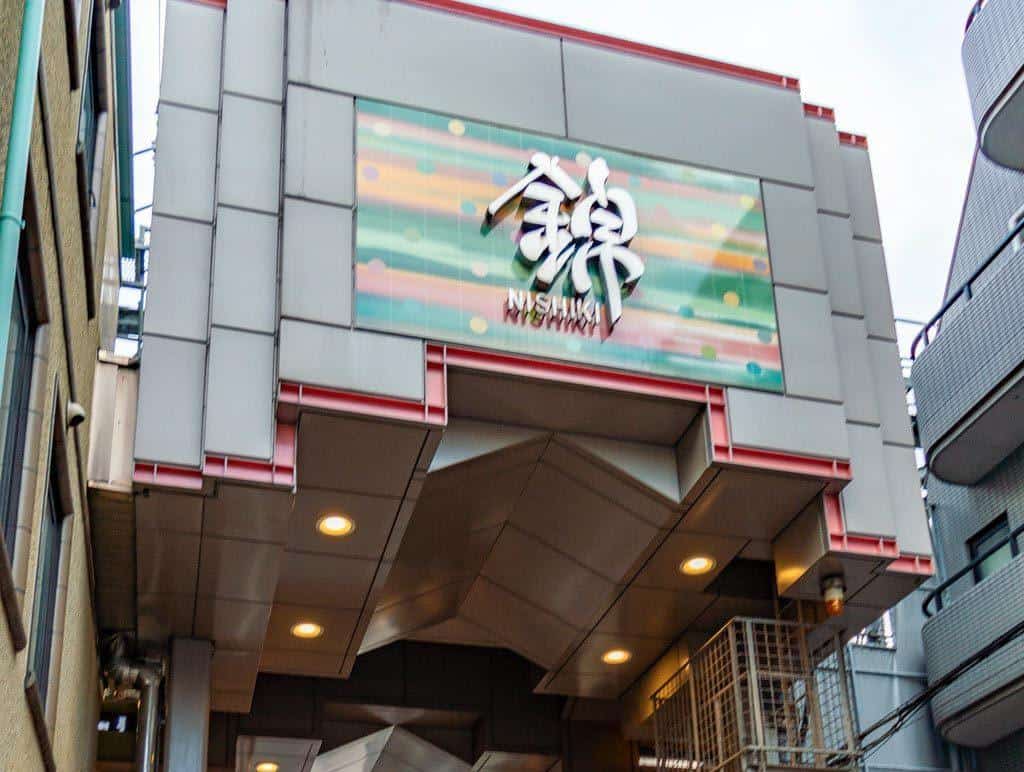
Check out our Japan Vlog on exploring the Higashiyama and Downtown Districts in Kyoto in Japan .
Welcome to day two of your 3-day Kyoto itinerary! Get up nice and early, as it’s going to be a jam-packed day in central Kyoto.
Start your day with a visit to the Kiyomizu Dera Temple, perched on the scenic hills of eastern Kyoto, Japan.
Originally established in 778, the present structure dates back to 1633 and is an architectural marvel, characterized by its wooden terrace jutting out over the hillside, offering a stunning vista of cherry blossoms in spring and vibrant foliage in autumn.
The temple complex is dedicated to the Buddhist deity Kannon and houses a sacred waterfall, Otowa-no-taki, where visitors partake in a ritual of drinking water believed to confer health, longevity, and success.
Kiyomizu Dera Temple stands as a testament to Japan’s religious heritage and architectural prowess. From here it’s just a 12-minute drive or bus ride to your next stop.
Fushimi Inari Shrine is usually the number one attraction – in all of Japan!
This popularity means that it is busy, very busy!
Dedicated to the Shinto God of Rice, Inari, thousands of bright torii gates lead visitors from the main shrine up Mt Inari.
This trail winds up the sacred Inari Mountain and eventually gives off some beautiful views of Kyoto and surrounding areas.
Even if you’re here as early as possible, you won’t be able to escape the crowds by the time you descend Inari Mountain.
But that early morning walk through one of Japan’s most important shrines is amazing.
At the entrance to the shrine complex stands the Romon Gate that was donated in 1589.
Another popular spot for a photo OP is where the torrid gates and pathway splits into a ‘Y’ shape.
Depending on your speed, the full hike to the summit of Mount Inari takes from 2-3 hours, so bring plenty of water and snacks along with you.
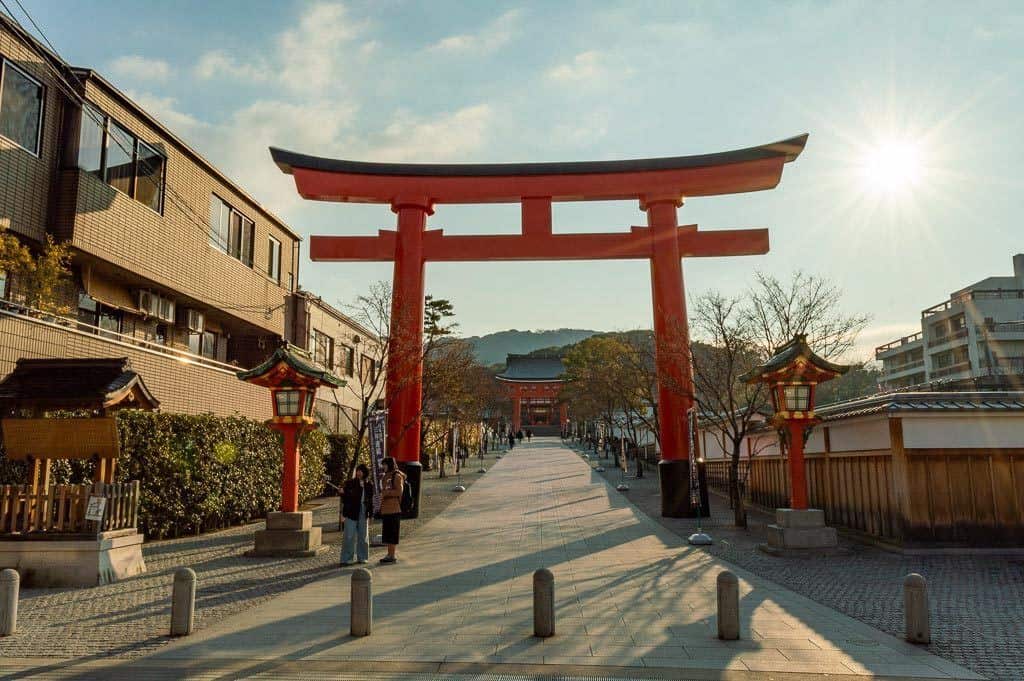
There are plenty of options for great restaurants for lunch around Fushimi Inari Shrine.
If you’re in the mood for sushi, Kyoto Train Station, has a great sushi train option, Ashami .
Whatever you’re looking for, from egg rolls and inari pockets to octopus and even horse meat (providing the translation is legitimate).
It’s a pretty cheap option for lunch with 3 or 4 plates costing around USD$6, depending on what plates you choose.
Toji Temple , or East Temple, was built at the start of the Heian Period in the late 700’s.
This 5 story pagoda is made from wood and is another famous UNESCO World Heritage Site in Kyoto.
Other notable buildings in the complex include Kondo Hall .
Reconstructed in the early Edo Period after a fire in 1486 destroyed the original.
It is considered one of the Toji Temple Complex’s original buildings.
Destroyed in the same fire is Kodo Hall, which sits next door. Kodo Hall served as the lecture hall in the Toji Temple area.
The wooden Toji Tower itself stands 57 meters tall, the tallest in all Japan.
You can get to Toji Temple via the Kintetsu Kyoto Line and is a 5-minute walk from Toji Station.
During cherry blossom season, the grounds around the temple are overflowing with the beautiful flowers as well!
After Shogun Ashikaga Yoshimasa’s death in 1490, Ginkaku ji Temple, or the Silver Pavilion, was reformatted from retirement house to Zen Temple.
While Ginkaku ji Temple is well worth a visit in itself, as are the other buildings in the complex, it is the beautiful moss-covered gardens that steal the show.
Walking a small loop through lush greeny and trickling rivers, it’s hard to find a place equal to the tranquillity of the Ginkaku ji Temple Complex.
Ginkaku ji Temple can be accessed from Kyoto Station by bus #5, 17 or 100.
Opening hours are from 8:30 am to 5 pm.
Expect to spend about an hour here, unless you walk the short trail very slowly taking in the sights.
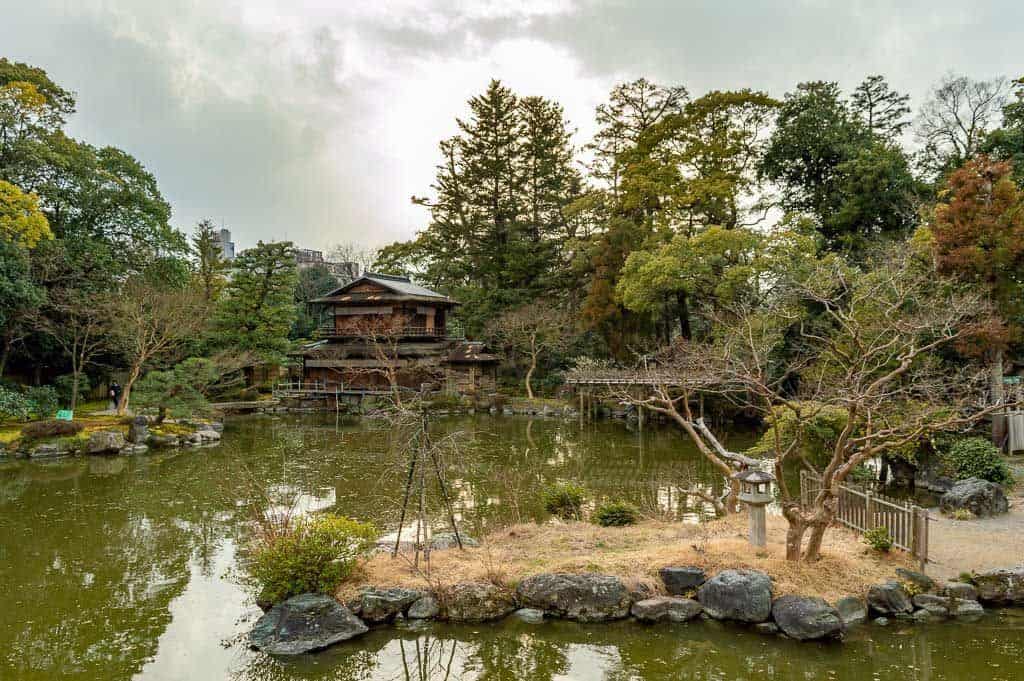
Check out our Japan Vlog on exploring the Gion District in Kyoto, Japan .
We’re almost at the end of your itinerary for Kyoto in 3 days. Don’t think you’ve done everything just yet though, we still have a few more amazing Kyoto activities for you.
On the western edge of downtown Kyoto is the district of Arashiyama .
This whole area is not only a Historic Site of Kyoto, but it’s also a Site of Scenic Beauty, as classified by the Japanese Government.
There are several things to do in the area of Arashiyama, and most are easy walking distance from each other.
As with most popular sites around Kyoto, Arashiyama is popular, and that brings crowds.
Arashiyama is easily accessed from Kyoto Station. Jump on the JR Sagano Line and head to Saga-Arashiyama Station.
From here, the center of Arashiyama is a 10-minute walk.
Check out our Japan Vlog on exploring Kyoto’s most famous attraction in Japan .
If you catch the train to Arashiyama JR Station, you will be close to Arashiyama’s well known Togetsukyō Bridge .
So it makes sense to visit here first.
In fact, the easiest way to get to the next stop, the Arashiyama Bamboo Forest , you’ll cross the bridge anyway.
Togetsukyō Bridge spans 155 meters across the Katsura River.
The original bridge was constructed a little upstream in 1606.
Walking the length of this bridge gives beautiful views of the river below and the surrounding mountains.
You might even get lucky enough to see local fishermen casting in along the banks.
One of the areas most visited sites of Arashiyama is the Bamboo Grove.
This is a natural bamboo forest, with paved trails weaving through the tall shoots of the sturdy, yet flexible plant.
Since 2015, the Arashiyama Bamboo Grove has opened free of charge to visitors.
This makes the attraction near Kyoto even more appealing.
If you’re wanting to visit the Bamboo Grove without hordes of visitors and hand-cart taxis, I suggest starting your day here.
For an even better experience, you can book yourself a great guided tour of the bamboo forests .
Or do something real different and try a rickshaw tour here.
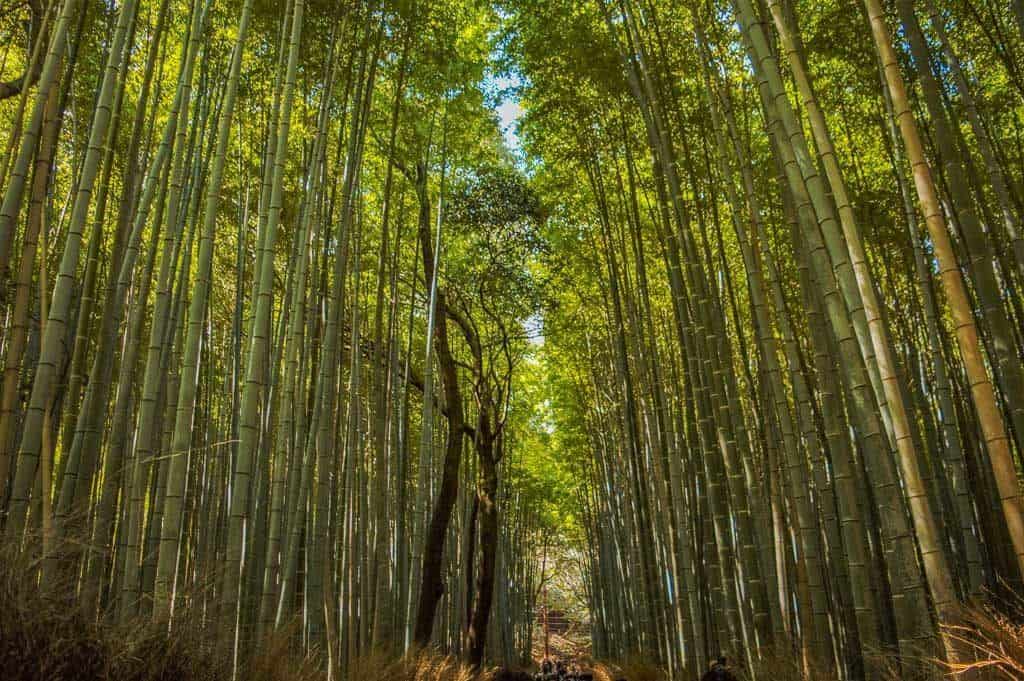
Built in 1339 by the Shogun Ashikaga Takauji, in dedication to Emperor Go-Daigo who passed away as means to ease the spirits of the late ruler.
Much of the temple grounds, including most of the building, have been destroyed multiple times throughout history and now date back to the Meiji Period (1868 – 1912).
The gardens of the Tenryu ji Temple survive in their original state to this day and provide a lovely stroll around the small pond.
Opening hours for Tenryu ji Temple are 8:30 am to 5 pm, and you should expect to spend around an hour here.
Ryoanji Temple was converted into a Zen Temple in 1450.
It’s also the site of possibly Japan’s most renowned rock garden.
Pretty much everything about this rock garden is uncertain, its date of construction and the meaning behind it.
The story I heard most is that these 15, expertly placed stones, resemble a tiger carrying a cub.
One of the most interesting facts, is that in this square enclosure of pebbles, no matter where you stand, you can only ever see 14 stones.
Personally, it’s the surrounding scenery that makes Ryoanji Temple a must-visit with 3 days in Kyoto.
There are plenty of quiet trails and immaculately kept ponds to soak in the reflection of the still surface.
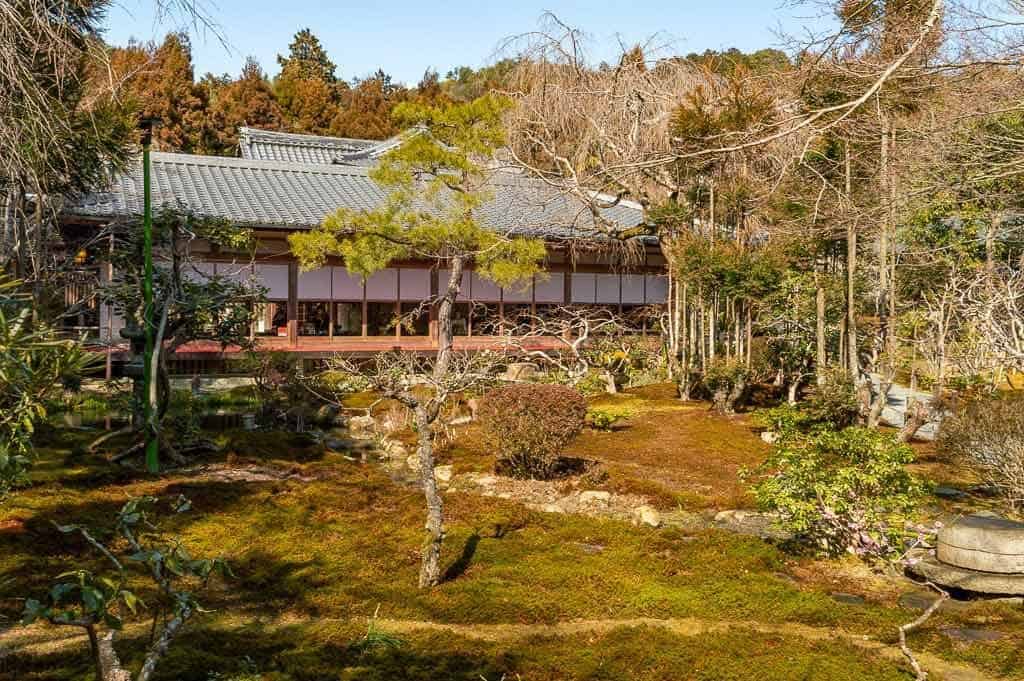
For lunch, there’s no need to leave the temple grounds.
There is a small restaurant that offers a Kyoto specialty, Yodafu .
Boiled tofu in a tasty broth is a lot more filling than you would expect.
This, along with Japanese Tea and a beautiful view overlooking the lush green surroundings is a perfect spot for lunch.
A 3 day Kyoto itinerary wouldn’t be complete without a visit to Kinkaku ji Temple, or the Gold Pavilion.
One of Kyoto’s famed 17 Historic Monuments, the Golden Pavilion Buddhist Temple is one of Japan’s most visited buildings.
This Zen Temple was originally completed in 1397 and reconstructed in 1955 after being burnt to the ground by a novice monk who then tried to commit suicide behind the temple.
The glimmering gold surface has a symbolic meaning and thought to cleanse negative thoughts concerned with death.
As it is so popular, getting a picture or a view without another person in the shot is almost impossible.
By standing next to the edge of the lake, looking out over the glass-like surface and the reflecting golden iconic symbol of Kyoto, it’s hard not to fall in love with Kinkaku ji Temple.
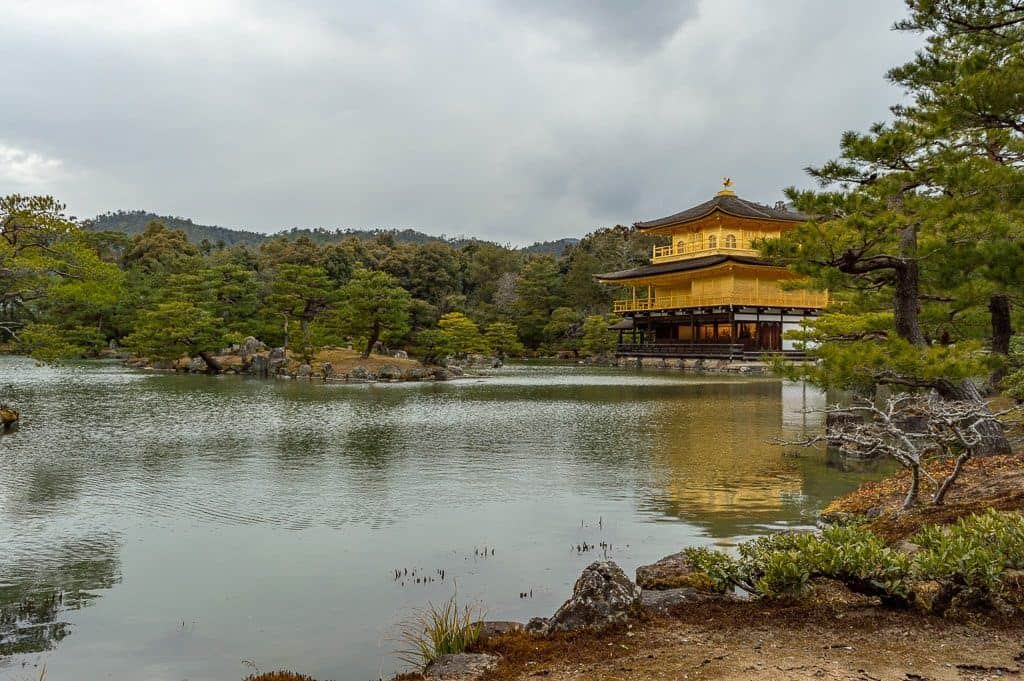
As with all destinations with the vast history and culture of Kyoto, there will always be more to see.
In fact, 3 days in Kyoto is just the beginning of this incredibly beautiful, historic city. There are so many more temples and shrines and hidden gems to check out.
But by following this Kyoto 3 day itinerary, you’ll be treated to a range of cultural, historical and scenic sights that this busy city has to offer.
And by the end of your trip here, you’ll have a small but memorable insight into one of Japan’s ancient capital cities.
Ben McLaughlan
Hi, We’re Alesha and Jarryd!

We’ve been traveling the world together since 2008, searching for the planet’s best destinations and adventures.
Love Travel?
Sign up for our free weekly newsletter for the best travel tips, ideas and deals!
We respect your privacy. Unsubscribe at any time.
READ MORE...
The Perfect 3 Days in Tokyo Itinerary
The Best Day Trips from Every City in Japan [2024]
18 Amazing Things to Do in Kyoto at Night (2024 Guide)
Related Posts
The perfect yokohama itinerary for 1, 2 or 3 days (2024), the perfect 3 days in osaka itinerary [2024 guide], 10 best day trips from kyoto, japan [2024 travel guide], 19 incredible things to do in takayama, japan [2024 guide], 3 thoughts on “the perfect 3 days in kyoto itinerary (2024 update)”.
Love this itinerary! Can’t wait to visit Kyoto in 2024. Your detailed breakdown of the best temples, shrines, and other attractions is incredibly helpful. Definitely bookmarking this for my own trip planning.
Next June we will travel to Kyoto. we are 3 adults, what is the cost of a 3 day package?
Hi Aracelly, That is exciting you are going to Kyoto. Sorry we can not help you. We are not a travel agent. We are a website that gives out travel information. All the best.
Leave a comment Cancel reply
Save my name, email, and website in this browser for the next time I comment.

Home » Travel » Destinations » Kyoto 2 Day Itinerary: A Super Efficient Guide
Kyoto 2 Day Itinerary: A Super Efficient Guide
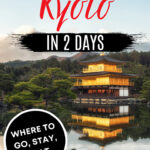
Writing this Kyoto 2 day itinerary was an interesting challenge. Trying to condense my favorite city into 48 hours of sightseeing was no simple feat! But if you can only afford to spend two days in Kyoto, this itinerary will guide you through the ancient city’s highlights as efficiently as possible.
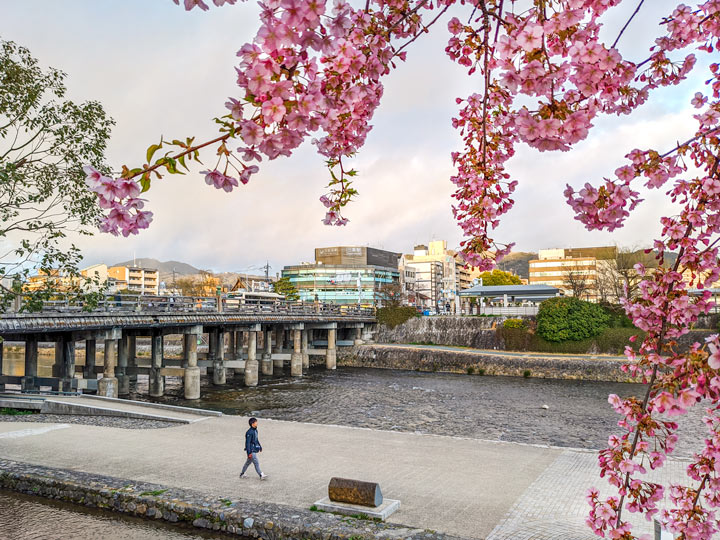
From 794 to 1868, Kyoto was Japan’s capital city and the home of the Imperial family. While Kyoto saw its fair share of war and destruction, it flourished during the 260-year Tokugawa shogunate period and remained relatively unscathed during World War II.
Thankfully, Kyoto’s gorgeous wooden houses and temples have endured alongside the city’s modernization. It’s a place where 1,000-year-old shrines and 7-Elevens co-exist on the same street, and narrow lantern-lit alleys zig zag behind concrete apartment complexes. Few cities in Japan can compete with Kyoto’s elegant blend of natural, traditional, and urban settings.
Kyoto is also home to many of Japan’s most famous places , including 17 UNESCO World Heritage sites, a bamboo forest, and the endless torii gates of Fushimi Inari Shrine. While I couldn’t fit all of them into a 2 day Kyoto itinerary, I’ve squeezed in as many as possible.
This post contains affiliate links. As an Amazon Associate, I earn from qualifying purchases. For more information, click here .
Planning a longer trip to Japan? Check out these itineraries for 6 days in Osaka, Kyoto, and Nara and 10 days in Japan !
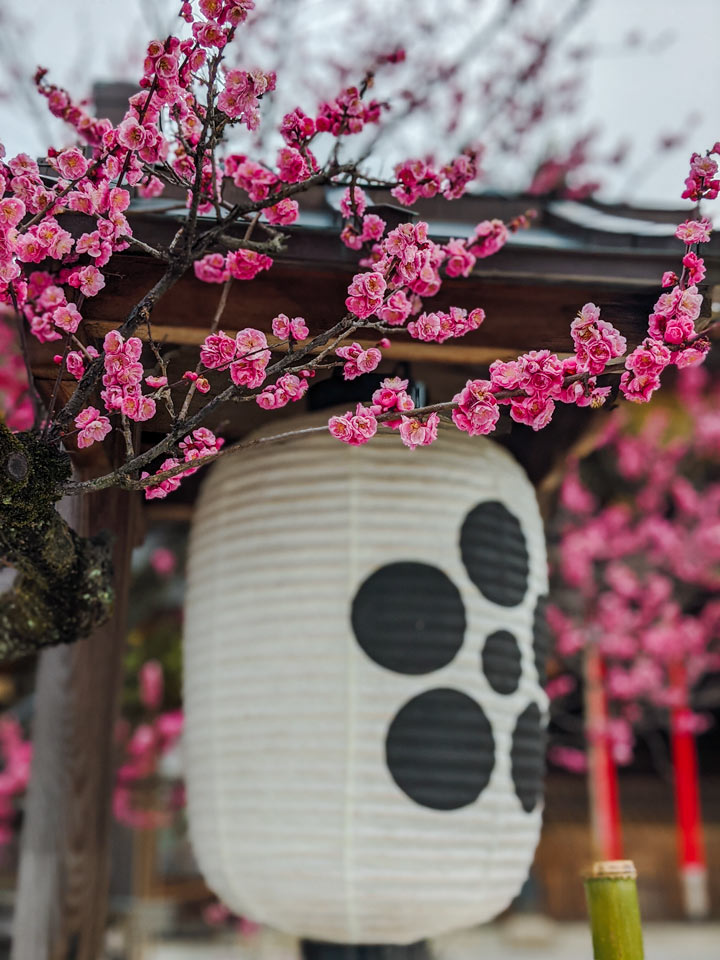
How to Spend 2 Days in Kyoto
Know Before You Go: Kyoto Travel Tips – Is 2 days in Kyoto enough? – The best time to do this Kyoto 2 day itinerary – Where to stay in Kyoto – Getting around Kyoto – Etiquette Kyoto 2 Day Itinerary – Day 1: Kyoto’s Famous Shrines and Temples – Day 2: Bamboo, Castles, and Geisha – Other Places to Visit Near Kyoto
Know Before You Go: Kyoto Travel Tips
Is 2 days in kyoto enough.
Thanks to the city’s sightseeing bus loop, 2 days in Kyoto is just enough time to catch the major highlights. You won’t have much time for relaxing or aimless wandering, but you’ll check off many popular attractions from the typical Kyoto bucket list. If you can spare an extra day or two, I highly recommend it!
The best time to do this Kyoto 2 day itinerary
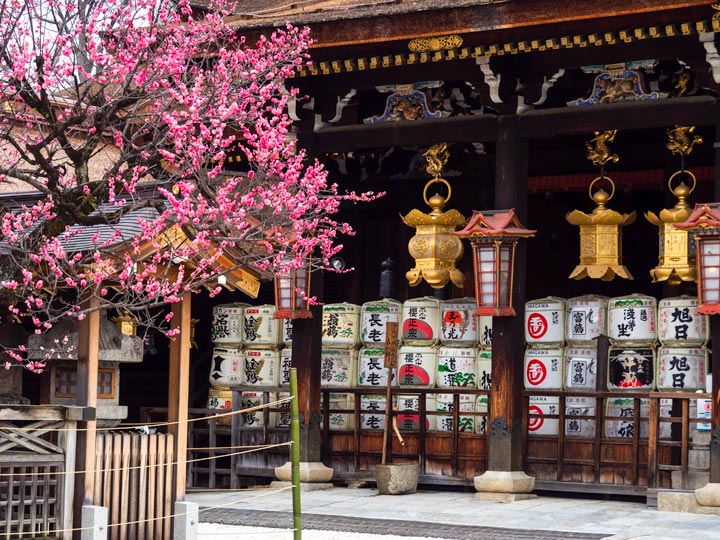
Ah, the eternal question! Choosing the best time to visit Kyoto comes down to three things: budget, scenery, and crowd tolerance.
For this particular Kyoto 2 day itinerary, I strongly suggest either mid-October or late February-early March .
Traveling Japan in October means fewer tourists, cooler weather, cheaper prices, and gorgeous autumn leaves decorating the mountains, shrines, and temples.
Late February kicks off plum blossom season, the oft-forgotten precursor to spring cherry blossoms. Prices will generally be even cheaper than October, and you’ll enjoy plenty of pretty flowers without the cost and crowds of sakura season.
However, the current Emperor’s birthday falls on February 23rd, so there will be a busy public holiday weekend during this time.
I recently re-visited Kyoto in early March as part of a 3 week trip to Japan, and it was the perfect combination of reasonable crowds and pleasant weather. The plum blossoms were at their peak, which made places like Kiyomizudera and Gion even more spectacular.
If your travel plans don’t line up with these times, don’t worry! There’s not a “bad” time to visit Kyoto in terms of weather or attraction closures. However, the crowded spring and summer seasons will make it harder (and more expensive) to move around the city, so it might not be possible to actually do everything outlined in this Kyoto itinerary.
Where to Stay in Kyoto
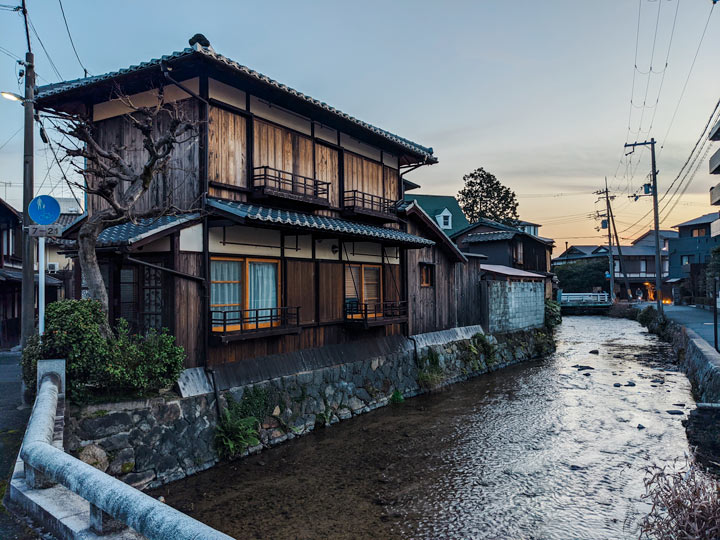
I’ve visited Kyoto several times and can personally recommend two great places to stay.
If you’re after the classic, old-world Kyoto experience, book at Yuzuya Ryokan .
The inn’s name comes from the yuzu citrus trees that grow in the inner garden. They’re conveniently located next door to Yasaka Shrine in Gion and offer everything from kaiseki dinner to in-room massages. I loved coming back after a long day of exploring to rest in the traditional tatami room and soak in the wooden tub.
For a less pricey option, check out Kyoto Traveler’s Inn . It’s conveniently located across from a sightseeing loop bus stop and the giant torii gate (so you’ll never get lost!). Gion and Pontocho are a short walk away. Plus, they offer a mix of Western and Japanese-style rooms depending on your preference.
Getting Around Kyoto
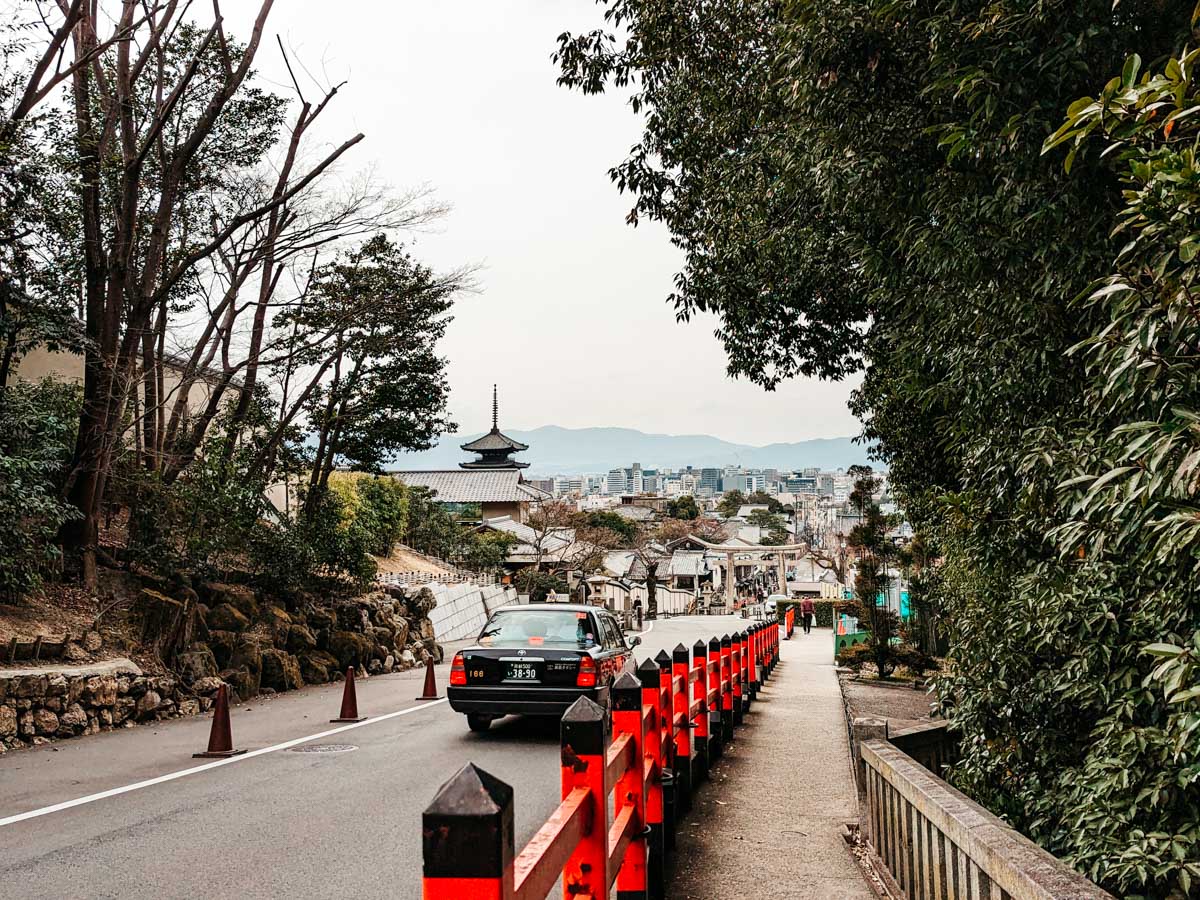
Unlike other Japanese cities, the easiest way to travel between sightseeing spots is by bus. Although there are metro and train lines connecting key sites, it’s often faster to use the local and sightseeing buses to get around (in addition to walking).
The Raku sightseeing buses (#100, 101, and 102) travel clockwise and counterclockwise, stopping at all the major tourist spots. It’s a flat rate fare (230 yen in 2020) no matter where you get on or off, and they accept change and IC cards.
There’s also a JR bus route that stops at a few sites like Nijo Castle and Kinkakuji. JR pass holders can ride for free.
While you can technically save a few bucks on this itinerary by purchasing a Kyoto 2-day subway + bus pass, I don’t think it’s worth the hassle. Just purchase an IC card from one of the machines when you arrive in Kyoto. If you already have a contactless card from another city in Japan (ex. SUICA, PASMO, TOICA, etc.), you can use that instead!
Don’t Forget Your Japan Rail Pass!
Buying a Japan Rail Pass will save you a ton of time and money when traveling across Japan.
I’ve purchased a JR pass for two out of three Japan trips, and here’s why:
– Free bullet trains and reservations : Quickly travel all over Japan to maximize vacation time.
– Easy to use: Just show your pass to the gate attendant and walk to your train!
– Affordable day trips: Visit popular places like Osaka, Kanazawa, and more without spending a fortune on tickets.
Order your Japan Rail Pass now for speedy delivery!
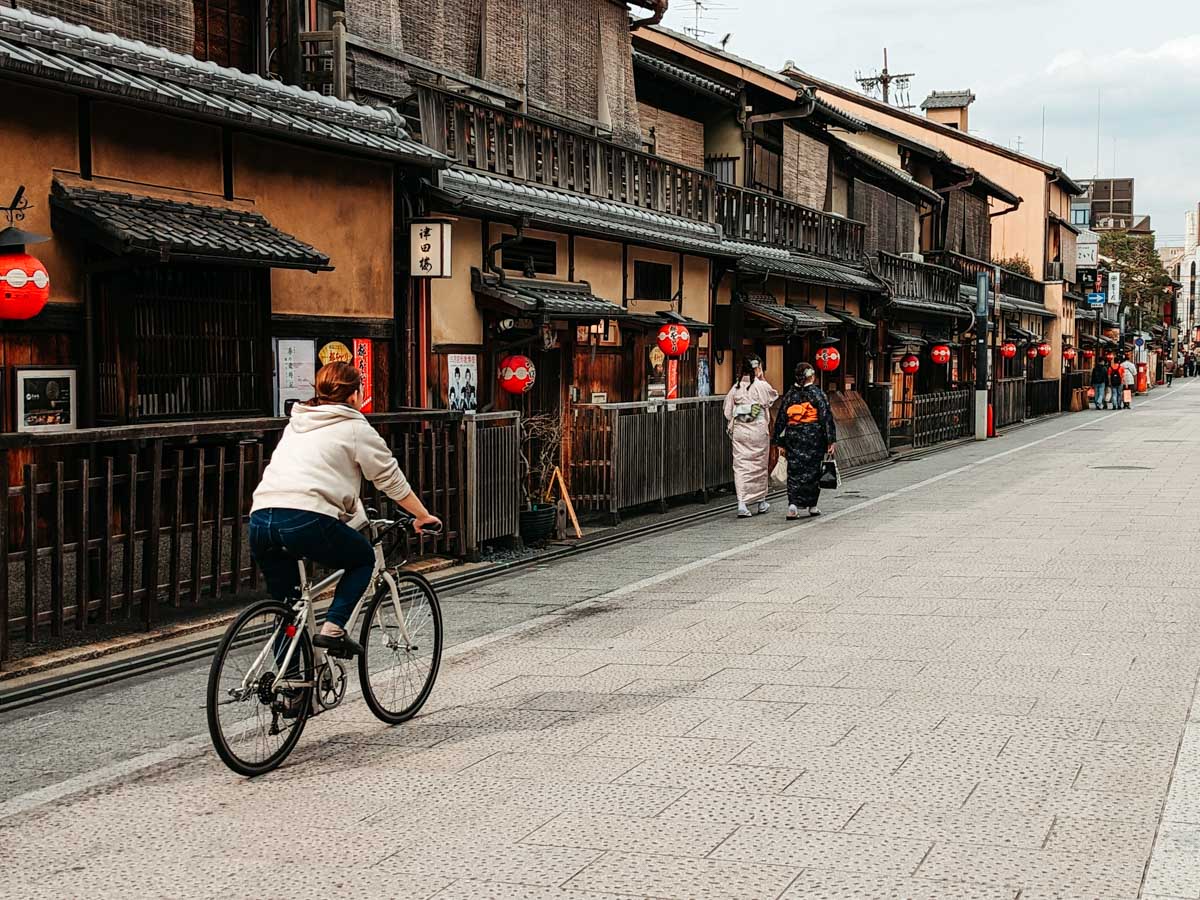
I’ve written an entire post on Japan travel etiquette that covers everything from footwear to trash disposal. But there are a few extra things to keep in mind during your Kyoto 2 day itinerary:
- Do not approach geisha and their maiko apprentices or stop them for a photo
- Always wear (or bring along) good socks, as you’ll need to swap shoes for slippers inside shrines, temples, and some restaurants
- Cash is still king in Kyoto, so always keep an eye out for “cash only” signs inside shops and restaurants
- Please respect the “no photography” signs posted throughout the city’s historic neighborhoods (even if others do not)
Check out my comprehensive Japan travel checklist for packing tips and other useful resources!
Kyoto 2 Day Itinerary
Day 1: kyoto’s famous shrines and temples, kitano tenmangu shrine.
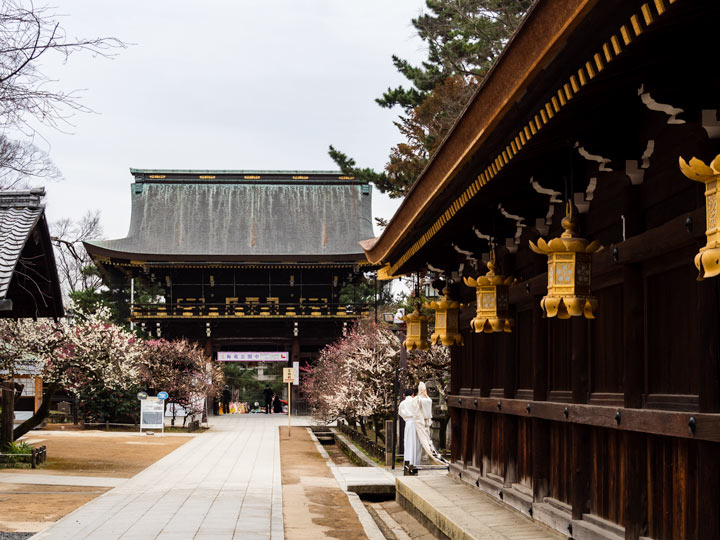
Built in 947, Kitano Tenmangu’s plum blossoms and golden lanterns have become a symbol of Kyoto.
There are hundreds of Tenmangu shrines in Japan, and they’re all dedicated to Tenjin, the patron deity of academics. During exam season, Japanese students and their parents journey here to pet the cow statue heads and pray for wisdom and high scores.
Kitano Tenmangu has an extraordinary plum blossom garden, with hundreds of trees lining the curved walking paths. From late February to early March, you can pay to stroll around the fairytale gardens and enjoy refreshments at small tables facing the colorful grove.
If you visit the shrine on the 25th of the month, stop by the huge Tenjin Market for some antique shopping and street food. It’s an excellent place to pick up affordable and unique souvenirs like old sake cups and kimonos.
To get to Kitano Tenmangu, take the #203 bus to Kitano Tenmangu Mae stop.
Kinkaku-ji and Ginkaku-ji
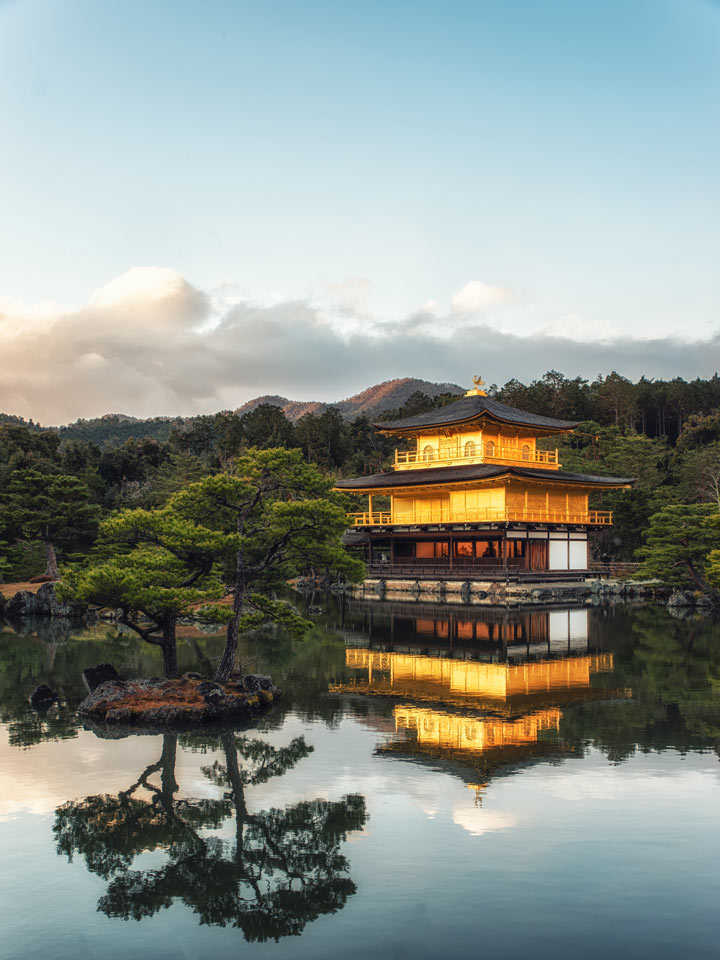
From Kitano Tenmangu, walk 15 minutes northwest to reach Kinkaku-ji.
Of all the UNESCO sites in Kyoto, it’s hard to beat Kinkaku-ji. Known as the Golden Pavilion, this Zen Buddhist temple was originally constructed in 1397 as a wealthy shogun’s retirement villa. The building you see today is actually a partial reconstruction, but that doesn’t make it any less magical!
Kinkaku-ji is surrounded by a large pond, making for mesmerizing reflections in the water. There’s also a lovely strolling garden and traditional tea house in the complex.
To reach Ginkaku-ji, take either the 102 Raku bus or the 204 local bus from Kinkakuji-michi to Ginkakuji-michi stop.
Near Kyoto’s eastern mountains lies Ginkaku-ji, a.k.a. the Silver Pavilion. Despite its nickname, you won’t find a hint of silver on its facade!
Ginkaku-ji’s official name is Higashiyama Jisho-ji,and it was intended to be a shiny silver version of Kinkaku-ji. Sadly, the project to cover the facade in silver leaf never happened. To this day, the temple remains a humble–albeit pretty–wooden structure.
Fortunately, Ginkaku-ji’s fantastic gardens, including one made of raked sand, work in harmony with the simple exterior. The combination of wood and greenery create a calming, zen-like atmosphere.
Philosopher’s Path
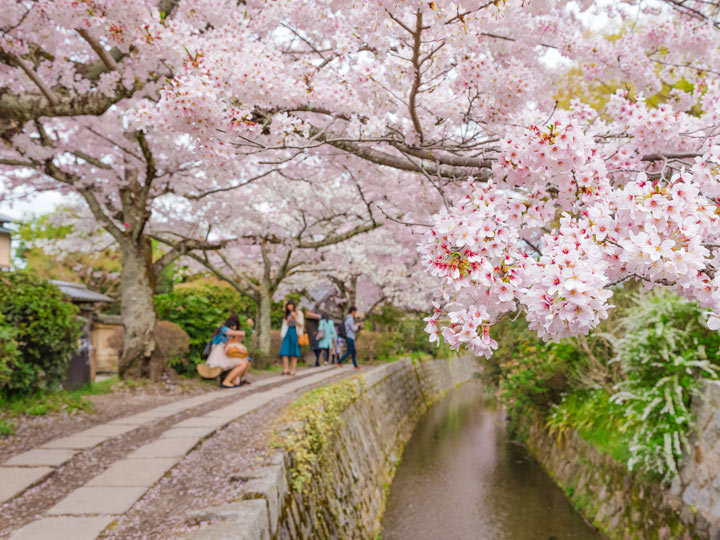
The northern entrance to the Philosopher’s Path is conveniently located a few minutes’ walk from Ginkaku-ji. This scenic footpath gets its name from Nishida Kitaro, the 20th century Japanese philosopher who (allegedly) walked the route for daily meditation.
You’ll find cute cafes, independent shops, and hundreds of cherry blossom trees lining the canal path.
It takes about 20 minutes to walk the entire 2km path. To keep this 2 day Kyoto itinerary on schedule, you can take around 45 minutes to shop, take photos, and stroll. Definitely pop into Suzuki Shofudo , an adorable papercraft shop with a frog mascot.
Once you reach the path’s southern exit, you’ll be just around the corner from one of my favorite temples in Kyoto: Eikan-do Zenrin-ji.
Eikan-do Zenrin-ji
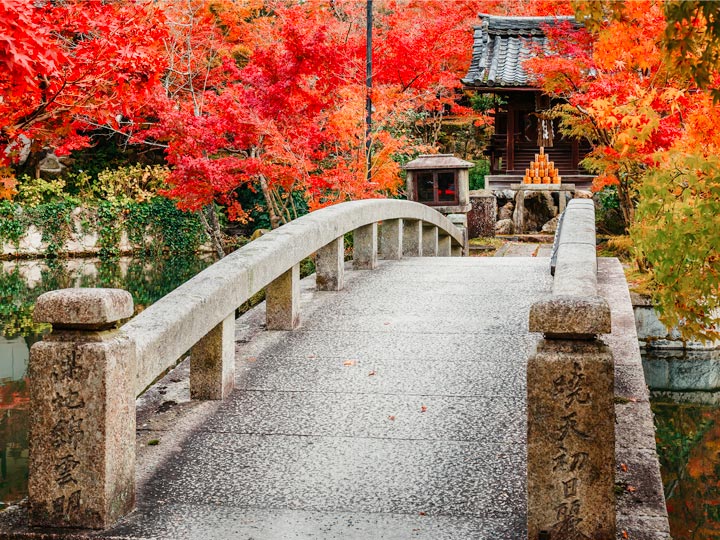
Eikan-do Zenrin-ji is easily one of Kyoto’s most beautiful temples, especially during the autumn season. People travel from all over the world to see the vibrant trees surrounding the vast Hojo Pond and stone bridge. If the line isn’t too long, climb the steps of the pagoda for stellar views of the complex.
From the temple exit, briefly walk south along the road to reach Nanzen-ji.
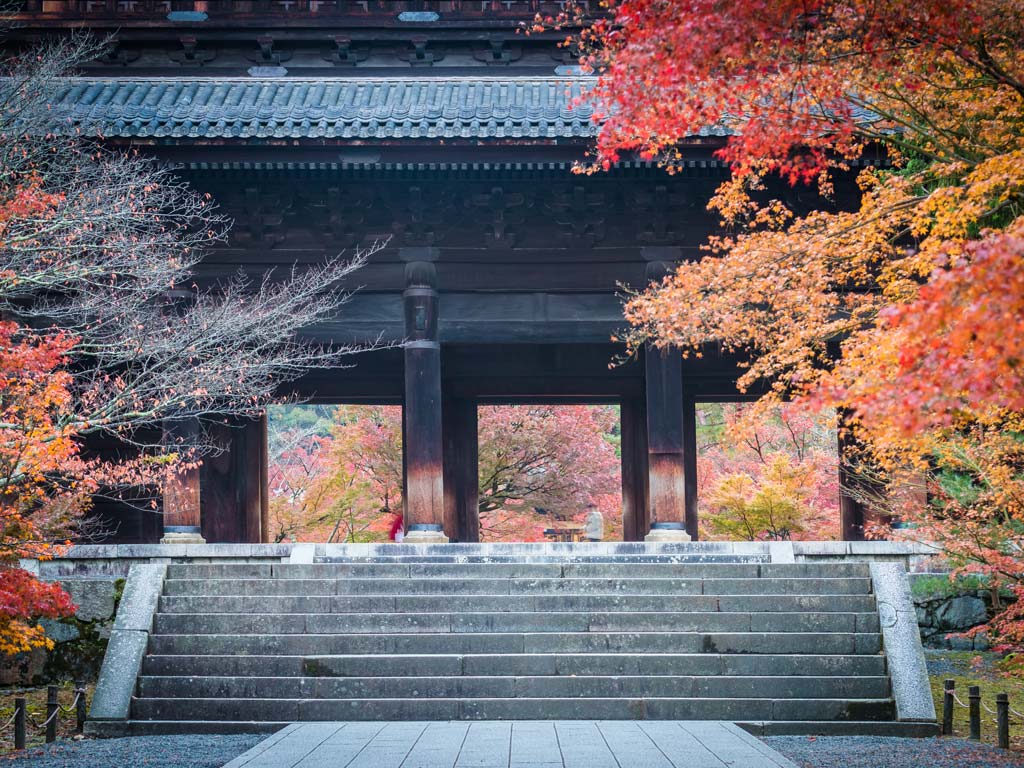
Nestled along the base of Kyoto’s Higashiyama mountains, Nanzen-ji is one of Japan’s most significant Buddhist temples. Thanks to its elevated location, the towering wooden temple gate offers lovely views, and the sprawling grounds and garden are a peaceful escape from the city.
Founded in the mid-13th century, Nanzen-ji started as a retirement villa for Emperor Kameyama. It was later converted into a Zen temple and expanded. Although the original buildings were destroyed during the 14th-16th century civil wars, the grounds were rebuilt and boast a number 500-year-old structures.
It’s free to explore the main grounds of Nanzen-ji (including the famous gate and brick aqueduct), which is all you’ll have time for during this busy 2 day Kyoto itinerary.
After exiting the temple grounds, walk west up Niomondori to the Okazaki Koen bus stop. From here, catch the 100 Rakuten bus to Kiyomizu-dera.
Kiyomizu-dera
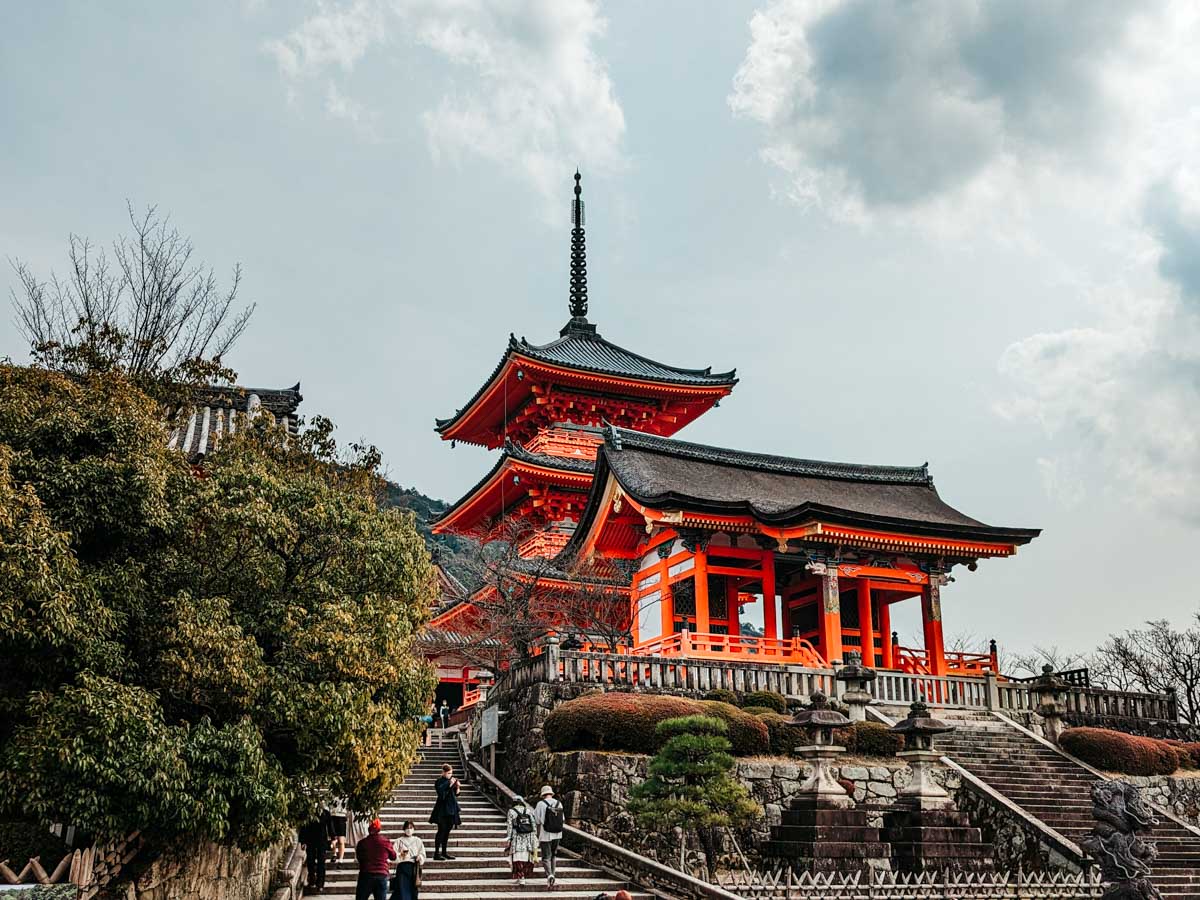
With a multi-story wooden hall and enormous observation deck, it’s no wonder Kiyomizu-dera is one of Kyoto’s top tourist attractions. The vast temple complex of buildings and gardens is set on a hill among a forest of bamboo and trees, which turn brilliant hues of red and gold during autumn.
Kiyomizu-dera is known as the “Pure Water Temple” thanks to the crystal clear Otowa waterfall nearby. Other highlights include the 3-story Koyasu Pagoda and the various smaller halls and shrines whose purposes range from matchmaking to safe travel.
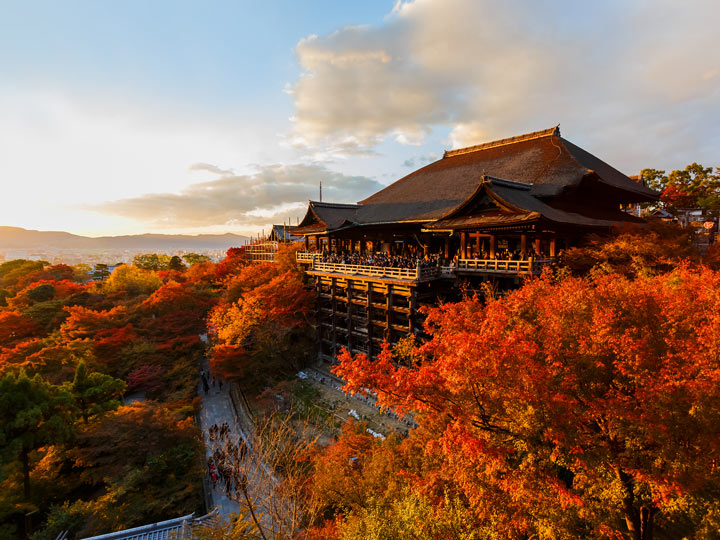
There are multiple ways to reach the next destination, Rengeoin Sanjusangendo, from Kiyomizu-dera. You could walk the entire 25 minute journey, or walk about 12 minutes to Gojozaka bus stop and catch the 100, 202, or 206 bus. The 100 and 206 stop right across the street, while the 202 stops a block away at Higashiyama Nanajo.
Rengeoin Sanjusangendo
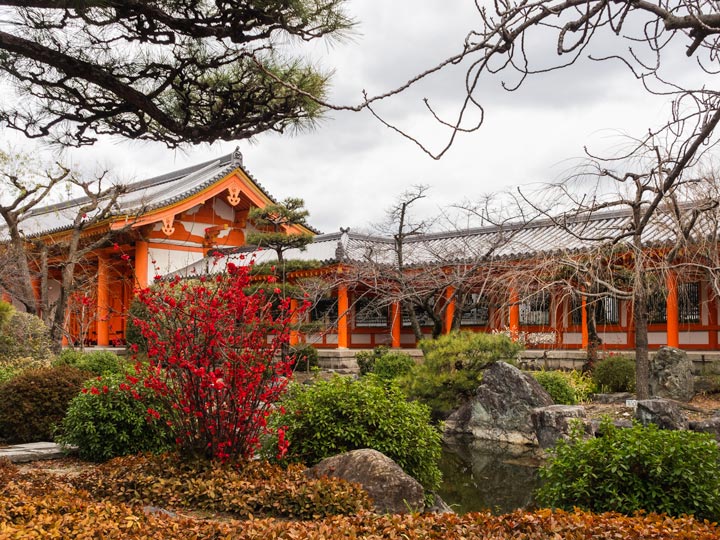
If you were hoping to be wowed by Kyoto’s history and culture, look no further than Rengeoin Sanjusangendo.
Founded in 1164, this Buddhist temple’s massive main hall contains a jaw-dropping 1,001 gold statues of the Goddess Kannon arranged in rows. Various displays detail the evolution of Buddhism in Japan, and many Kyoto natives consider this one of the city’s most important cultural sites.
Before you depart, take a few minutes to enjoy the beautiful grounds, which include a small garden and an elegant vermillion and white outer wall.
To reach Fushimi Inari from here, you have two equally fast options. Either walk 8 minutes to Shichijo Station and take the Keihan Main Line to Fushimi Inari Station, or walk 12 minutes to Tofokuji Station and take the Nara local line to Inari Station (free for JR pass holders). Both options will get you there in 20 minutes including walk time.
Fushimi Inari Shrine
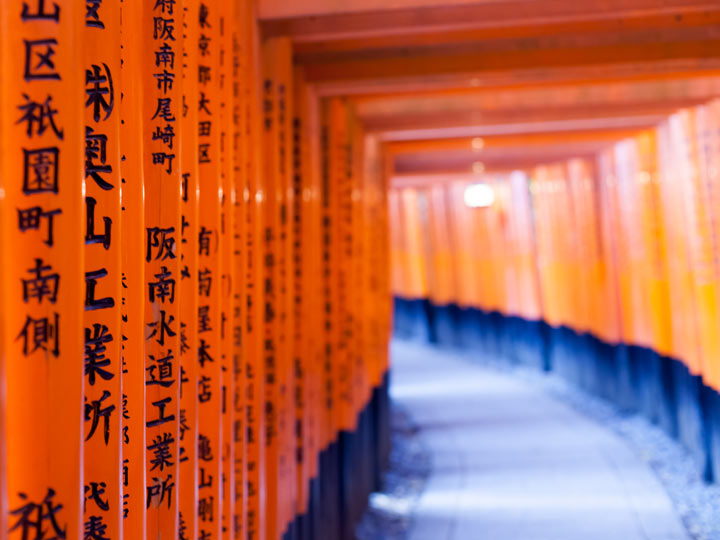
There’s a reason I saved Fushimi Inari Taisha for last: it’s one of Kyoto’s most crowded sightseeing spots! Fortunately, arriving in the evening means avoiding most of the tourist groups that clog the path through the seemingly endless 10,000 torii gates.
The vermilion gates line the path up Mount Inari, linking the main Shinto shrine at the base to smaller ones further up the mountain. As you journey up the mountain, you’ll spot plenty of fox statues that represent the god Inari, protector of rice growing.
It takes around three hours to walk all the way to the top and back, and it gets tiring quickly. Luckily, there are multiple landing spots where you can easily turn around and descend back to the train station if you can’t carry on due to fatigue or fading daylight.
Save me for later!
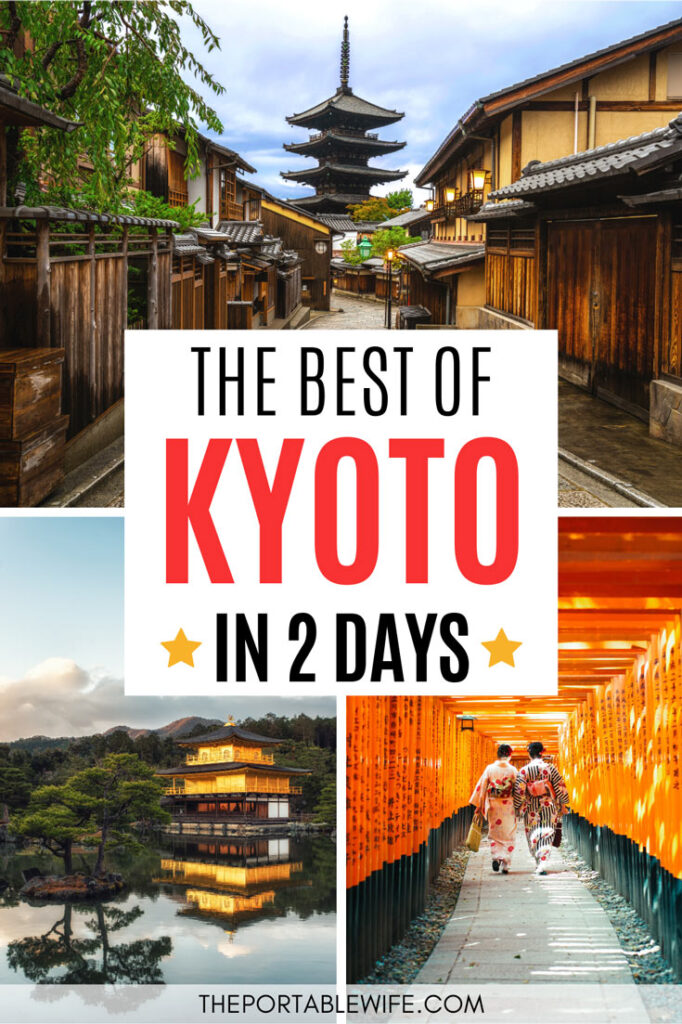
Day 2: Bamboo, Castles, and Geisha
Exploring Arashiyama Like a Local
Kyoto’s Arashiyama district is one of the city’s most unique and mesmerizing destinations. Unfortunately it’s also packed with tourists!
If you want to navigate the area’s bamboo forest, temples, and restaurants like a pro, I highly recommend booking a local guide. This insider’s tour of Arashiyama will take you through the district’s highlights, including a traditional Kyoto-style lunch.
Book your small-group walking tour of Arashiyama here!
Arashiyama Bamboo Forest
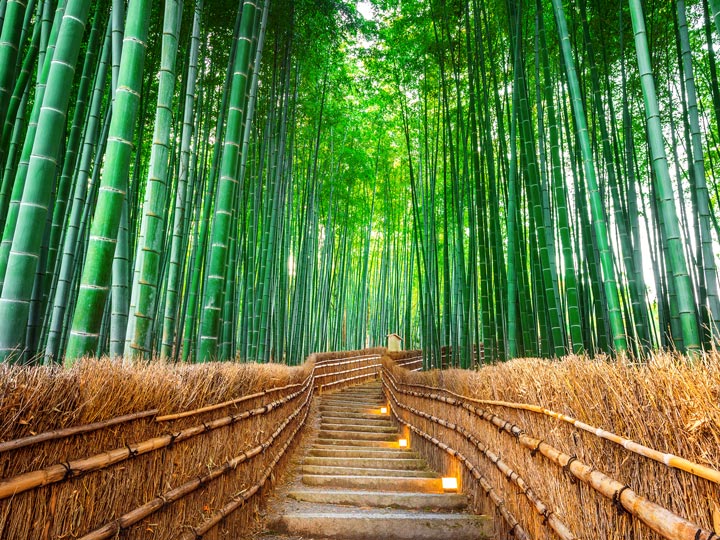
Start your second day in Kyoto bright and early with a stroll through Arashiyama Bamboo Grove. The 30+ meter stalks gently sway and filter the sunlight as you pass through, making for an other-worldly experience. If you don’t want crushing crowds to kill the mood, try to arrive by 9am.
To get to Arashiyama, you can take the JR San-In line to Saga-Arashiyama Station or the Randen Local line to Arashiyama Station.
Arashiyama District
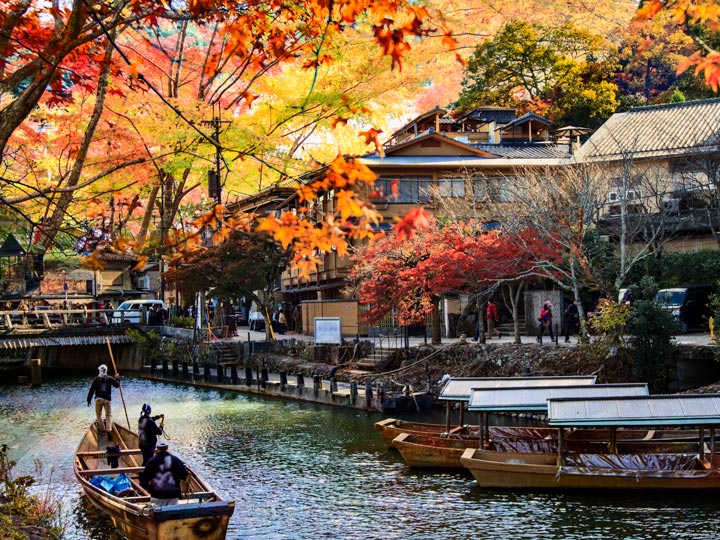
There’s more to Arashiyama district than the iconic bamboo grove! Adjacent to the forest lies Tenryuji Temple, a renowned complex of ancient buildings with an elegant Japanese garden. It’s a gorgeous place year-round, but it’s even more impressive when decked out in fall foliage.
If your visit falls on a weekend, you can pay to enter the Hatto hall and see the famous Cloud Dragon painting.
From Tenryuji, head south towards the Katsura River and cross the Togetsu-kyō Bridge . Keep an eye out for the traditional wooden boats that ferry sightseers along the scenic riverbank.
Just a few minutes’ walk from the river, you’ll find the entrance to Arashiyama Monkey Park Iwatayama. This mountainside area is home to hundreds of Japanese macaques, and the overlook point at the top has incredible panoramic views over Kyoto. You’ll need around 30 minutes to reach the overlook, so plan accordingly.
When you’re ready to leave Arashiyama, walk back to Saga-Arashiyama Station and take the JR San-in Line to Nijo Station.
Nijo Castle
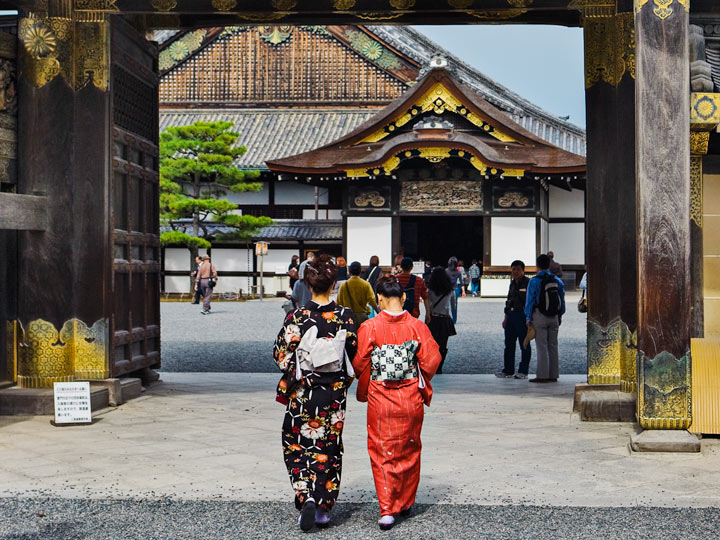
Not to be confused with Kyoto Imperial Palace, Nijo Castle was the home of the Ieyasu shogunate. The shogunate’s former power and wealth is on full display here, with intricate carvings and colorfully-painted details along the huge wooden gates and buildings.
Inside the walls, you can tour the elegant Ninomaru Palace and grounds and marvel at the traditional Japanese architecture.
Take the Tozai subway line from Nijojo-mae Station to Kyoto Shiyakusho-mae Station to reach Pontocho.
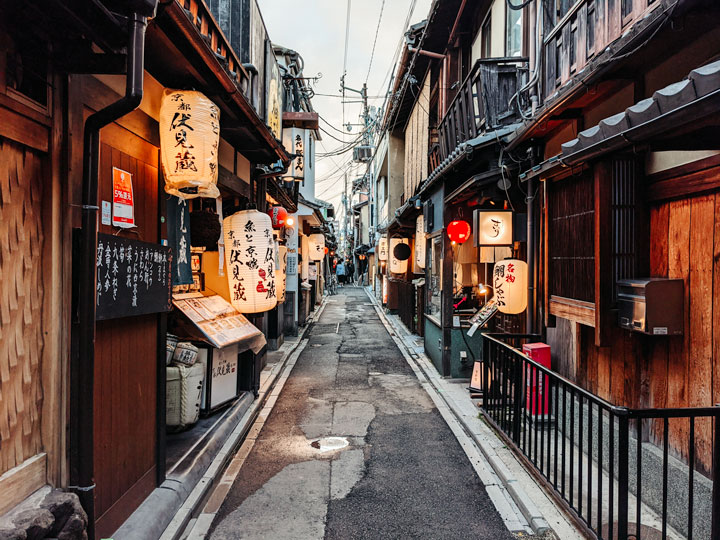
Pontocho is among my favorite places in the entire world. This long, lantern-filled alley is lined with old-fashioned wooden facades and mysterious entrances to dark narrow corridors. The atmosphere is distinctly Japanese and reminiscent of a Studio Ghibli film.
Pontocho is full of small restaurants ranging from izakaya to sushi shops to okonomiyaki grills. It’s a great place to grab dinner before heading to Gion, where food is a fair bit pricier.
To reach Gion, simply walk across the large bridge near Gion-Shijo Station.
Gion District
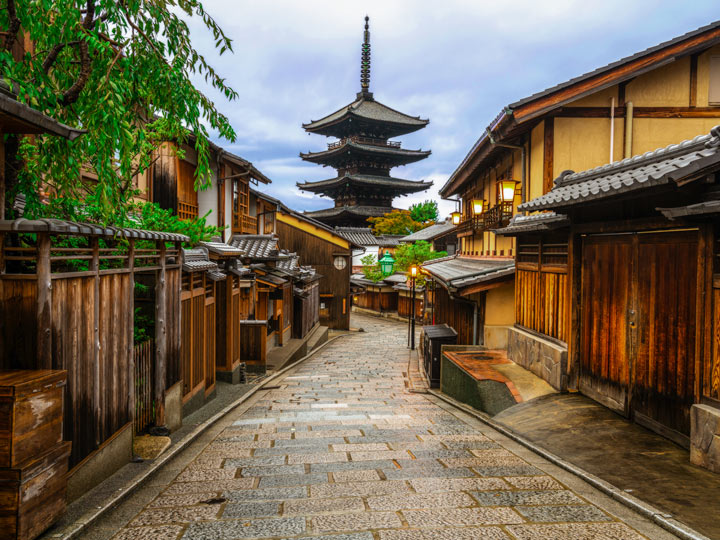
By now it should be growing dark, which makes it the ideal time for a stroll through Gion. Known as Kyoto’s geisha district, this area is a maze of traditional shops, historic alleys, and elegant inns and restaurants.
If you’re lucky, you might even catch a glimpse of a geisha or maiko (apprentice) on their way to an appointment during your Kyoto 2 day itinerary (but please appreciate them from a distance).
Enjoying Gion at Night
Gion holds a ton of secrets and charms, and the best way to discover them (and spot a few geisha along the way!) is on a walking tour with a local.
Book your evening walking tour of Gion here!
Begin by walking up Hanamikoji, Gion’s main street. Each side is lined with hundreds of shops and street food counters operating under the iconic sakura lanterns. The numerous souvenir shops are perfect for picking up traditional wagashi –Japanese sweets–to bring back home ( Kagizen Yoshifusa is my favorite wagashi shop).
At the end of Hanamikoji stands Yasaka Shrine , one of the most culturally significant shrines in Japan. Every July, the Gion Matsuri festival begins here, with an ornate deity float ( mikoshi ) parading through the gate and around the city. They illuminate the shrine’s front gate at night, and it glows beautifully at the heart of Gion.
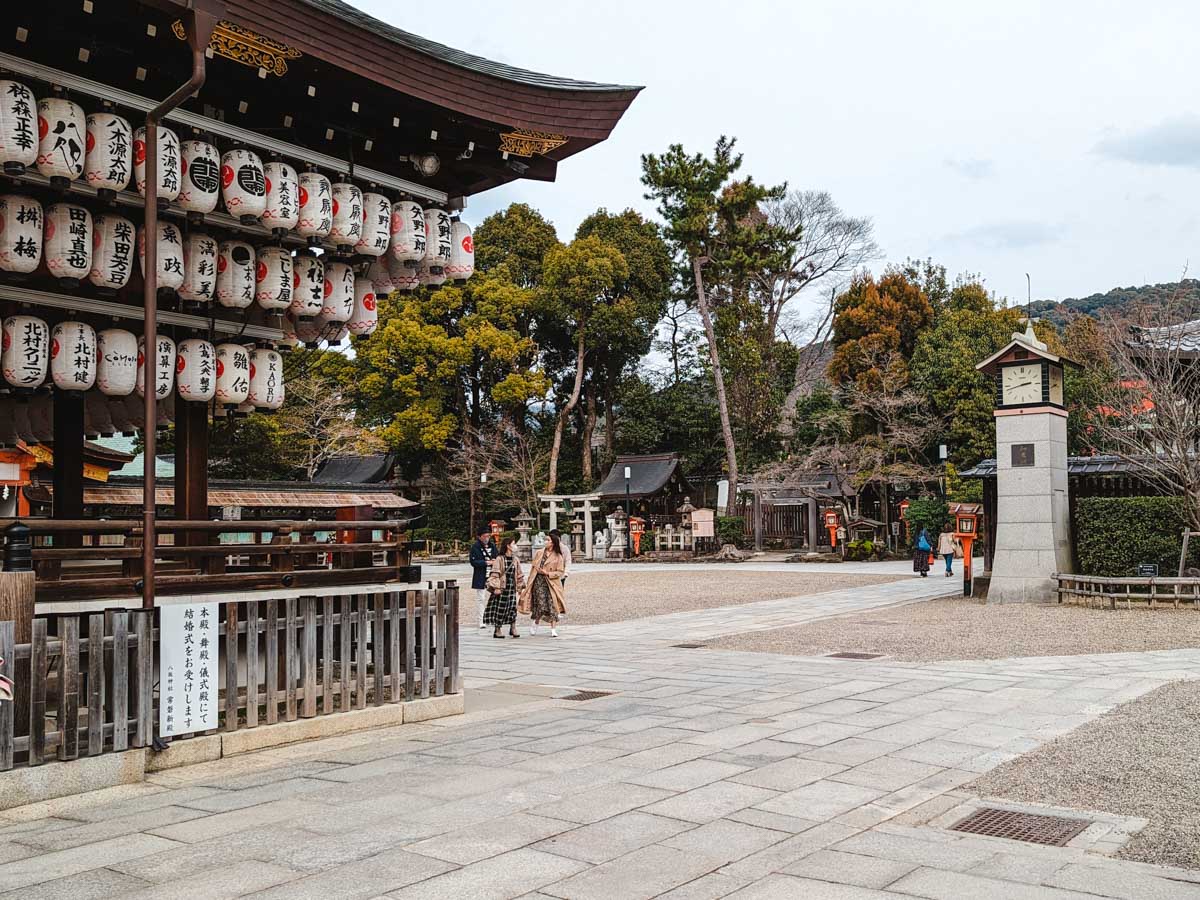
Meander south towards Kodai-ji Temple , where you can explore the lit up grounds and mini bamboo forest. They also run a three minute light and sound show after dark in the sand garden area.
Right outside of Kodai-ji you’ll find Ishibe-koji alley, one of the prettiest historic streets in Gion. And for more picturesque paths, continue south to reach Ninenzaka and Sanenzaka . These lantern-lit streets offer amazing views of Kiyomizu’s pagoda in the distance.
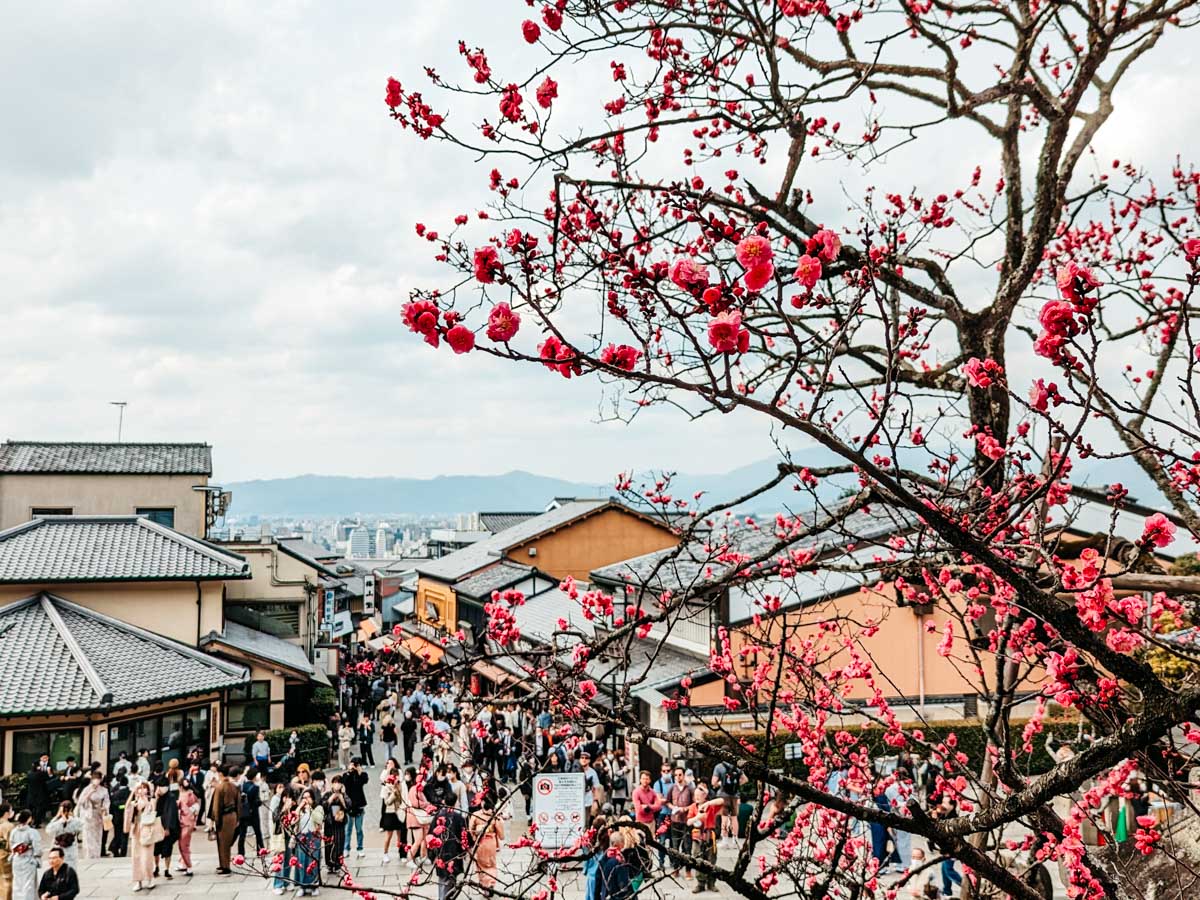
And that’s a wrap! Hopefully you’ll dream sweet dreams after an action-packed two days in Kyoto.
Map of 2 Day Kyoto Itinerary
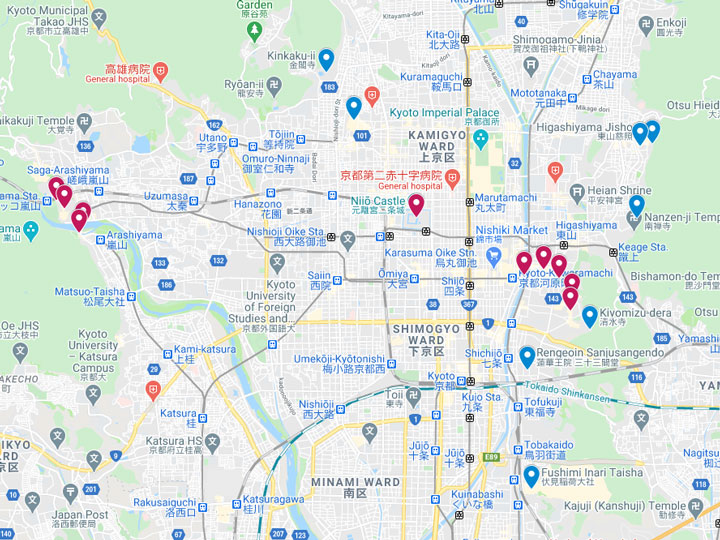
Click here to access the full interactive map!
Other Places to Visit Near Kyoto
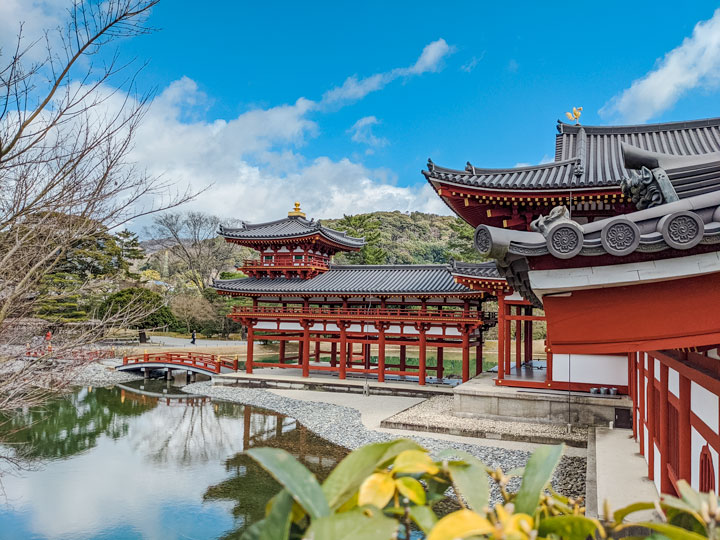
Have more time in Japan? Here are some additional places to check out before or after this Kyoto two day itinerary:
- Lake Biwa Day Trip: Water, Mountains, and Sacred Sites
- Nara Day Trip Itinerary: Japan’s Sacred Deer City
- 12 Easy Day Trips from Kyoto
- Kanazawa Day Trip: Japan’s Samurai City
- The Best Places to Visit Between Tokyo and Kyoto
My favorite Japan travel books
These books are full of fun and practical information about traveling in Japan (I own all three!):
- Super Cheap Japan: Budget Travel in Tokyo, Kyoto, Osaka, Nara, Hiroshima and Surrounding Areas
- Cool Japan Guide: Fun in the Land of Manga, Lucky Cats and Ramen
- Lonely Planet Japan
5 thoughts on “Kyoto 2 Day Itinerary: A Super Efficient Guide”
Thank you for a very clear description of places to visit and the useful hints and tips.
I better starting saving for this trip . ( Lol ).
My husband has work in Tokyo Wednesday through Friday. Then we have all day Saturday and Sunday before we catch an overnight flight to Sydney. I was thinking we should do a day trip from Tokyo to Nikko on Saturday then explore Tokyo together on Sunday. Have you ever visited Nikko? Or do you think it would be better to do this two day trip to Kyoto? There’s just so much to see and do and I’m having a hard time narrowing it down! I would love your thoughts as I don’t have any friends or family who have ever been to Japan so I can’t get their advice…
As much as I love Kyoto, I would have to recommend the day trip to Nikko and exploring Tokyo together given your timeline. Even if you were take the Nozomi shinkansen (the fastest train) from Tokyo to Kyoto, you’d still need over 2 hours of travel time each way, and that would really eat into your sightseeing time. Best to save Kyoto for when you have a full two days (or ideally longer)!
Thanks very much for this information. We had a short trip to Kyoto but followed your itinerary and felt like we saw so much
Thank you so much for this- I managed to tick off everything in 2 days and this itinerary is very practical and well thought of!
Leave a Comment Cancel reply
This site uses Akismet to reduce spam. Learn how your comment data is processed .

The Ultimate Kyoto 3 to 4 Days Itinerary

After taking three trips to Kyoto, I’m going to share the ultimate Kyoto itinerary for 3-4 days. Kyoto is one of my personal favorite places in Japan. This ultimate Kyoto itinerary will help you plan your time throughout Japan’s incredible city.
Kyoto has this charming, old-world feel to it. The architecture is stunning, lots of green spaces to enjoy, and the culinary world there is vibrant. I find myself thinking back to fond memories from all of our Kyoto trips over the years.

When it comes to planning your Kyoto itinerary, there are a few ways to go about it. I almost always bundle regions together to help cut down on transport. I also save a few of the popular spots for ideal visiting times (think early) to make the trip feel better as well.

Kyoto is super popular to visit so know that the earlier you rise, the better chances you’ll have for fewer crowds. There is so much to enjoy there, I’d aim for 4 days in Kyoto if you can. I’ve broken down my itinerary by day, so whether you’re there for 3 or 4 days, this will work perfectly. You could even take a day or two of it if you like.
Read on for everything you need to know to plan your ultimate Kyoto 3 to 4 day itinerary.
Short on Time? Here Are My Top Picks for the Best Hotels in Kyoto:
- Kyoto Granbell Hotel , for the best price and location
- Ritz-Carlton Kyoto , for the best luxury hotel
For more helpful guides on Kyoto read my:
- Travel Guide to Kyoto
- Where to Stay in Kyoto Guide
- Things to in Kyoto Guide
- Kyoto Coffee Shop Guide
- Local Artisan Shop Kyoto Guide
- 20 Best Restaurants in Kyoto
- Best Temples in Kyoto Guide
Kyoto Travel Tips Before You Arrive

After my last two recent trips, I’ve narrowed down some do’s and don’ts that you’ll want to consider before you arrive in Kyoto. This section gives an overview on the things you should start planning for now before you book the trip.
Consider Booking Your Trip Over a Weekend
One of the biggest mistakes I see is people showing up on Mondays to find that many things are closed down for the day. I always recommend coming in later in the week and over a weekend. It will be ensure that most things are open.
Make Sure Your Google Maps Are Downloaded Offline
Navigating in Japan can be a bit tough but I find having Google Maps downloaded offline ahead of time super helpful. It will mean you can navigate while in the metro, and not have to worry about having service at all times.
Pre-Purchase Your JR Rail Pass
The JR Rail Pass can be used on several lines in Kyoto, which is why we always opt for one. You have to purchase this BEFORE you arrive to Japan. Keep this in mind for when you begin to plan your trip and your time in Kyoto. Purchase your JR Rail Pass here .
For a more in-depth guide on getting around Japan, read Transportation Tips for Japan .
Get a Prepaid SIM Card
I always pop in a Prepaid SIM Card in before arriving to Japan. It’s much easier now to pre-purchase SIM cards rather than having to do it locally at the 7 Eleven. I recommend pre-purchasing this highly reviewed data card on Amazon .
Where to Stay in Kyoto

When it comes to where to stay in Kyoto , there are a few strategies to deciding. I find that for visiting Kyoto the best option is to be somewhere close to downtown Kyoto, within walking distance to some popular sights. Think near Pontocho Alley and Nishiki Market or just across the river. I always like to be close to a metro stop as well. This is super helpful for getting around the greater part of the city.
Throughout my trips, I’ve stayed at:
Best Location ($): Kyoto Granbell Hotel
This is some great bang for your buck in terms of being right in the heart of it and not paying super high prices. It’s mid-range by Japan standards for hotels, incredible design, and feels very intimate. This is the hotel I recommend to everyone for Kyoto.
Best Luxury Hotel ($$$): Ritz-Carlton Kyoto
This was a phenomenal stay and the service here was over the top. It’s just outside of downtown Kyoto, so you get the neighborhood feel without being in the chaos of it all.
Other Kyoto Hotels to Consider:
- The Junei Hotel Kyoto Imperial Palace West , for the best central Kyoto hotel
- Four Seasons Kyoto , for the best Southern Higashiyama hotel
- Ryokan Inn Yoshida-sanso , for the best Northern Higashiyama hotel
- Hotel Kanra , for the best Kyoto Station hotel
- Suiran , for the best Arashiyama hotel
Kyoto Itinerary 4 Days

Day 1: Arriving and Downtown Kyoto
Kyoto station.
As you arrive in Kyoto, likely from Tokyo, you’re just getting there and will likely need a lunch. If I can make one suggestion, it’s to eat lunch right there outside of the train station at Honke Daiichi-Asahi for ramen. Bring your luggage with you, walk over, as this will be the closest you’ll ever be during the Kyoto trip. It is hands down some of the best ramen I’ve had in Japan, and we make it our first meal every trip to Kyoto.
From there, I typically hop in a taxi as I find it easier than having to transfer but of course there are several trains to get you around Kyoto.
Downtown Kyoto

To me, there is no better way to kick off a new city than with its food market. I always head straight to Nishiki Market to get into the thick of it. There’s a lot to love there, from food stalls to shops—one of which I go to every trip. I pop into Aritsugu Nishiki Market, the famous knife shop, for a custom-engraved Japanese knife. I budget about $150-300 every trip just for a knife from here.

After strolling through the market, head to WEEKENDERS COFFEE TOMINOKOJI for one of the best coffee shops in town. This part of downtown is great for a casual stroll to pop into boutiques like my favorite Kochosai Kosuga and Wakabaya . As you continue on, make your way to the Kasoi River.

The Kasoi River, particularly at sunset, it special. Everyone gathers around the river at the end of the day as the restaurants start to come alive. Go for a walk through Pontocho Alley , a must see while in Kyoto. But don’t stop there for food — I have somewhere better.

Continue on to Chao Chao Sanjo Kiyamachi — the best gyoza in town. I’ve eaten here at least twice per trip, it’s so stinking good and worth the wait. The cheese filled gyoza will live rent free in my mind for many years.
Day 2: Arashiyama, Philosopher’s Path, & Other Sights

You’ve probably seen the Arashiyama Bamboo Grove at least once and have plans to go — it’s worth it, but do know that the earlier the rise the better. I always like to take the first train out to Arashiyama which is usually around 7 am. You’ll have some time to yourself before the crowds arrive, it’s great to go for a walk and enjoy the serenity of the bamboo grove.

After, make your way over to the Katsura River, through Arashiyama Park Kameyama Area . The direction you’re headed is to % ARABICA Kyoto Arashiyama for my personal favorite coffee shop. It doesn’t open until 9 am, so I usually like to cross the Togetsukyo Bridge for the views and to kill time.

I like to visit the Kinkaku-ji temple also known as the Golden Pavilion on this day as I am already on the outskirts of town anyways. It’s easiest to do these portions by taxi as the public transport can get a bit tricky. The Golden Pavilion is well worth a visit if you haven’t been, so allocate about an hour or so to see it.
Philosopher’s Path

From the Golden Pavilion, grab a taxi over to where the Philosopher’s Path (Tetsugaku No Michi) begins to eat lunch at Omen Ginkaku-ji . This is a strictly udon restaurant, one of my favorites in the region for a traditional meal. I adore this restaurant and they have traditional seats.

After, make your way down the Philosopher’s Path, a cherry-tree-lined path that opened in 1890. The cherry blossoms here are absolutely beautiful when in season (cherry blossom season is very special in Kyoto). Today, several boutiques and shops are on this path, and it is a quiet space to enjoy. At the end of the path, I love to walk up to Hōnenin Temple , my personal favorite in the city. It’s a stunning 17th-century Buddhist temple with the most lovely gardens.
Gion/Hanamikoji Street

You’ll likely make your way back towards the heart of town as you’ve done so much today. Gion is one the neighborhoods I like to stroll around come night time. This last trip we ate at 太郎吉(Tarokich) which was traditional yakitori. It had to be one of our better meals yet in Kyoto and we totally found it by surprise. And remember, Hanamikoji Street is the best chances of seeing a geisha at sunset — well worth a stroll here.
Day 3: Historic Kyoto and Temples

Make your way early to Sannenzaka to enjoy the stillness before the masses arrive. This stone-paved traditional Japanese street has to be the most famous and for good reason — it’s absolutely stunning. Arrive early and get it all to yourself. After, there is % ARABICA Kyoto Higashiyama or even the famous Starbucks Coffee – Kyoto Nineizaka Yasaka Chaya , one of the coolest Starbucks I have ever been to.

After breakfast, stroll your way through Ninenzaka , a street with traditional ryokans that line the street. One shop I come into every trip is Kanaamitsuji for handmade houseware from twined metals – think stunning tea strainers and such. The shop’s name is Kōdaiji Temple Ichinenzaka Kanaamitsuji and is in the heart of this neighborhood.
While over here, pop into a few temples like Kōdaiji Temple , Yasaka Shrine , and Kenninji Temple . Each are very unique. I’d recommend having 2-3 hours in total to do all of these at a leisurely pace. Do a few before lunch and a few after.

Now for lunch — book in advance at a “tempura” only restaurant called Tempura Endo Yasaka (North) . It’s a pre-fixe meal and one of the best meals I’ve had in Japan in the last 10 years. It is so fantastic, so much to love, and it will take about 2 hours to do.
Kiyomizu-dera

The famous Kiyomizu-dera temple. It’s a temple you can’t miss and no matter how busy, is always well worth a visit. I’m big into arriving the last two hours (4-6pm). I love the end of day light here over the city of Kyoto, and the crowds tend to slow down. You could spend a few hours here as it is so large. It is part of the Historic Monuments of Ancient Kyoto UNESCO World Heritage Site , so don’t miss it when here.

After a very big lunch, there are a few ways to do dinner. I have a handful of restaurants to recommend, depending on how far you want to walk, but remember, taxis are easy if you’ve done too much walking. The first spot I always recommend is Monk . It’s one of the best meals in town, very intimate and a hard reservation to get.
The other restaurant I love is Wajoryomen Sugari — a very busy ramen shop that has the most amazing fish broths in town. It’s well worth the wait, but be aware, it could be up to an hour. Sojiki Nakahigashi and LURRA° are on my list for the next trip.
Day 4: Fushimi Inari and Beyond
Fushimi inari taisha.

Begin the day with the earliest train out to get to Fushimi Inari Taisha . It’s the famous red-painted torii gates at the Shinto Shrine. I’d block in at least 2 hours to make the climb and soak it all in before the crowds. Do bring water and a small snack as it’s quite the climb. On the last two trips, I’ve stopped into Vermillion Cafe for breakfast. (If you arrive early in the morning, you’ll have fewer crowds as well.)
Tōfuku-ji Temple

While on this side of town, walk over to Tōfuku-ji Temple for the stunning famous zen gardens. The fall foliage is particularly spectacular here so keep that in mind if you time it right. The temple itself maybe takes an hour to see.
Free Afternoon
There is always more sights, tours, and things to do in Kyoto that you can do. I find that blocking an afternoon to revisit and stumble upon something is my favorite. I intentionally keep this afternoon open. From the morning, you could easily day trip down to Nara if you wanted to as well, a great combination since you’re already in southern Kyoto.
More Time? Take A Day Trip
I don’t normally recommend Nara as part of a first-time itinerary to Kyoto as there is so many other wonderful things to do there. So if you find yourself looking for a day trip to a nearby city, the first one is Nara. It’s home to beautiful temples, the famous bowing deers, and lots more. From Kyoto, it’s about a 45 minute direct train. Consider joining a half day walking tour to Nara or a full day trip to Nara and Kyoto .
Known for green tea and stunning temples (home to Byodo-in Temple), this is one to add to for historic charm and iconic sights. It’s not visited as much, so it could be a good option to consider. This full day tour covers both Uji and Nara.
Kurama and Kibune
These pair of historic villages under an hour away from Kyoto are another great choice.
Other Things to Consider Adding to Your Itinerary
- Kyoto Gion Night Walk – Small Group Guided Tour
- Bike Tour Exploring North Kyoto plus Lunch
- 3 Hours Kyoto Insider Sake Experience
- Top-Selling Kyoto 1-Day Bus Tour
- Kyoto Night Foodie Tour
- Hidden Kyoto E-Biking tour
- Ramen Cooking Class at Ramen Factory in Kyoto
More Helpful Japan Posts
- The Ultimate Two Weeks in Japan Itinerary: Where to Visit
- Top Tips Before Visiting Japan
- The Alternative Guide to Tokyo
- Visiting the Kiso Valley
- The Ultimate Guide to Kyoto
Save This Post for Later on Pinterest

PS — Are You Booking a Trip Soon? Use My Booking Checklist!
These are the sites I use most to book my own trips. Using the links below is a great way to support Bon Traveler’s travel journalism at no extra cost to you . If you need help organizing your itinerary, get my free travel itinerary template here .
1. Book Your Flights
Use Skyscanner to find the best flights. It searches 100s of airlines and websites across the globe to ensure you’re not missing out on any route options or deals.
2. Book Your Accommodations
Use Booking.com for hotels and guest houses. They have the biggest inventory and consistently offer the best rates.
3. Book Your Tours & Experiences
Use Viator or Get Your Guide to find the best tours and experiences. They are my favorite tour search engines. I always check both as their inventory varies depending on the destination.
4. Book Your Car
Use Discover Cars or Rentalcars.com to find the best car rental deals. I recommend comparing rental agency reviews on Google to ensure you are booking with the best company in that destination, as the reviews are often more accurate than the car rental search engines.
5. Don’t Forget Airport Lounge Access
Get a Priority Pass membership to gain access to 1,400+ VIP lounges and airport experiences worldwide. The Priority Pass app is the first thing I check when I have a layover. I’ve been a member for over a decade, and having a comfortable place to relax before and between flights makes air travel so much more enjoyable.
6. Don’t Forget Travel Insurance
I never leave the country without travel insurance. It provides comprehensive protection in case anything goes wrong (ie. illness, injury, theft, and cancelations, etc.). I use it frequently for my travels to stay protected.
My favorite companies that offer the best coverage and rates are:
- World Nomads (best for all-around)
- Safety Wing (best for frequent travelers)
Xx, Jessica
Related Posts

The Ultimate Weekend Guide to Placerville, California

The Ultimate 10 Days in Portugal Itinerary
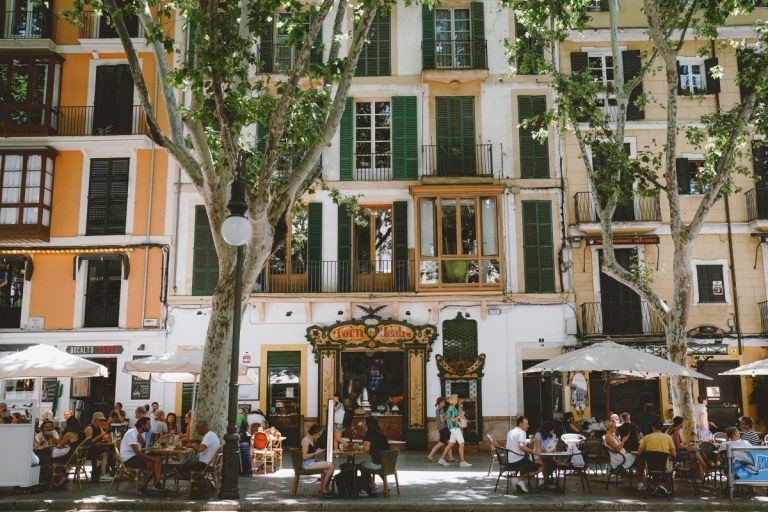
Best Things to Do in Palma de Mallorca: City Guide
Write a comment cancel reply.
Save my name, email, and website in this browser for the next time I comment.
- Cayman Islands
- Dominican Republic
- Puerto Rico
- South Dakota
- Washington DC
- Czech Republic
- Netherlands
- Switzerland
- French Polynesia
- Travel Tips
- Family Travel
- Accommodations
- Packing Lists
- Photography Tips
- Northern California Guide
- San Francisco
- Lightroom Presets
- Rent Our Home For Photoshoots
- California Map
Type above and press Enter to search. Press Esc to cancel.

The BEST Kyoto 2-day itinerary for first-timers (2024 edition)
By: Author Sylvia
Posted on Last updated: April 19, 2024
How to spend 2 days in Kyoto?
For most travelers, Kyoto is one of the highlights of their Japan trip.
We spent 3 days in this culture-rich city and we still couldn’t check everything off our list.
Knowing that not everybody has the luxury to reserve 3 days just for Kyoto, after all, there are so many other things to see and do in Japan, we created this Kyoto 2-day itinerary to get the best out of a 2-day visit to the city.
We recommend staying at least two days in Kyoto to soak up the mystic atmosphere in this enchanting city.
That’s why we compiled this super-efficient detailed Kyoto itinerary for first-timers that will show you most of the highlights and must-see temples and shrines in as little time as possible.
We also recommend the best time to visit Kyoto, the best way to get in and around Kyoto and a couple of good hotels in Kyoto. So keep on reading.
There is a really good chance that this post contains affiliate links. If you click one of them, we may receive a small commission (for which we are deeply grateful) at no extra cost to you.
Table of Contents
Japan Essentials
To find cheap flights to Osaka or Tokyo we recommend checking Momondo . That’s where we usually find the best deals.
A local SIM card or pocket WiFi device comes in handy. We have often used Google Maps to find our way around major cities. If you want to purchase a local SIM card, you can find our detailed post here. If you want to compare the different WiFI devices you can rent in Japan, click here.
Make sure you have travel insurance.
Kyoto Essentials
The JR Rail Pass is of limited use to travel around Kyoto as there are few JR lines within Kyoto’s city boundaries. The Kyoto-Osaka sightseeing pass is one of the best passes for tourists in Kyoto, certainly is you also plan a side-trip to Osaka.
If you plan on visiting other parts of the Kansai area such as Nara, Kobe, Himeji and Osaka and you don’t have a Japan Rail Pass, the JR West Pass could save you a few bucks.
If you have less time in Kyoto or just want to save some shoe leather, you can use the Hop-on Hop-off Sightseeing bus to rush you to the highlights.
An alternative is a guided tour. Half-day and full-day tours are available. Your host will guide you through Kyoto as a local and will show you as much as possible of the main highlights such as the Kiyomizu-dera Temple, Fushi Inari, Arashiyama and the Bamboo forest, the Golden Temple, and more all in one quick exciting day.
Below we share a small selection of nice hotels. If you don’t see anything you like you can check our full guide on the best places to stay. We also have a selection of nice Airbnb’s .
Kyoto travel tips
What is the best time to visit kyoto.
Kyoto can be visited all year round because the weather is quite moderate, similar to Osaka . Still, if you can, we recommend that you visit Kyoto in the spring (March-May) or fall (October-November) .
Read on to learn the pros and cons of each season if these two periods don’t work for you.
In spring everything starts to bloom and being in Kyoto during the cherry blossom (Sakura) period is an unforgettable experience.
Best sakura spots in Tokyo
The Sakura not only draws tourists from all over the world but also Japanese go crazy over this yearly event. At lunchtime and on weekends, they flock to the parks for picnics and selfies.
It was lovely to see the Sakura, but witnessing the enthusiasm of the Japanese really made our experience complete.
The Sakura blossoms are hard to predict. Depending on the weather the blossoms can appear as early as late March. The first blossoms appear in southern Japan and the colorful wave then gradually moves northwards across the land. The latest blossoms disappear somewhere around the end of April or sometimes as late as mid-May.
Keep in mind that spring is also the most touristy and therefore most expensive season.
Late April and early May also marks the “Golden Week” , a week with 4 Japanese holidays in which many Japanese take a local trip. That particular week can therefore be even busier and hotels may be booked up long in advance.
If this is your first visit to Japan, we recommend reading our useful tips before traveling to Japan.

The end of the golden week announces a less touristy period. The climate is still very enjoyable with many sunny days.
Fewer crowds mean a better experience and shorter queues at many of Kyoto’s top attractions.
“There is a whole world out there. Pack your backpack, your best friend and go.”
Until the end of June, it is still a perfect time to discover Kyoto. It’s warm but not hot.
Towards the end of June, the rainy season starts and it starts to become hot and humid. The rainy season usually goes from mid-June to late July.
While it usually does not rain every day we wouldn’t recommend visiting Kyoto during this period if you’re not used to a hot and humid climate.
Fall is another excellent period to visit Kyoto. In general, you will experience a mild climate.
The colorful autumn foliage makes the various parks dotted around Kyoto very photogenic although you have to head into the national parks or the mountains to fully appreciate the beauty of this season.
The autumn foliage attracts many tourists but the crowds are not nearly as massive as during the Sakura season.

Winter (December – February) in Kyoto is cold but not too cold to travel. It’s a great time to visit Kyoto if you don’t like the crowds.
Here you will find the best things to do in winter in Kyoto.
Like this article? Check out our ultimate Japan travel guide where you can find much more information about Kyoto and Japan.
How to get to Kyoto?
The nearest airport to Kyoto is Osaka. Osaka has 2 international airports , Kansai International Airport (KIX) and Osaka International Airport (better known as Itami; ITM).
How to find cheap tickets to Osaka
You can use Momondo and Skyscanner to search for cheap flights.
Both are flight aggregators that compare several hundreds of booking sites and give you an overview of the best flights and the cheapest sites to book them.
Momondo and Skyscanner are both very good at finding good deals, of the two, Momondo is probably the one with the most intuitive user interface.
Read our full review about 10 booking sites here.
Kansai International Airport
Kansai International Airport is Osaka’s international airport and lies about 37 kilometers southwest of downtown Osaka. It also serves some domestic flights from other parts of Japan.
It’s well connected to Osaka by train, limousine buses, and taxis.
Japan Rail Pass
If you have a Japan Rail Pass , the fastest, cheapest, and easiest way to get to Kyoto is with the JR Haruka airport express.
This airport express train is free for holders of a JR pass and the ride takes about 75 minutes.
If you don’t have a Japan Rail Pass, the fee is either 3,230 yen for reserved seats or 2,900 yen for unreserved seats.

Limousine bus
Limousine buses might be a better option if you have a lot of luggage or if you don’t have a Japan Rail Pass and are looking for a cheaper option than the JR Haruka airport express.
The buses run along three routes, stopping at popular hotels and destinations in Kyoto. Each bus costs about 2,800 yen but you can book them online at a discount .
The bus schedule and all the stops can be consulted from the page where you can buy the tickets.
Check prices and shedule: Limousine Bus Tickets
Klook is a trustworthy travel company headquartered in Hong Kong that teams up with local operators to offer all kinds of travel experiences. It can be compared to Viator or GetYourGuide. It was established in 2014 and has since grown rapidly through various strategic partnerships such as the one with Shangri-La. Because of the size of its operations, it is often capable of offering tours at significant discounts.
Osaka International Airport
Osaka International Airport or Itami is Osaka’s domestic airport. Despite its name, it handles no international flights. It lies about 11 kilometers north of central Osaka.
The best way to travel between the airport and Kyoto is with the Osaka Airport Limousine bus. The journey from the airport to Kyoto costs 1280 yen and takes about 55 minutes.
The perfect Osaka 2-day itinerary and what to do in Osaka at night.

The high-speed Shinkansen or “bullet train” provides the fastest transport service between Tokyo and Kyoto.
If you have a JR Pass , you can ride the Hikari Shinkansen at no additional cost. The journey from Tokyo Station to Kyoto station takes 2h40. The Nozomi Shinkansen is faster and rides more frequently but is not covered by your JR Pass.
You could also opt for the Kodama Shinkansen. It is also covered by the JR Pass. This would add an extra hour to your journey.
If you do not have a Japan Rail Pass then the fare will be 13,320 yen one way with an unreserved seat.
There are several easy and fast ways to get from Osaka to Kyoto by train. You can choose between several options depending on your location in Osaka and your destination in Kyoto.
Getting to Kyoto Station
Without a doubt the Shinkansen is is the fastest and most comfortable ride into Kyoto. You could consider this train if you have a Japan Rail Pass to cover the cost.
If you don’t have a JR pass, it’s better to opt for a cheaper alternative. The JR Kyoto line takes 23 minutes to reach Kyoto from the Shin-Osaka station. This train is just 10 minutes slower and the fare for this service is 570 yen, less than half the Shinkansen fare.
Getting to central Kyoto
From Yodoyabashi station in Osaka, the Limited Express train on the Keihan Main Line will get you to Sanjo Station in 55 minutes for 420 yen .
The Keihan Main line crosses Kyoto from south to north, passing through central Kyoto. Many stations are reasonably close to many of Kyoto’s most iconic sightseeing locations. This makes this line one of the most convenient for tourists.
The Kyoto-Osaka Sightseeing Pass allows free unlimited travel on the Keihan Railway
The cheapest route into central Kyoto is on the Hankyu Kyoto Main Line. The Limited Express trains run between Hankyu Umeda Station and Kawaramachi Station in central Kyoto in 44 minutes for just 400 yen .
This line also provides easy access to tourist attractions in western Kyoto.
As Keihan Railway and Hankyu Railway are private companies they are not covered by the Japan Rail Pass.

Kyoto money-saving tips
When traveling around Kyoto, you can choose from a variety of discount tickets. Here’s an overview of the best discount passes.
Kyoto-Osaka Sightseeing Pass for 1 or 2 days
With this pass, you can enjoy an unlimited number of rides on the Keihan Railway during the validity period of the pass.
The Keihan Railway has many stations reasonably close to many of Kyoto’s most iconic sightseeing locations such as the famous Fushimi-Inari Taisha Shrine, the Gion district, the Kiyomizu-Dera Temple, and Osaka Castle.
The pass also allows you to ride the Otokoyama Cable Line, these days known as the Keihan Cable Line, for free. This cable line takes you up the mountain to the Iwashimizu Hachimangu Shrine.
This shrine has the advantage of being not too touristy.
The top of the mountain also holds an observatory where you get a good view of the Yawata region, one of the outskirts of Kyoto.
A very cheap option if you plan on using public transportation a lot.
The pass comes with some coupons that you can use to get additional discounts, services, and gifts at several locations in the Osaka-Kyoto area
This pass is strictly only available to foreign tourists with short stay entry status. You will need to present your passport when you pick up your pass at the airport
Read more information or buy your pass here: 1-2 day Sightseeing Pass
Kyoto City bus Bus All-day Pass
This pass allows you to make an unlimited number of trips on the city buses for one day.
Beware that it is not valid for 24 hours from the moment of first use. It is valid on the day that you activate it. (you automatically activate it when you use it for the first time) So if your first ride is at 10 PM it will only be usable for 2 hours.
The pass covers pretty much the full Kyoto region. Here’s a detailed map of the covered region .
Adults: 700 yen/ Children (6-11 years): 350 yen
You can buy these passes from the ticket windows found in subway stations, for example in Kyoto station.
You can buy the pass in advance, the validity period will start when the pass is used for the first time. Click this link for more information .
To benefit from this pass you need to do at least 3 bus rides.
Kyoto city subway & bus pass
This pass allows you to make an unlimited number of trips on all the Kyoto subway lines and city Bus lines for one day. Certain Kyoto and Keihan buses are included as well.
The pass does not last 24 hours. The day pass is valid until midnight on the day it is first used.
JR’s coverage of Kyoto is not as good as it is in Osaka or Kyoto so this pass might be a welcome addition even if you have a JR pass.
You can always walk but you will quickly lose a lot of valuable time, especially if you have limited time to see all the sights.
One-day pass: Adults: 1,100 yen / Children ( 6-11 years): 550 yen
You can buy the pass in advance, the validity period will start when the pass is used for the first time.
The JR Rail Pass is of limited use to travel around Kyoto as there are few JR lines within Kyoto’s city boundaries.
If you didn’t activate your Japan Rail pass yet and you plan to do a lot of traveling by JR trains after you leave Kyoto, it might be smarter not to activate your pass until the morning you leave Kyoto (you can activate the pass at the main JR ticket office in Kyoto Station).
If you have more time you can use your JR Pass to do some side trips to Nara, Himeji, Hiroshima, Takayama, or Kanazawa.
JR also offers regional passes which may be a better option if you only visit the Kyoto region. Below is a short summary, we have another article with a complete overview of JR passes .
The Kansai area pass is the most popular pass. It covers Himeji, Nara, Kobe, Osaka, and Kyoto. This pass is also valid on the Haruka express so you can use this pass to get from the airport to the city.
The Kansai area pass is available for periods ranging from 1 day to 4 days. The other variants can only be bought for longer periods of at least 5 days.
Click here to get more information or to buy your JR West Pass: JR West Pass
To visit Hiroshima you would need the Kansai – Hiroshima pass.
Trips to Takayama and Kanazawa are included in the Kansai – Hokuriku pass.
Travel Insurance
Did you already think about travel insurance? Accidents happen when you least expect them.
Drawing up a travel insurance policy that covers theft, damage and all kinds of medical expenses may seem expensive at first but it can potentially save you a significant sum, significantly more than the small insurance fee.
The good news is that it’s never too late to get cover with HeyMondo and SafetyWing , you can even get their travel insurance online while you’re traveling.
Get a free quote:
Read our in-depth post with everything you need to know about Japan travel insurance.
Top things to do in Kyoto
Here is an overview of the best-organized tours in Kyoto.
An organized tour can save you a considerable amount of time in Kyoto. Kyoto’s public transportation is not as well organized and you can lose a lot of time getting from one attraction to another.
An organized tour saves you time and, moreover, the tour guide will enlighten you about the different sights you visit.
We partnered up with GetYourGuide for these activities. We love GetYourGuide because they’re flexible. Sometimes your plans change last minute and then you want to be able to cancel your tickets and get your money back.
We selected 4 excellent tours in Kyoto just for you.
Full-Day UNESCO and Historical Sites Tour

Some sights, like the Golden temple, are far from train and metro stations. The Kyoto bus and Kyoto city bus have fairly good coverage of the city but it takes some time to understand their network and the buses were usually very crowded. We skipped the buses and walked to the different sights, easily doing 20,000 steps every day.
This tour might be a good and comfortable alternative if you have less time. You will travel in a comfortable tour bus and visit most highlights such as Kiyomizu-dera Temple, Fushi Inari, Arashiyama and Bamboo forest, the Golden Temple, etc in just one day.
This is the perfect tour for those that have less time or reduced mobility or just don’t like to walk a lot.
More information and booking:
Full day tour
Tea Ceremony Experience

A tea ceremony is a centuries-old Japanese ritual. This ceremony is recommended if you want to learn more about this ritual and Japanese culture. You will get to experience the full ritual and not the more often offered shortened tourist version.
Highly recommended if you want to learn more about Japanese culture.
Note that this ceremony is not performed by a geisha.
Tea Ceremony
Kyoto Night Food Tour with 10-Course Dinner

This walking tour will take you around the historic Gion district where your guide will tell you many interesting stories along the way. At the end of the journey, you will enjoy a delicious 10-course Kaiseki, a traditional multi-course Japanese dinner, including the world’s smoothest sashimi, tofu, macha, dashi, tamagoyaki, and fresh seafood.
A Kaiseki dinner is something you must try at least once during your stay in Japan. Although it isn’t cheap it’s a unique experience while you are in Japan.
Kaiseki Course
Nishiki Market and Gion Food and Drinks Tour

This tour is for you if you absolutely want to taste some of Kyoto’s great street food but are reluctant to do so because you prefer to know what exactly you’re eating. Your guide will introduce you to “Kyoto’s kitchen”. You will have the opportunity to taste the local food and you will learn about Japanese culture as you gradually make your way towards the Gion district.
Hotels in Gion, Kyoto
Kyoto is Japan’s most popular tourist destination. More than 2000 hotels are spread out across the city but still, prices tend to inflate tremendously during the cherry blossom season and other popular tourist seasons.
To avoid disappointment it is best to book well in advance.
Here we share 3 hotels in or within walking distance of the Gion district.
Luxury hotel
The Ritz Carlton Kyoto Hotel

The Ritz Carlton Kyoto is at a great location, along the river in the center of town, within walking distance to the Gion area and a lot of other attractions. Spacious, beautifully decorated rooms and a large swimming pool. The great attention to detail separates this hotel from others.
Booking.com
Premium comfortable hotel
Kyoto granbell hotel.

Designed generously with spacious rooms, onsen in an inner Japanese garden, a specialty restaurant, and a well-stocked bar, Kyoto Granbell Hotel is swanky and perfect for the sophisticated.
The rooms here come equipped with a flat-screen TV, an AC, a sofa, a refrigerator, and a private bathroom. Sample Japanese dishes or enjoy homestyle western food during the buffet breakfast.
The hotel is perfectly located for those who want to explore the Gion district, Yasaka Shrine, and Shinto shrine.
Comfortable hotel
Royal park hotel kyoto.

The Royal Park Hotel Kyoto is a good choice for those who are looking for a hotel in the center of Kyoto. It is within walking distance of the Gion district, two metro stations, and various temples. The rooms are neat and the bathroom is fully equipped. You can enjoy a nice breakfast at the bakery next to the hotel.
Didn’t find what you were looking for? Read our full guide about where to stay in Kyoto. If you are looking for cool hotels in Kyoto, click here. If you want to relax after a busy day of exploring, check out this list of onsen hotels in Kyoto. Do you prefer to stay in a more traditional accommodation? Check out our list of Kyoto ryokans and ryokans in Kyoto that have a private onsen. If you prefer staying in an AirBnb in Kyoto, take a look at our overview of the best Airbnb’s in Kyoto.
2 days in Kyoto, our Kyoto itinerary
What to do in Kyoto in two days? In order to spend more time at the sights and less on the road, we will focus on the west side of Kyoto first during day 1.
On the second day of the Kyoto 2-day itinerary, we will then visit the sights on the eastern side of Kyoto.
Kyoto itinerary 2 days: Day 1
Day 1 of our 2-day Kyoto itinerary will be a busy day. Get up early as there are many sights waiting for you to be explored.
We start this exciting day at the Temple of the Golden Pavilion.

Admire Kinkakuji, the Temple of the golden pavilion
Kinkakuji is also often referred to as the golden temple and is a UNESCO world heritage site. It is one of Japan’s iconic landmarks.
According to us, this is Kyoto’s most iconic temple, perhaps even the most iconic temple of whole Japan.
There’s no doubt that you will see many temples during your Japan trip. And many of them look very much alike. It’s tempting to start skipping the temples after you’ve seen a few but this one is not like any other temple we have seen in Japan.
If you just want to visit just one of Kyoto’s many temples make it this one.
The temple was built by Ashikaga Yoshimitsu, the third shogun of the Muromachi shogunate in 1398. Ashikaga Yoshimitsu died in 1408 and the temple was transformed into a Zen temple as he had stipulated in his will. In 1950 the pavilion was burned down by a temple monk. In 1955 the current gold-leaf-coated reconstruction was unveiled.
The gold was used as it is believed to mitigate and purify any pollution or negative thoughts and feelings toward death. In addition to this symbolic meaning, it was also a status symbol.
This is one of the most visited, if not the most visited attraction in Kyoto and it’s always crowded here.
Therefore we recommend going very early in the morning preferably as soon as it opens on a weekday morning.
How to get there:
Take the Kyoto City Bus No.101, 102, 204 or 205 from Kyoto Station to the Kinkakuji Michi bus stop.
Take the Kyoto City Bus No.12, No.59 to the Kinkakuji Mae bus stop.
Visit the highlights of Arashiyama
After you have admired the golden temple, you take the bus to Arashiyama.
Arashiyama , a district on the outskirts of Kyoto is one of the most popular neighborhoods in Kyoto.
We fully understand why because Arashiyama has many beautiful sights. From bamboo forests to temples, here you can find it all.
Like in many places in Kyoto expect a big crowd!
Fortunately, it immediately becomes a lot quieter as soon as you make your way away from the center. We discovered some charming quiet spots in Arashiyama.
We will start with the absolute touristy must-sees and later share some less touristy and crowded spots.
Getting to Arashiyama from the Kinkakuji temple
To get to Arashiyama from the Kinkakuji temple you first take bus 205 from Kinkakuji-Michi to Kitano-Hakubaicho. (3 stops) Here you change for the Keifuku Randen Tram Line towards Arashiyama. You will need to change trams in Katabiranotsuji.
The tram line is the fastest option to get to Arashiyama but is not covered in the city subway and bus passes mentioned earlier in this article.
If you have a city subway and bus pass or city bus pass you could alternatively take bus 205 to Nishinokyo-Enmachi (6 stops) where you change for bus 93 to Arashiyama. (18 stops).
Getting to Arashiyama from the Kyoto station
Holders of a JR pass are best off taking the JR Sagano Line (JR San-in line) to Saga-Arashiyama station. The route is completely covered by the JR pass.
Alternative options are offered by the private rail companies Keifuku railways and Hankyu railways. These trains leave from other stations relatively close to Kyoto Station. These are private companies so they don’t accept the JR Pass.
Keifuku trains leave from Omiya station, 30 minutes north of Tokyo station, or from Kitanohakubaicho Station which is still further north.
The Hankyu trains for Arashiyama leave from Katsura station, west of Kyoto station. If you’re staying in central Kyoto you can take a Hankyu train at any of the stations along the Hankyu Kyoto line and change trains at Katsura station.

Togetsukyo Bridge
This is the iconic landmark bridge of Arashiyama. It crosses the Katsura River. Apparently, the bridge is so famous that if you would show a picture of it to any Japanese person, all of them will be able to tell you exactly where it was taken.
The road heading towards the bridge is lined with restaurants and tourist shops.
It is a charming bridge and the wooded hills on the other side of the bridge provide a very nice photo-setting, especially in autumn. A drawback is that the bridge and the street leading from the station to the bridge are very crowded.
Getting there: The Keifuku train station is on the main road. Leaving the station you make a left and you will reach the bridge in seconds. If you arrive at the JR station you take the south exit and from there you can follow the signs for the bridge. You just need to follow the street in front of the station which leads to the main street where you make a left. The Hankyu station is located on the other side of the bridge so you will cross it on your way to Arashiyama.

Monkey Park Iwatayama
The park is located on the Southern bench of the Katsura river. It houses about 130 so-called snow monkeys.
This is the same species that you can find bathing in the hot springs in Yudanaka.
The park is located on a mountain and offers nice views of the surrounding area. The park’s entrance is located at the bottom of the mountain, close to the Togetsukyo bridge. It is marked with Torii gates.
As you’ve passed the Torii gates you will see a shrine where you can buy your tickets. Now that you have your tickets a strenuous 30-minute uphill climb is what follows.
In spring the hiking trail is lined by lovely cherry blossom trees and, in autumn, the stunning autumn foliage will make your hike slightly more enjoyable.
No matter how beautiful the hike up may be, the real reward is waiting at the top.
The playful monkeys are just a part of the reward, the other part is the breathtaking view of Kyoto.

How to get there: The entrance to the monkey park is near the Togetsukyo Bridge. If you’re coming from the Hankyu train station it’s a mere 5-minute walk and you don’t need to cross the bridge. If you’re coming from the other train stations you will need to cross the bridge.
From the Bamboo Grove, walk over the Togetsu-kyo Bridge, and up the steps near the orange torii of Ichitani-jinja. If you are in downtown Kyoto, take Kyoto City Bus number 28 from Kyoto Station to Arashiyama-Tenryuji-mae Bus Stop.

Tenryuji Temple
The Tenryuji Temple is the main shrine of Arashiyama and a UNESCO site. The complex is famous for its garden and lake and is especially beautiful during the changes of the leaves.
There are two types of admission tickets, one covers the temple buildings and the garden, the other ticket is for the garden only. Unless you are really interested in the religious aspect we wouldn’t recommend paying extra to visit the temple.
Expect large but disciplined crowds.

How to get there
To reach the temple you walk back down the main street until you see the Keifuku Arashiyama Station on your right. The entrance of the temple is on your left, opposite the train station
If you visit the gardens there’s a path that leads you straight from the temple’s gardens to the Bamboo Grove.
If you decide to skip the temple’s garden you continue along the main road and take the first street on the left. At the next intersection, you go left again.

From here we continue our way further north to Saga Toriimoto Street, a hidden gem in Kyoto . Along the way, we pass the Nisonin temple and the Gioji temple . The first is very similar to the Jojakkoji temple. The Gioji temple is slightly smaller and even more tucked away in the forest than the first two. It has a beautifully kept moss garden.
Saga Toriimoto street
This is a picturesque street lined with well-preserved, traditional houses. The style of the houses dates back to the Meiji period. This used to be a residential area but the houses have since been converted into shops and restaurants.
It was late afternoon by the time we arrived in the street and to our surprise, we had the street to ourselves.
We first make a left in the street and continue our way to the Adashino Nenbutsuji Temple. After our visit to the temple, we will explore this street further as we continue our way downhill back to the train station.

The Adashino Nenbutsuji Temple
The Adashino Nenbutsuji temple is situated slightly uphill at the end of Saga Toriimito street.
Not many tourists seem to make it this far because it was not crowded at all when we visited it.
Originally the temple grounds were a huge burial field. Kobo Daishi founded the temple here by placing statues to commemorate the souls of the dead.
This custom is still in use and today already more than 8000 Buddhist statues are placed on the grounds and together they form an enchanting sight.
It is well worth a visit.
An added bonus is the adjoining beautiful quiet bamboo grove. It’s not hard to find it, you just need to make your way all the way to the end of the temple grounds.
This bamboo grove is excellent to take pictures, there is no one else here.

Those who still have time can continue uphill. Another ten-minute walk from the Adishino Nenbutsuji temple is the similarly named Otagi Nenbutsuji Temple .
The temple was moved to its current location in order to better preserve it. Over the entire duration of his existence, the temple has been fully restored 4 times, the last time was in 1980.
To celebrate this restoration the temple’s priest, which was also a sculptor, helped the temple’s devotees to carve their own “rakan” statues. Rakan statues represent devoted followers of Buddhism.
His initiative was clearly a success because 1200 statues stand on the temple’s grounds, each with a different facial expression and some are rather funny as the statues, for example, show 2 people who drink saké.
If you have time, it is nice to take a walk in between the statues and see what different poses they have.
From here we make our way back to the train station.
You follow Saga Toriimito street downhill keeping left at the fork until you arrive at the traffic lights where you make a right. This will lead you back to the center of Arashiyama.
Kyoto in 2 days: Day 2
We will start our second day with a visit to the Fushimi Inari Taisha shrines. These are a little out of the way.

Those who have more than two days may choose to visit the shrines on a later day and start their day at Ginkakuji, also known as the silver temple.
Either way, both options will take you to one of the highlights of Kyoto to start your day.
Admire the Fushimi Inari Taisha shrine
The Fushimi Inari Shrine is an important Shinto shrine. What makes this place so special is not the shrine in itself but the thousands of torii gates which straddle the trail that leads up the mountain behind the temple .
As soon as you exit the train you will notice the crowds. This place is also very touristy but luckily here as well, it is easy to escape the masses.
Most visitors limit their visit to the bottom row of torii gates.
You will notice that the crowds gradually decrease as you walk further away from the shrine.
The full hike to the summit of the mountain takes 2-3 hours but you don’t need to hike that far.
We almost had the place to ourselves after a 30-minute hike. It is a b eautiful walk with lots of photo opportunities.
You can join a guided walking tour to get some background about the temple and discover some off-the-beaten-path locations at the same time.

How to get there :
Fushimi Inari Shrine is located just outside JR Inari Station, the second stop on the JR Nara line starting from Kyoto Station (5 minutes, 140 yen one way from Kyoto Station , not served by rapid trains ). The shrine can also be reached after a short walk from Fushimi Inari Station along the Keihan Main Line.

Visit the silver pavilion Ginkakuji
This silver zen temple dates from 1490 and is renowned for its beautiful gardens.
Despite its name, Ginkakuji was never covered in silver.
The original plans were to coat the temple in silver but there were delays, the patron Shogun Yoshimasa died, and eventually the plan was abandoned.
Put in another way, one could say that the temple was never actually completed.

How to get there
Head back to Kyoto station and take bus #5, #17 or #100 .
We continue our way along the Philosopher’s Path .

Stroll along the philosopher’s path
This is a pedestrian walkway along part of the Lake Biwa canal that is lined with cherry blossoms (and reason enough to travel back to Kyoto in the spring).
It gets its name from (you guessed it) ancient Japanese philosophers that strolled this walkway daily.
These philosophers couldn’t have chosen a better place for their daily rituals, it is a very picturesque walk.
As you stroll along the canal you will pass several temples, boutiques, and restaurants.
After about 30 to 45 minutes you will reach Nanzenji Temple.

Nanzenji Temple
This is one of the most important zen temples in Japan. It houses one of the schools of Zen Buddhism and includes many sub-temples.
While it may not be the most beautiful or stunning temple it is worth a visit when you are walking from the silver pavilion to the Kiyomizu-Dera temple.
The entrance to the temple grounds is free of charge but there are fees to enter the individual temple complexes.
You enter the temple grounds through the massive Sanmon entrance gate.
For a fee, you can climb to the gate’s balcony and get an overview of the huge temple grounds.
The Lake Biwa canal that led us to this temple is led across the temple grounds in an aqueduct.

As we leave the temple we continue our way to Kiyomizu Dera.
Our first stop is the temple complex of Chionin .
You can’t miss this temple, the sanmon entrance gate is 24 meters tall and 50 meters wide.
This makes it the largest wooden gate in Japan.
The Chionin temple borders Maruyama park which we will go through next.
This park draws thousands of tourists and Japanese during the Sakura season, at the Western entrance of the park is the Yasaka shrine .
This shrine is located on the border of the Higashiyama and Gion districts. We will visit the second later on today.
Now we enter the nicer half of the Higashiyama historic-tourist district , one of the city’s best-preserved districts. The district is a maze of narrow lanes lined with wooden buildings that house shops and restaurants. All have kept their traditional design.
You just need to follow the preserved street and this will lead you straight to the Kiyomizu Dera temple.
Along the way, you will pass Nineizaka and Sanneizaka , two famous quaint streets that have kept their charm although they are now more crowded than they used to be at their origin.
As you walk through the Higashiyama district you will be able to get a good impression of the old capital city.
The total hike from the Nanzenji temple to the Kiyomizu Dera temple is slightly over 3km and will take about 45 minutes without stopping.
What you see on the way makes it absolutely worthwhile to hike, but of course, you can take a taxi if you are tired of walking.

Kiyomizu Dera temple
Kiyomizu Dera means “pure water”. The temple stands next to the Otowa Waterfall.
In 1994 the temple was added to the list of UNESCO World Heritage sites.
The main attraction of the temple is the wooden stage on the first floor of the main hall.
This offers splendid views over the cherry trees in the temple’s gardens with the skyline of Kyoto in the background.
The special illuminations of the cherry trees make an evening visit to this temple worthwhile during the Sakura season. They have similar events in autumn.
9 wonderful things to do in Kyoto at night.
From the wooden stage, you can enjoy a nice view of the numerous cherry and maple trees as well as of the city of Kyoto in the distance.
We don’t regret our visit but, unfortunately, this temple fell victim to its own success. It felt more like a well-run commercial company than a serene place to reflect.

Take bus #100 or #206 from Kyoto station to Gojo-Zaka or Kiyomizu-Michi bus stop. Walk 10 minutes uphill to the temple.
Take the Keihan Railway Line to Kiyomizu-Gojo Station. From there it is a 20-minute walk

Go geisha spotting in Gion
Gion is an upscale neighborhood that contains many well-preserved streets like we already saw in the Higashiyama district.
It is the oldest and one of the few remaining Geisha districts in Japan. That is also what makes it so special.
Since I read the book”Memoirs of a Geisha” I’m intrigued by these companion ladies so seeing one was high on my bucket list.
We booked a private tour with a local guide and she led us through the labyrinth of authentic streets and took us to all the best places to see the Geishas.
Of course, it is always a matter of luck but our guide, who seemed to know all the best places, increased our chances of spotting a Geisha.
This hike was one of the highlights of our Japan Trip. You can read our full story here.
If you have 3 days in Kyoto
Can’t get enough of Kyoto? We totally get it. That’s why we have added a 3-day Kyoto itinerary.
Kyoto station
Kyoto Station is an architectural marvel and absolutely worth a visit.
Chances are that you have already walked through the station when you took a train but in addition to the train tracks, the station also houses a shopping center with several restaurants and an observation platform on the 11th floor.
From the observation deck on the 11th floor, you can enjoy beautiful views of the city.

Kyoto Tower
Kyoto Tower is Kyoto’s tallest structure and the landmark of Kyoto. Built in 1964, the tower is 131 meters high and from the observation deck 100 meters above the ground you can enjoy a 360-degree view of Kyoto.
Enjoy great views across Kyoto on a clear day.

Buy your tickets in advance and skip the line: Kyoto tower admission ticket
A 2-minute walk from Kyoto Station Karasuma central gate

Nishiki street Market
This 400-year-old food market, houses over 120 different retail outlets, some of which have been around since the market’s origins.
You will find small stores that specialize in very specific foods like oysters, green tea and many other typical ingrediënts from Japanese cuisine.
These stores are interspersed with other retailers selling chopsticks or liquor.
Be sure to take a look at the 220-year-old liquor store called Tsunoki Shuho, this store is famous for its sakes.
You can taste many of the local delicacies at the various stalls spread across the market or you can feast on a more extensive meal in one of the restaurants.
It can get quite crowded, especially around late morning and over lunchtime but this market is a treat for all your senses and shouldn’t be overlooked.

How to get here: A 3-minute walk from Shijo station on the Karasuma line. A 3-minute walk from Karasuma or Kawaramachi station on Hankyu line.
Kyoto Imperial Palace Park
The Japanese Imperial Family lived in the Kyoto Imperial Palace when Kyoto was still the capital of Japan until the late 19th century.
The palace itself isn’t open to visitors but the large beautiful garden with a lot of trees surrounding is.
You can stroll around on yourself or take a tour.
Tours in English are available
It is especially worth a visit during the cherry blossom season or during the changing of the leaves.

How to get here:
Take the Karasuma subway line from Kyoto station to Marutamachi station or Imadegawa Station.
Imadegawa Station is closer to the entrance gate of the Imperial Palace than Marutamachi Station.

Day Trips from Kyoto
One day will merely give you a glimpse of everything that Osaka has to offer but the two cities are so close to each other, or rather we should say are so well-connected, that it is easy to stay in one city and visit the other.
Follow our 1-day Osaka itinerary to see many of the highlights of this city on an exciting day.
Nara used to be Japan’s capital until 784 CE. The city is literally full of historical monuments and temples.
Here we explain what to do and how to get to Nara .
Kyoto and Osaka are opposites in a certain way.
Osaka represents the modern side of Japan with vibrant nightlife districts and colorful neon advertisements.
Kyoto, on the other hand, stands for the rich religious historical side of the country.
A visit to these two cities gives you a good idea of the 2 extremes of the country and should be on every tourist’s to-do lists.
Japan travel tips
Other tips when traveling to Japan:
We took a little bit of cash with us but most things we paid with our credit card. Expenses abroad can be seriously inflated by fees from your bank or credit card. That’s why I’m a huge fan of my N26 account. The account is available to most EU residents. The checking account is free as well as the associated Mastercard and there’s no exchange rate provision when you use to card for payments abroad. There’s a 1,7% exchange rate provision when you withdraw money abroad but even that is free with the premium Black Mastercard.
The app is another great feature of the card, you can follow your expenses in real-time and instantly block your card if you see any signs of fraud.
We compiled a few interesting Japan itineraries. If you have 2 weeks in Japan, check out our 14 days Japan itinerary. If you have 3 weeks in Japan, you can find a 3 week Japan itinerary here.
When you’re traveling by train it’s also a good idea to forward your baggage. You can read these tips and much more in our separate article about traveling to Japan for the first time .
We traveled around Japan by train and could save a few bucks by buying a Japan Rail Pass in advance.
Get more information on the Japan Railpass here: Japan Rail Pass
Or read this article in which we describe how you can find out whether you would also benefit from a Japan Rail Pass .
Wondering what to wear in Japan? Take a look at our complete Japan packing list.
Have you ever visited Kyoto? Please let us know your favorite spots in the comments.
If you like this article, pin it

MANSUKH KUKADIA
Sunday 28th of April 2019
Please quote me 1 day excursion in Kyoto for 2 adults on 19 March 2020
Monday 29th of April 2019
Hi, We work together with GetYourGuide for our tours. They're reliable and flexible, which is really good in case your travel plans would change last minute. They have a very complete tour in Kyoto that you could have a look at. Here're the details : https://www.wapititravel.com/blog/goto/full-day-tour-kyoto-japan/

Perfect 2 Days In Kyoto Itinerary
by Melissa Giroux | Last updated Mar 30, 2023 | Asia , Japan , Travel Tips
Kyoto is a modern, thriving city that has somehow managed to retain the beauty and tradition of its past.
Here, in what many consider to be the cultural center of Japan, you can see an ever-changing mixture of old and new from one street to another.
Ready To Travel? Don't Go Without Travel Insurance.
Check Prices
Yes, there are the high-rise buildings you’d expect in any modern city. But signs of its history are everywhere, from its ancient and beautiful shrines to its humble but delightful wooden houses.
With narrow alleys lit by lanterns, tranquil Zen gardens, and fascinating geisha districts to explore, this is a city of contrasts with which you’ll fall in love as soon as you arrive.
If you’re considering traveling to Kyoto in 2 days , you’re probably wondering which are the ‘must-see’ attractions and how to make the best of your time.
So we’ve designed this itinerary for 2 days in Kyoto to make things easier!
In truth, this is a large city packed with things to see, so it’s impossible to cover everything in one weekend.
For this reason, we’ve picked out the main highlights and suggested the best places to visit in order to get a small taste of everything that makes this city so wonderful!
We’ve also suggested some great places to stay – with ideas for every budget – and a few dining options, too! To get the most out of your two days in Kyoto, be sure to book tours and activities in advance .
Traveling to Japan soon? Purchase your train pass online .
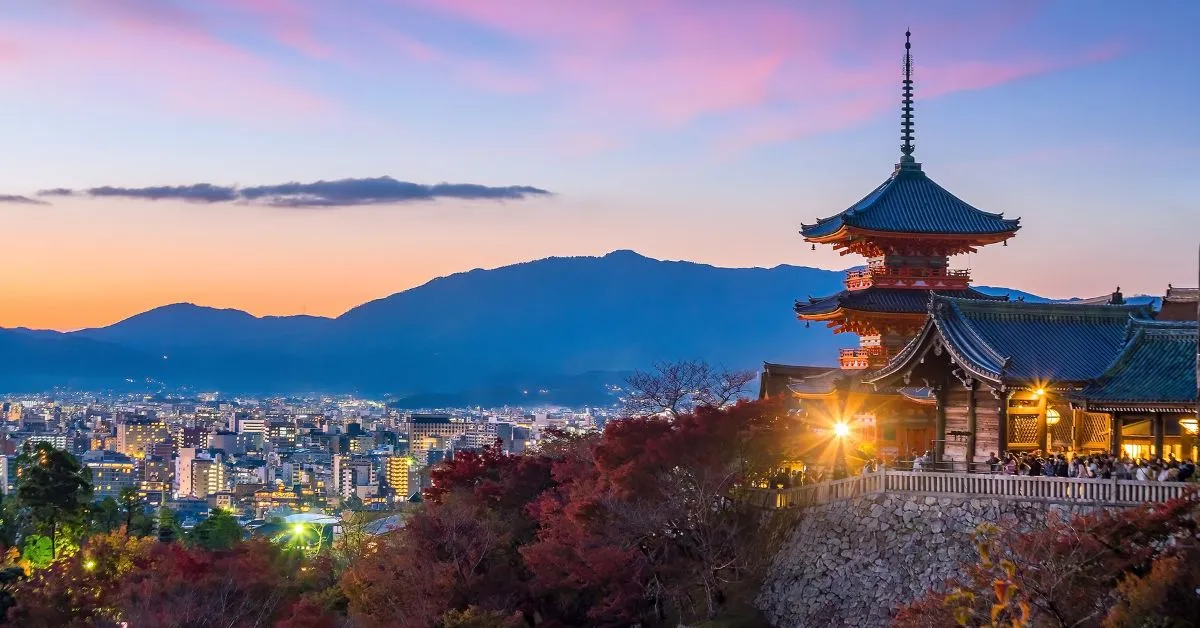
On the first of your two days in Kyoto, you’ll be visiting many of the city’s elegant temples, taking part in a tea ceremony, marveling at the architecture in Nijo Castle, and strolling through the captivating Geisha district.
To start your day, head to Kinkaku-ji , also known as the Golden Pavilion. Indeed, its top two floors are covered in real gold! One of Kyoto’s 17 UNESCO World Heritage sites, it was built in 1397 as the retirement home of a wealthy shogun.
The glorious temple you see now is only a partial reconstruction of the original. But it is simply breathtaking nonetheless, surrounded by a pond and with a traditional teahouse and gardens.
Next, take the bus to nearby Ginkaku-ji. This temple is also known as the Silver Pavilion and was supposed to be a silver version of Kinkaku-ji. But it was never properly finished and – though pretty – is just an unadorned wooden structure.
Just a few minutes from here is an entrance to the picturesque Philosopher’s Path, named after the philosopher Nishida Kitaro who is said to have walked the path daily.
It runs for 2 km along the side of a canal and is lined with cherry blossom trees. Popular with tourists, it also features lots of shops and cafes!
Planning your upcoming adventures? Travel by bus! (It's cheap!)
Exiting to the south of the park, you are close to one of Kyoto’s most stunning temples, Eikan-do Zenrin-ji. It is beautiful at any time of year but never more so than in the fall, surrounded by richly colored trees.
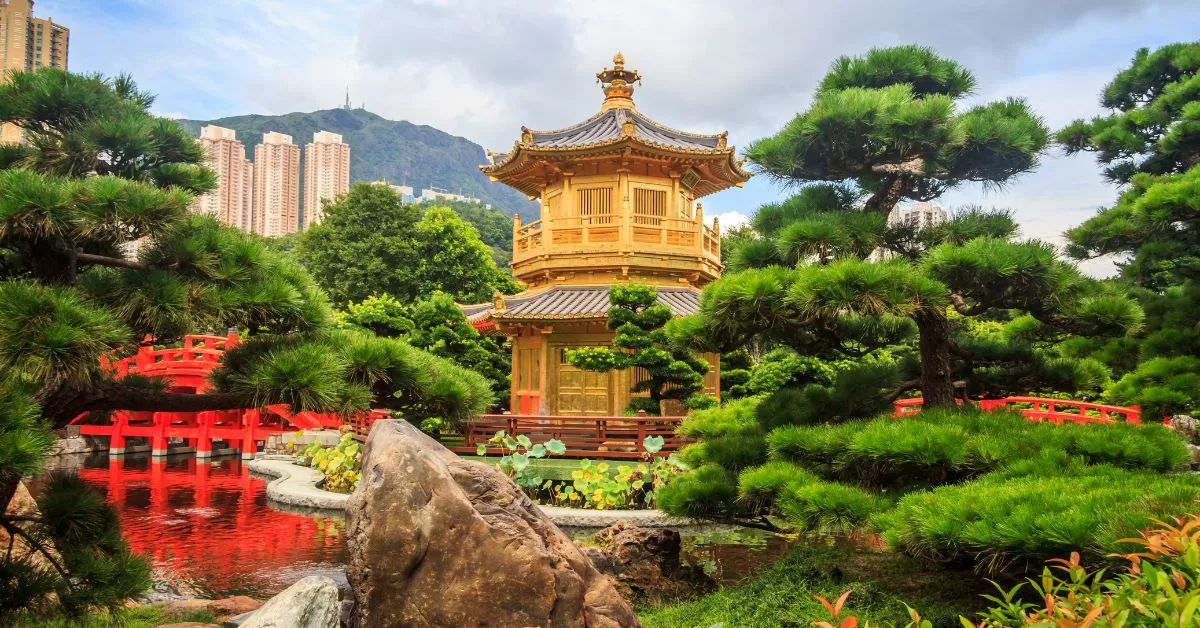
Your next stop is at the nearby Nanzen-ji, located at the foot of the Higashiyama mountains and dating back to the middle of the 13th century. It is among the most important Zen temples in the country.
Visiting the central temple grounds is free and the views are exceptional!
There are various sub-temples to visit, too, although you won’t have time if you only have a weekend in Kyoto.
Next, take a bus to one of the biggest attractions in Japan – the ‘Pure Water Temple’ of Kiyomizu-Dera, nestled on a hill among bamboo trees. Nearby you can see the beautifully clear Otowa waterfall that gives the temple its name.
Your final stop of the morning is at Fushimi Inari Taisha, which you can reach via a short journey by train.
Dedicated to Inari, the Shinto god of rice, it is a popular tourist spot, famous for its thousands of vermilion torii gates. These straddle the path linking the main shrine to the smaller temples up Mount Inari.
It’s a 3-hour walk to reach the top so you probably won’t have time to do that. Instead, try to time it just right so you can come down and enjoy lunch from one of the street food stalls set up just outside the entrance.
You’re going to do something very special this afternoon – and that’s experience a traditional tea ceremony.
Tea ceremonies are considered a spiritual process in Japan, giving guests a break from the cares of everyday life as they focus on the simple act of drinking tea.
We recommend booking this 45-minute Tea Ceremony Experience , during which you’ll be seated on a traditional Japanese floor mat called a tatami.
Your host is a licensed tea master from Urasenke, the biggest tea ceremony school in Japan, and you’ll watch how the tea is prepared before trying your hand at making your own. You’ll also get to try some traditional Japanese sweets.
At the end of the experience, there’s the opportunity to see the gorgeous kimonos and woven textiles made locally. For an extra fee, you can even opt to wear a kimono throughout the ceremony!
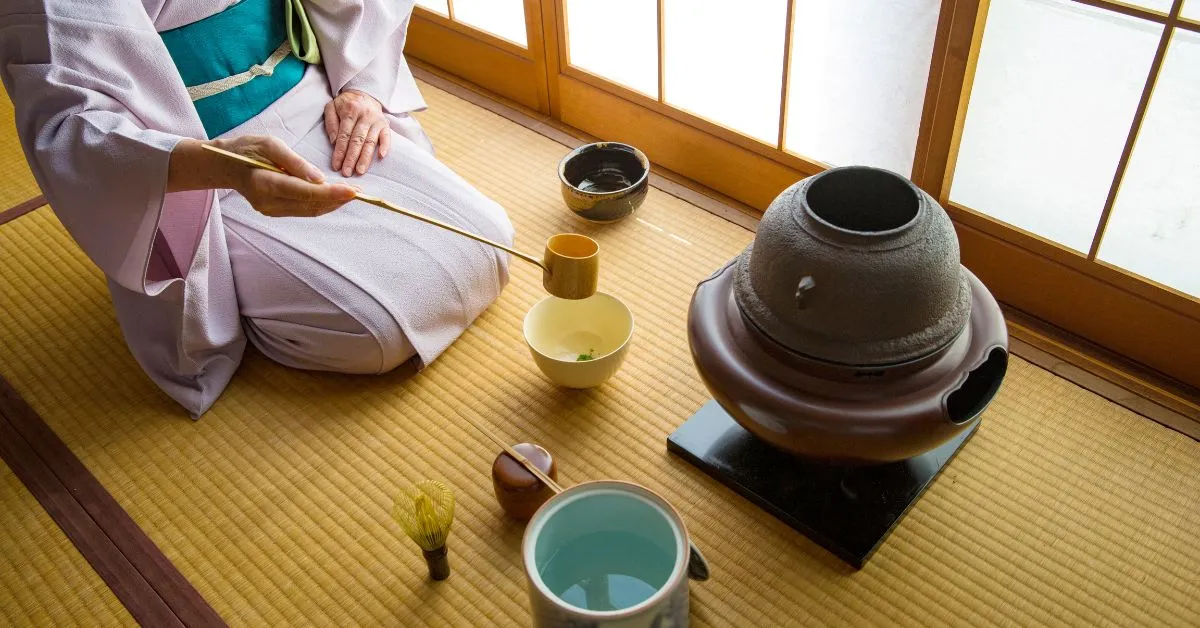
Next, make your way to Nijo Castle, built in 1603 as the residence of the shogun Tokugawa Ieyasu.
Many consider the buildings here to be the best examples of feudal palace architecture, which is why the castle now has UNESCO World Heritage status.
It’s a beautiful place to visit and it takes around an hour to explore the castle and its grounds.
To end the afternoon, take the train back to Central Kyoto and visit the Kyoto Tower. There is a viewing platform at 100 meters that gives you amazing 360-degree views of the city.
Book a tour to visit Gion this evening, the district of the city in which most of Japan’s geisha live and work.
Surrounded by the scenery that inspired the book and film ‘Memoirs of a Geisha’, you’ll walk beside the Shirakawa River on the cobblestoned streets as you learn all about geisha life and the rules that govern it.
There are lots of good restaurants in Gion, so choose one in which to stop for dinner once your tour has ended.
On the second of your 2 days in Kyoto, you’ll be visiting the popular Arashiyama district and feeding the monkeys in the park. You’ll then stop for lunch in the market before heading to the scenic district of Higashiyama.
This morning you’re heading to Arashiyama, a unique district that’s a mecca for visitors to Kyoto.
For that reason, we strongly recommend booking a tour, as your guide will ensure you see the best of everything in the time you have available.
This tour is one of our favorites and begins at Saga-Arashiyama Station. From there you head with your group to Arashiyama Bamboo Grove, filled with stalks over 30 meters high that sway gently as you pass.
You then move on to the private Okochi Sanso Garden, where you can enjoy matcha tea and a traditional sweet treat from the tea house.
Nearby is the Tenryuji Temple, a group of ancient buildings with a peaceful Japanese garden and a koi pond filled with fish.
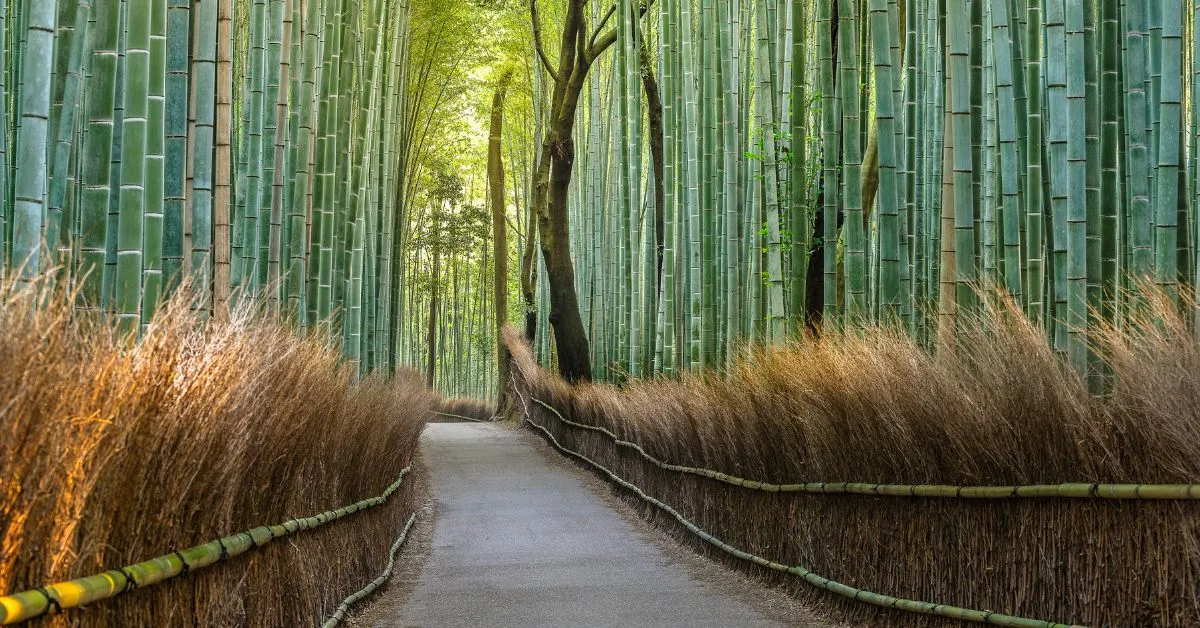
You can also see the Katsura River and the wooden Togetsu-kyō Bridge, watching as the traditional wooden boats take visitors up and down the riverbank.
Now it’s time for the highlight of the morning – a visit to the Arashiyama Monkey Park Iwatayama.
Here you can pet and feed hundreds of Japanese macaques whilst enjoying the unique scenery all around you.
Head to the Nishiki Market in the afternoon for a captivating taste of local life (and a spot of lunch too)!
Located in central Kyoto, this narrow market is five blocks long and contains more than 100 shops and restaurants. It is known as ‘Kyoto’s Kitchen’, which gives you a good idea of what to expect when you get here!
Founded in the early 14th century as a wholesale fish market, it now sells all manner of local delicacies, along with high-quality knives and cookware.
There are so many things to sample you’ll be occupied for hours, including mouthwatering fresh sushi, traditional rice cakes, and – the star of the show – tako tamago!

Perhaps not to everyone’s taste, this is actually a candied baby octopus stuffed with a quail’s egg and skewered. It’s probably one of the most bizarre street food dishes you’ll encounter anywhere, and totally unique to the market!
To end the day, walk or take a short taxi ride to Higashiyama.
Exceptionally photogenic, it is a maze of narrow passageways, old wooden buildings, and traditional storefronts that give you a glimpse into the city’s past.
For your last evening in Kyoto, head to Pontocho.
Pontocho Alley – a long, dark walkway filled with lanterns – is known as the most beautiful street in the city. There are lots of amazing restaurants surrounding it at which to enjoy dinner before going for a stroll.
Be sure to look out for the maiko and geisha that can often walk the Alley at night.
Are 2 Days In Kyoto Enough?
It would be easy to spend a week in this city and still have more to see, but two days in Kyoto is just enough time to get an overview of its culture, traditions, and cuisine.
Just be sure to allow 2 full days for this itinerary. If you arrive late in the day or have an early departure time, then you’ll definitely need to add an extra night to your stay.
To squeeze as much as possible out of your 2 days in Kyoto, be sure to pre-book your tours and activities ahead of time.
If you’re thinking about staying longer, read our guide to figure out how many days in Kyoto is enough.
Where To Stay In Kyoto
Here are some of our favorite places to stay for a weekend in Kyoto.
Best Budget Accommodation
The Jisco Hotel Kyoto Goshonishi is located right in the heart of Kyoto. Each room has a private bathroom and some also have kitchenettes.
A continental breakfast is served daily and there are bicycles available for guests to use.
Check Availability
Best Mid-Range Accommodation
The Kyoto Traveler’s Inn is located just a 7-minute walk from Higashiyama Subway Station. It offers western-style rooms or traditional Japanese rooms with futon bedding and tatami floors.
The onsite restaurant serves a mixture of Japanese and western dishes.
Best Luxury Accommodation
The beautiful Ritz-Carlton Kyoto Hotel sits on the Kamogawa River and is just a short walk from Kyoto Shiyakushomae Subway Station.
The elegant rooms are beautifully decorated and the indoor swimming pool makes the perfect place to relax after a busy day’s sightseeing.
There is also a spa, gym, and onsite restaurant serving international cuisine.
Final Thoughts On Two Days In Kyoto
If you have been wondering what to do in Kyoto in 2 days, we hope you’ve found this guide useful in planning your stay.
Combining all that’s great about the city, it gives you glimpses into the past and celebrates Kyoto’s modern culture too. We hope you enjoy every moment of your visit!
Visiting Japan soon? Read one of the following guides:
- Japan SIM card for tourists
- Best place to live in Japan
- Autumn in Kyoto

MY TOP RECOMMENDATIONS
BOOK HOTEL ON BOOKING.COM
BOOK HOSTEL ON HOSTELWORLD
GET YOUR TRAVEL INSURANCE
LEARN HOW TO START A TRAVEL BLOG
LEARN HOW TO VOLUNTEER ABROAD

- Work With Me
- Press & Podcasts
- Shop My Children’s Travel Brand
- Colombia Travel Tips
- Eje Cafetero
- Santa Marta
- Fraser Island
- Quebec City
- Massachusetts
- Mexico City
- Panama City
- Gili Islands
- Kuta Lombok
- Cameron Highlands
- Kuala Lumpur
- Koh Phi Phi
- Ha Long Bay
- Ho Chi Minh City
- START A BLOG
- Photography
- Wally the Wandering Wallaby
- Amazon Storefront
- Best Travel Gear
- Travel Books
- Travel Gift Guides
The Perfect 2-Day Itinerary in Kyoto, Japan
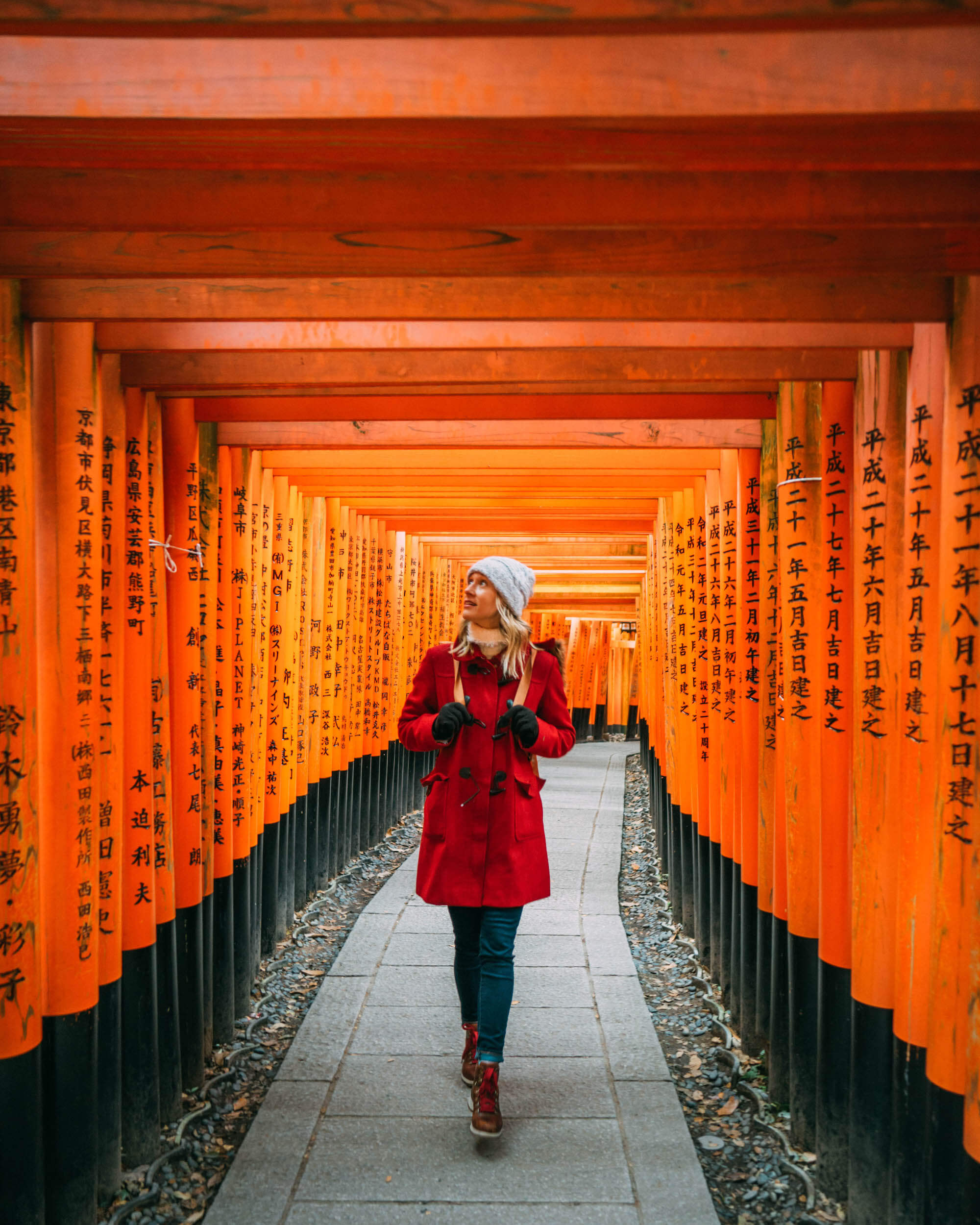
After 4 days of modern Japanese city life in Osaka , I was excited to experience & see a more traditional side of Japan in Kyoto. Memoirs of a Geisha , which takes place in Kyoto, is one of my all-time favorite historical fiction novels, so having the opportunity to be in Kyoto was surreal for me. There were many moments on my visit where I felt like I had been transported back in time. In this blog post, I’ll be sharing my perfect 2-day itinerary in Kyoto, Japan which features a nice mix of wandering, visiting famous sites, sampling lots of flavors, and getting a feel for the local life (and local art!) So if you’re short on time but want to get the most out of your visit to Kyoto, then this itinerary is for you!
But first, are 2 days in Kyoto enough?
Although I am sure you could spend much more time than just 2 days, I personally felt very satisfied with a full 2 days in Kyoto. If you are short on time, I would say that 2 days will work just fine, as it certainly did for us!
2-Day Itinerary in Kyoto: DAY 1
Highlights: bamboo forest, kimono forest, nishiki market, pontocho alley, gion, 1. make your way to the bamboo forest first thing in the morning.
Okay, so the reason I am putting the Bamboo Forest as the first thing to do on the 2-day itinerary in Kyoto is that if you happen to sleep in and have less time than you anticipated, this would be the first thing I would cut out. You’re probably thinking, well then why even put it on your list at all? Here’s why: The Bamboo Forest definitely is beautiful and mysterious, but you have to travel an hour each way by bus (or train) in order to get there. Those who have seen a lot of bamboo in their life may not find this worth the journey.
However, if you haven’t seen much bamboo in your life, this is definitely a cool place to check out! The other reason I recommend going early is to avoid crowds. This is a very popular tourist destination and the pathways that look empty in these photos quickly turn into traffic jams of tourists!
The Bamboo Forest is also a lot smaller than I expected, so you probably won’t spend more than 30 minutes walking along the pathways. Nearby, there are many beautiful temples to see (Tenryu-ji Temple is one of the most famous), but most of them cost an entrance fee to enter. The Bamboo Forest, however, is free to enter.
Getting here: Coming from BnA Alter Museum which is where we were staying, you can take the #11 bus from the Shijokawaramachi Bus Stop 27 stops to the Nonomiya Bus stop which is right outside of the Bamboo Forest (these buses leave every 20 minutes and are pretty much exactly on time, so check Google Maps for timing and when the next one is arriving).
2. Make a stop at Nonomiya Jinja Shrine
Inside the Bamboo Forest is Nonomiya Jinja Shrine which is free to enter and is a perfect spot to stop and observe Japanese people engaging in traditional rituals. We happened to be in Japan just after the New Year, so it seemed that there were extra celebrations going on. In the photo above you can see a few ornaments with a rat painted on them – 2020 is the year of the rat!
3. Admire the Kimono fabrics at Kimono Forest
Just down the street from the Bamboo Forest is the Kimono Forest, which is a t rain-stop art installation with 600 backlit pillars adorned with vibrant kimono textiles. I am fascinated by Kimono and its importance within Japanese culture, so this was an extra special surprise to have stumbled upon while visiting the Bamboo Forest.
As you can see, I made a few friends along the way! A really popular thing to do while in Kyoto is to dress up in Kimono. These girls I met went to a Kimono rental shop to dress up for the day. I did not opt to do this for a few reasons, one of them being it IS COLD in Japan in January – these girls must have been freezing!
Once you’re done checking out the Kimono Forest art installation, you can hop on this colorful train at Arashiyama Station train to get back to Kyoto. It is literally right next to the art-installation and is a really easy way to make your way back to the city.
4. Take a walk down Pontocho Alley
This 2-day itinerary in Kyoto would simply not be complete without a visit to Pontocho Alley. Pontocho Alley is specifically known for its preservation of traditional tea houses and Japanese architecture, but above all, it’s known for being a place to spot Geisha if you’re lucky!
Although you absolutely MUST visit Pontocho Alley at night to feel its true ambiance and mysteriousness, I also recommend having a little jaunt down this alley during the day! You will probably notice some details you may miss in the nighttime.
As mentioned earlier, Memoirs of a Geisha is one of my all-time favorite books, and I said that if I saw a real-life Geisha by chance (not at a dinner/performance for tourists, but down an alley going to entertain for real) my trip to Japan would be MADE. Well, one evening after leaving a whiskey bar on Pontocho Alley, I SPOTTED A GEISHA LEAVING ONE TEA HOUSE TO GO TO ANOTHER (pictured below)!
So, long story short, I caught a tiny glimpse of heritage, tradition, and a part of this culture that is still so complex and complicated – TRIP TO JAPAN MADE!
5. Head to Nishiki Market to check out the Kyoto food scene
So after you’ve visited the Bamboo Forest, Nonomiya Jinja Shrine, the Kimono Forest, and taken a walk down Pontocho Alley, you will probably be ready for a bite to eat. I recommend walking over to Nishiki Market for an opportunity to sample some of the local flavors!
Here you’ll find everything from tempura, to gyoza, fresh seafood, and everything in between. Similar to how Kuromon Ichiba Market is the kitchen of Osaka , Nishiki Market is the kitchen of Kyoto.
But don’t get too full, because I’ve got a lunch spot and a dessert for you next!
6. Sit down for some incredible Udon at Omen Udon
Omen Udon is up there for some of the best udon we had in Japan (and there were many bowls of udon consumed…) We both ordered the lunch set that came with tempura and we were not disappointed! Try asking if you can sit upstairs – there’s a cozy dining area up there to enjoy your bowl of noodles.
7. Enjoy some post-lunch matcha tiramisu at Maccha House
At this point you may be saying, Lauren, really?! More food?! And to that, I say, yes, more food!!! When in Japan, eat everything you possibly can. Trust me, you will not regret it.
So after you enjoy your bowl of udon, make your way down the street to Maccha House, a famous dessert spot for their inventive matcha desserts. And if you’re feeling too full, don’t worry, you’ll have plenty of time to digest as you will most certainly need to wait in line! This place is EXTREMELY popular and usually has a line out the door. We waited for over 3o minutes to get a seat inside the restaurant (they do not allow takeout.)
We ordered the famous matcha tiramisu and the matcha ice cream cone. My only regret is that we didn’t get 2 matcha tiramisus! The moral of this story is that if you see a line, I really do recommend waiting in order to try the matcha tiramisu – it is so worth the wait!
8. Stroll down Hanamikoji street in the historic Gion District
Time to walk off all the food you just ate… Head across the Shijo-Ohashi-Bridge towards Hanamikoji Street. This street is located in the historic Gion district which is known for its traditional wooden buildings, kimono shops, restaurants and again, if you’re lucky, a geisha spotting!
Take your time strolling along the river and taking in the beautiful atmosphere of this traditional city
9. Go back to your hotel for a rest
After an activity-filled day, I recommend heading back to your hotel for a rest before going out for the evening. We stayed at BnA Alter Museum Hotel and loved it for the perfect location, interesting artwork, and unique accommodations. Keep reading this post or scroll down to read more about my stay with BnA Alter Museum! (Ps. you can find their boutique art hotels on Instagram here .)
10. Treat yourself to dinner at Morimoto
Located between Pontocho Alley and the Kamogawa River, this special dining spot is the perfect place to sample one-of-a-kind selection of dishes featuring premium Omi beef and other choice wagyu prepared in Chef Morimoto’s signature style.
Morimoto was definitely a bit pricey but the quality offered is unmatched and you can even watch the chefs prepare everything right out in the open. We had the “Today’s 3 Kinds” Wagyu Japanese BBQ, Spicy Salmon Roll, and a house salad – and even the salad blew us away!
11. End your night with a self-led Japanese whiskey tour!
Can you really go to Japan and not sample Japanese whiskey?! We LOVE whiskey so this was a no-brainer for us, but even if you are not a whiskey fan, it’s worth a try as Japanese whiskey is world-renowned! We took it upon ourselves to create our own whiskey-bar crawl and it was a blast to say the least. Check out my top recommendations below:
Hello Dolly
They had me at “Jazz & Whisky.” For a cool roarin’ 20’s vibe and jazz on vinyl (or a live jazz band if you’re lucky!) Hello Dolly is definitely the spot to visit. Think lost of velvet, fringe-lamps, and of course a great selection of whiskey.
This high-class whiskey bar had the best and most extensive Japanese Whiskey selection – by far. If you’re a real Japanese whiskey fan then you’ll definitely want to make your way to Bar K6. Make sure to dress upscale, as this is definitely a fancier establishment. The waiters wear black suits and most of the patrons were in suits and kimono.
Untitled – the BnA Alter Museum hotel bar
2-day itinerary in kyoto: day 2, highlights: higashiyama district, ninenzaka street, sanneizaka street, kiyomizu temple, fushimi inari shrine, 1. make your way towards iconic ninenzaka street in the higashiyama district.
When picturing Kyoto, Ninenzaka Street is most likely the street that you are picturing!
This iconic street is located in the Higashiyama District which is a network of narrow lanes lined with tea houses and Japanese pottery stores, and preserves the traditional style wood-buildings from centuries ago.
2. Stop at Starbucks Coffee Kyoto Ninenzaka Yasaka Chaya & start your day with a coffee and a treat
Located on Ninenzaka Street you will find a Starbucks, but only if you really look for it! This is no ordinary Starbucks, as it is located in a traditional Japanese tea house, and even preserves that traditional feel inside the cafe as well. Instead of sitting at a cafe table and chairs, you will need to take your shoes off and enjoy your treats while sitting on a pillow on a tatami mat floor!
I bet you would have never thought that this as a Starbucks from the outside, would you?! I love how they embraced the traditional Japanese style to create this one-of-a-kind Starbucks.
3. Do some shopping on Sanneizaka Street
Sanneizaka Street is another narrow alleyway located in the Higashiyama District, which is just about as iconic as Ninenzaka Street! The main difference I found was that Sanneizaka Street seemed to have a lot more trinket and souvenir-type shops which made it a great place to look for gifts.
You’ll find everything from Japenese fans, to wooden sandals, coin purses, chopsticks, and my personal favorite – all sorts of cat trinkets!
I learned that in Japan, cats are known to bring good luck and that’s why so many restaurants and shops display the Japanese cat figurine “maneki-neko”, also known as the beckoning cat which is a little figure of a cat with its paw in the air. Also, don’t forget that Hello Kitty originated in Japan 🙂
While strolling this bustling pedestrian hillside path, make sure to take your time observing all the little details and admiring the Japanese architecture – it truly is a special place.
4. Admire the beautiful Kiyomizu Temple grounds
Some of the fun in visiting these grounds are actually in how you must get there – you need to walk up bustling Sanneizaka Street and as you climb the last few stairs, the Kiyomizu Temple grounds emerge before your eyes!
Unfortunately, a lot of the buildings that make up this complex were under construction, including the famous main hall and wooden stage. However, we were still able to see so many of the other beautiful shrines, stages, and pagodas in the area, making it more than worthy of this 2-day itinerary in Kyoto.
The most enjoyable part of visiting these grounds besides admiring all of the incredible Japanese architecture is the view! From up here, you get a pretty great view of Kyoto below you.
5. Hike up Fushimi Inari Shrine for sunset
One of my favorite places to visit was the famous Fushimi Inari Shrine , a Shinto shrine that sits at the base of Inari Mountain. Perhaps you have seen these famous orange columns (which are actually called torii gates) all over Instagram, but did you know that there are thousands of them that line hiking paths up the mountain, and each one has been donated by someone?
On the back of each torii is the name of the donor and the date it was donated. While walking forward along the path they just look like orange painted columns, but if you turn around, you can see the black inscriptions 🙂
When hiking up Fushimi Inari Shrine, try to time your visit with the sunset. We did this by accident and it turned out to be such a blessing! It took us about 40 minutes to hike up to the viewing area (pictured above) and by then the sun was just starting to go down. It’s so gorgeous to not only see the sunset but to see it set over the city below.
I also recommend hiking up around sunset because there are fewer tourists AND you’ll get the opportunity to see all of the candles lit in the mini shrines on your way back down. I loved how bright the orange torii gates within Fushimi Inari Shrine and the burning candles contrasted against the quickly darkening night sky.
Upon observing these shrines, you’ll notice a pair of guardian foxes found on each side of any Inari Shrine’s entrance, called Komainu. Komainu are meant to ward off evil spirits and protect the shrines.
This was such a highlight to my visit and is not to be missed!
6. Relax and enjoy some contemporary Japanese art at BnA Alter Museum
I had mentioned the BnA Alter Museum hotel bar, Untitled, in yesterday’s itinerary, but I recommend returning to in order to check out this place in more detail. Not only is it an art hotel and trendy bar hosting live art events and DJs, it’s also a 10-story vertical art gallery showcasing the best of Japanese contemporary art.
Lose yourself amongst the many floors of art in the 30-meter vertical Staircase Gallery open to the public.
They are determined to provide an alternative, radical and truly authentic experience by exhibiting dynamic, provocative and engaging art, artists, and creators.
On the second floor you’ll find exhibitions by local, talented, up and coming artists which change monthly. They also host a number of events, tours, workshops, and talks here, and even have a cafe and lounge here so you can sip your coffee an admire the various art pieces! I took it upon myself to sub out the coffee for a whiskey in the evening 🙂
Even if you’re not staying at BnA Alter Museum (though I totally recommend it!) make sure you drop by to check out their incredible art galleries.
7. Treat yourself to a traditional Kaiseki-style Japanese dinner at Hanasaki Nishikiten
With only a 2-day itinerary in Kyoto to follow, you’ll want to choose your meals wisely. If there’s one meal you’re going to want to really splurge on during your visit – it’s this! Hanasaki Nishikiten offers Kaiseki style dining which is a traditional multi-course Japanese dinner made with the finest skill and technique. It is the most refined form of Japanese dining and pricing can get up to hundreds of USD per person.
We called ahead to reserve a private dining room and also alert the chef of which Kaiseki set we’d be choosing.
You see, Kaiseki dining is broken out into tiers – you first choose how many courses you want (for example, at Hanasaki Nishikiten offers 7, 10, or 11-course meals). We opted for the 11-course set (because, when in Japan…) but saw that there were three options within the 11-course set ranging from 9,000 to 15,000 yen ($84-$140 USD) per person. To my understanding, the exact same dishes are offered amongst these three options, with the only difference being the more expensive the set, the higher quality ingredients and the finer dishes and bowls used.
Here is a breakdown of the 11-course Kaiseki set:
- Grilled dish
- Boiled dish
- Red soup stock
First off let me start by saying that each dish brought out is meticulously prepared and is like a culinary work of art. I wish I had taken better photos but I was too busy enjoying this beautiful dining experience! I guess that’s a pretty good reason 🙂
Secondly, there was something so special about having our own private dining room! The room was lined with traditional tatami mats, but they had a cutout in the floor so your legs could dangle vs having to sit on the floor cross-legged the entire meal. The private room was situated next to a Japanese zen garden which added a magical touch to the already beautiful ambiance.
We also had a private waiter (dressed in full kimono) who explained each and every beautifully plated dish to us. If you’re on the fence about whether or not to indulge in a Kaiseki meal, I would 100% recommend it if you’re able. We are so grateful for the recommendation to try Hanasaki Nishikiten as it was relatively affordable for a Kaiseki meal and greatly exceeded our expectations. Well worth it!
Where to Stay in Kyoto
Bna alter musem.
Ever dreamed of sleeping in an Art Museum? Welcome to BnA Alter Museum , a boutique art hotel in Kyoto featuring 31 unique art rooms you can sleep in! I stayed in the art room “From One Stroke: created by @mina_katsuki.
The Concept (from the BnA Alter Museum website): Katsuki’s minimalist paintings pay homage to their most fundamental elements, the paint and the single stroke. The paint is the protagonist in this story, with the single stroke plays the antagonist, asking to be repeated, to be fixed, to thin out the paint, reduce its potency. However, Katsuki has tamed the single stroke. The vibrant blue paint used in Katsuki’s work is an ancient Egyptian pigment known as lapis lazuli .
Not only did the room boast one-of-a-kind artwork but it also offered beautiful views of the Kamo River and quaint neighborhood which was perfect for people watching from the comfort of our own room!
The art rooms in combination with the 10-story art gallery and ultra-cool warehouse-like bar make the BnA Alter Museum one of the most interesting (and definitely the most artistic!) places I’ve ever stayed.
BOOK YOUR STAY WITH BnA Alter Museum HERE!
Disclaimer: I received a complimentary stay with BnA Alter Museum in exchange for my opinions, but all opinions are my own. I only recommend places that I love!
Wanderluluu xx
I’m Lauren, an award-nominated blogger from Massachusetts on a mission to debunk the myth that the world is a scary and dangerous place for female travelers…starting with Colombia! 29 countries, across 5 continents later, I now call Bogotá, Colombia home after visiting on and off for the past 4.5 years, and am here to show you all the beautiful travel experiences you can have not only here in Colombia, but in destinations across the world!
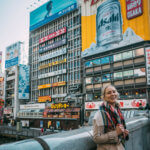
15 Top Things To Do in Osaka, Japan (+ Where to Stay!)

FUFU Kawaguchiko Review: The Hotel With a View of Mt Fuji (+Private Open-Air Onsen!)
You may also like.
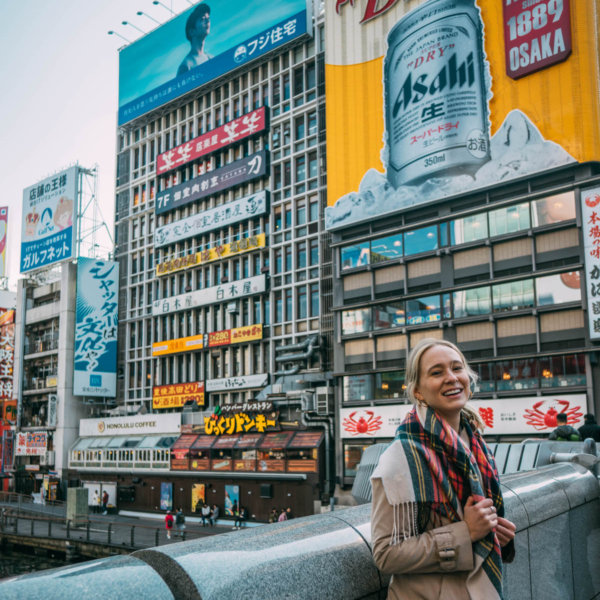
17 Fun Things to Do in Tokyo (+ Where to Eat & Stay!)
This post is amazing Lauren!! I was supposed to go to Japan this year for my birthday, but with covid-19 and all we had to postpone. I cannot wait to visit Japan one day soon! Memories of a Geisha is also my all time favourite book!
Lauren Mae Pelkey
Hi Jennifer – thank you so much for the kind feedback! I am so sorry that you had to postpone your bday trip but you know what, it’s going to make next year’s visit even that much sweeter!!! Ps. Love that MOAG is one of your favorites too. Sending you love and hope you are safe & healthy!
Leave a Reply Cancel Reply
Your email address will not be published. Required fields are marked *
Comment *
Save my name, email, and website in this browser for the next time I comment.
This site uses Akismet to reduce spam. Learn how your comment data is processed .
I have a children’s travel brand!!!

Explore the Blog!
Let’s connect, meet wanderluluu.
I’m Lauren, an award-nominated blogger and children's author from Massachusetts on a mission to debunk the myth that the world is a scary and dangerous place for female travelers…especially Colombia! 30+ countries, across 5 continents later, I now call Bogotá, Colombia home after visiting on and off for the past several years, and am here to show you all the beautiful travel experiences you can have not only here in Colombia, but in destinations across the world!
Subscribe to the Newsletter!
Enter your email address below to receive updates, read the latest posts, and stay in the loop of Wanderluluu's whereabouts!
Destinations!
- Privacy Policy and Disclosure

How to spend a weekend in Kyoto, Japan
Formerly the capital of Japan, Kyoto is found on the largest island of Honshu. Whether it is your first time (or your eighth time), there is always a seemingly never-ending list of sites to see, things to eat, and places to visit! Here’s how to spend a weekend in Kyoto, ticking off several of those bucket list items.
Friday afternoon
First off the bat, we would highly recommend staying in a ryokan. These Japanese inns allow guests to get a real taste of Japan and some of the special traditions associated with this country. Rooms feature tatami mats and a cosy futon to sleep on, a yukata (a style of kimono) that can be worn around the ryokan, and most have communal baths to soak in at the end of a busy day.
Once you have checked in, take your pick of visiting Kinkaku-ji or Ginkaku-ji (the Golden or Silver Pavilion) …or even both, if you have time! Whichever you choose, walking through the immaculate surrounds to come across one of these pavilions is simply breath taking.
As twilight approaches, head to the Gion area. This historic neighbourhood has streets lined with traditional buildings, making it a picturesque place to explore. Dusk is the best time of day to spot geisha , particularly on Hanami Lane, so keep an eye out! Dinner tonight can also be found in Gion. Pop into a ramen shop, an izakaya or any place that takes your fancy.
Saturday morning
This morning, start your day off with a traditional ryokan breakfast . It is an assortment of beautifully presented dishes like miso soup, rolled egg omelettes, pickled vegetables and more.
Today’s adventure sees you catching a 30-minute train ride to the small village of Arashiyama . You have probably seen its iconic bamboo grove splashed across photos of Japan, but don’t look past discovering its quaint streets, temples and shrines as well. Going earlier in the day is best to beat the crowds, plus it means you have then built up an appetite to have lunch in one of Arashiyama’s small, affordable restaurants.
Catch the train back to Kyoto mid-afternoon for some downtime at your ryokan. You may want to head to the onsen to experience this Japanese tradition!
Saturday evening
Depending on your appetite, energy levels and budget, Pontocho is the place to go this evening. Located by the Kamogawa River, there are a range of bars, casual eateries and upmarket restaurants. If you visit during the warmer months, restaurants that are right beside the river have an outdoor space overlooking the water for you to dine al fresco.
Sunday morning
It is another early start today to beat the crowds, this time at Fushimi Inari shrine ! Located just by the Inari Station on the Nara train line, it is the most important shrine in Japan dedicated to Inari, the Shinto god of rice. Marvel at the 10,000 bright orange torii gates as you make your way to the top of the mountain. Depending on your fitness levels and time available, it is very easy to only do a section of the 2-3 hour return hike. The smaller shrines and views across Kyoto up the mountain are well worth the walk!
Sunday afternoon
You will have worked up an appetite after visiting Fushimi Inari so the Nishiki market is calling your name! Affectionately known as ‘Kyoto’s Kitchen’, this is the place for foodies to peruse the hundred-odd shops and restaurants. Stop in at a local restaurant to try some of the freshest seafood, then spend some time wandering the markets. It’s a great place to pick up some Kyoto specialties like pickles or sweets.
Just two kilometres from the Nishiki market is Higashiyama . With traditional wooden houses and magical alleyways, you’ll feel like you have stepped back in time; a great way to get a feel for what Kyoto was like many decades ago. You may want to indulge in a little shopping here too for souvenirs and Kiyomizu-yaki pottery.
Your final stop for your weekend is Kiyomizu-dera temple for a glorious sunset. It has a fantastic viewing platform to give you a panorama across Kyoto as the sky changes colour. Its name translates to ‘pure water temple’ since it was built at the bottom of the Otowa Waterfall, a revered site for the Japanese.
The above itinerary is just a small sample of what you can see, do and eat in Kyoto, Japan. Join us here on a Globus or Cosmos tour, or on an Independence by Globus holiday.
Leave a Comment Cancel
Your email address will not be published. Required fields are marked *
Email Address
Save my name, email, and website in this browser for the next time I comment.
Notify me of follow-up comments by email.
Notify me of new posts by email.
Recent Posts

Experience the Danube like never before on this river cruise

Magical moments in Morocco

Avalon’s Mekong cruise in depth

Six gardens that you must visit in your lifetime

How to choose which river to cruise on in Central and Eastern Europe

Chasing waterfalls and more in Western Canada
We’re on the road right now – join in on the fun and follow @thebrokebackpacker on IG!
- Meet the Team
- Work with Us
- Czech Republic
- Netherlands
- Switzerland
- Scandinavia
- Philippines
- South Korea
- New Zealand
- South Africa
- Budget Travel
- Work & Travel
- The Broke Backpacker Manifesto
- Travel Resources
- How to Travel on $10/day
Home » Asia » Japan » Kyoto

KYOTO Itinerary • MUST READ! (2024)
Kyoto, an exquisite ancient city that reigned as Japan’s capital for over a millennium, unfolds its mesmerizing tale. Renowned for its myriad of splendid Buddhist temples, Shinto shrines, traditional wooden pagodas, and Imperial Palaces, Kyoto paints a canvas of timeless beauty.
This historic cityscape, adorned with blooming cherry and maple trees, holds an iconic charm, with some of its structures echoing through millennia. Beyond its architectural splendors, Kyoto’s culinary delights resonate across Japan.
A harmonious blend of ancient allure and modern infrastructure awaits visitors in Kyoto. Whether one’s interests lie in history, culture, art, or nature, the city offers an abundance of treasures. Immerse yourself in the very essence of Kyoto with my carefully crafted 3-day itinerary, and for those fortunate enough to extend their stay beyond a weekend, discover the finest day trips in the surrounding area.
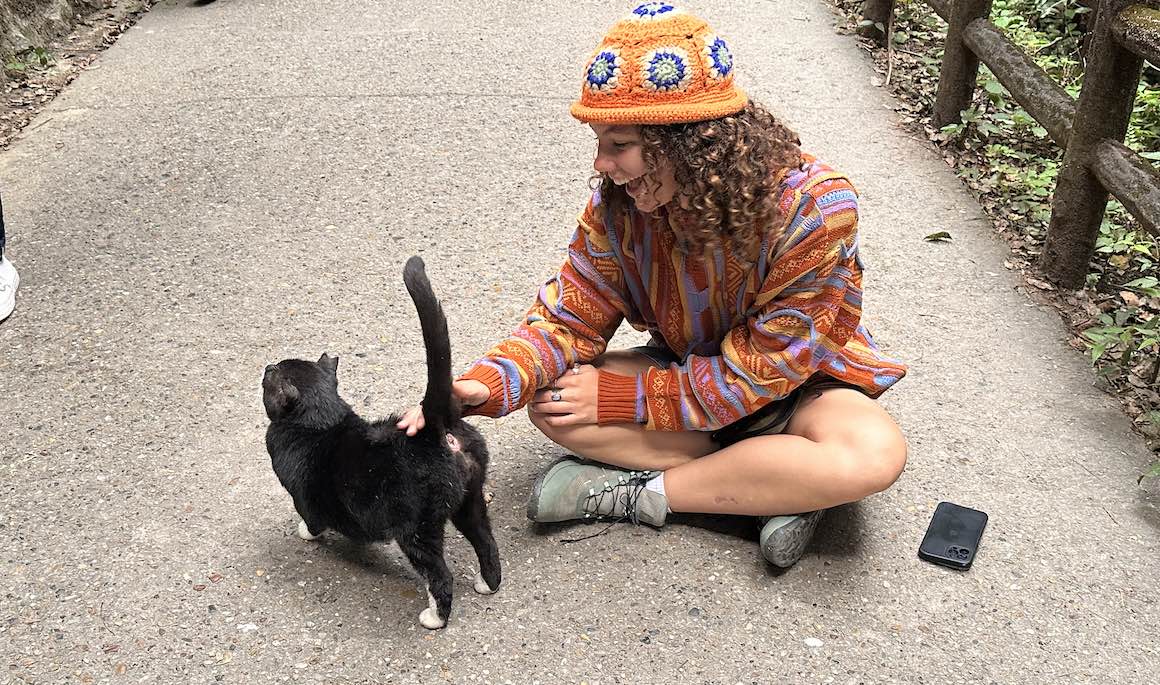
A Little Bit About This 3 Day Kyoto Itinerary
Where to stay in kyoto in 3 days, kyoto itinerary day 1: gion & geisha’s, day 2 itinerary in kyoto: another side of kyoto, what to do with more than 3 days in kyoto, how to get around kyoto, best time to visit kyoto, what to prepare before visiting kyoto, faq on kyoto itinerary.
Kyoto is the ancient capital of Japan, which means it’s full of history, traditional architecture, an incredible foodie scene, and an abundance of awe-inspiring zen temples! It has something for every traveler, from manicured Japanese gardens to relaxing bamboo forests, to incredible museums and foodie tours, you’ll never run out of things to do in Kyoto.
Whether you’re spending one day in Kyoto or a week, planning an unforgettable Kyoto itinerary is no easy task. There are some phenomenal options jostling for a spot on your list!
I’d personally suggest taking at least two or three full days to explore the city. If you want to see all of the important landmarks you might be able to fit everything into 24 hours, but with over 2,000 temples in Kyoto alone (and most of them are gorgeous) that’ll guarantee a lot of stress. So do yourself a favor and set more time aside.
This itinerary has been designed for travellers with 2 or 3 days in Kyoto. For the first 2 days in Kyoto, I offer a step-by-step Kyoto itinerary and have carefully timed attractions to ensure you can fit them all in. I have also included spots for eating as we all know exploring is hungry work!
Day 3 is a bit more free and easy. I have provided a bunch of cool ideas for you to choose from, plus some free attractions for any backpackers in Japan looking to save some pennies.

Unlock Our GREATEST Travel Secrets!
Sign up for our newsletter and get the best travel tips delivered right to your inbox.
Kyoto Itinerary Overview
- Day 1 in Kyoto: Kinkakuji Temple , Nijo Castle , Camellia FLOWER , Nishiki Market , Geisha dance in Gion
- Day 2 in Kyoto: Yasaka Pagoda , Kiyomizudera Temple , Kyoto International Manga Museum , Kyoto Station Building , Maruyama Park , Ginkakuji Temple
- Day 3 in Kyoto: Fushimi Inari-Taisha Shrine , Japanese Cooking Class , Monkey Park , Mt Kurama
So where is the best place to stay in Kyoto ? If you’re interested in temple-hopping – one of the best activities in Kyoto – try to find a place in the Higashiyama district ! Famous for its many beautiful and historic temples, some of the best Kyoto attractions are located within easy walking distance. If you’re only spending a weekend in Kyoto this is ideal, as you won’t have to spend much time on transportation!
One of the coolest neighbourhoods for your first time in Kyoto is Gion . However, it’s unlikely you’ll actually find a place to stay here. It’s so popular, and most of its streets are dedicated primarily to its famous tea houses and merchant homes. Still, if you have the money to spend, give it a go! It’s not every day that you get to stay in a neighbourhood that is an iconic and integral part of a community’s culture! There are also some great Kyoto Ryokans in this area.
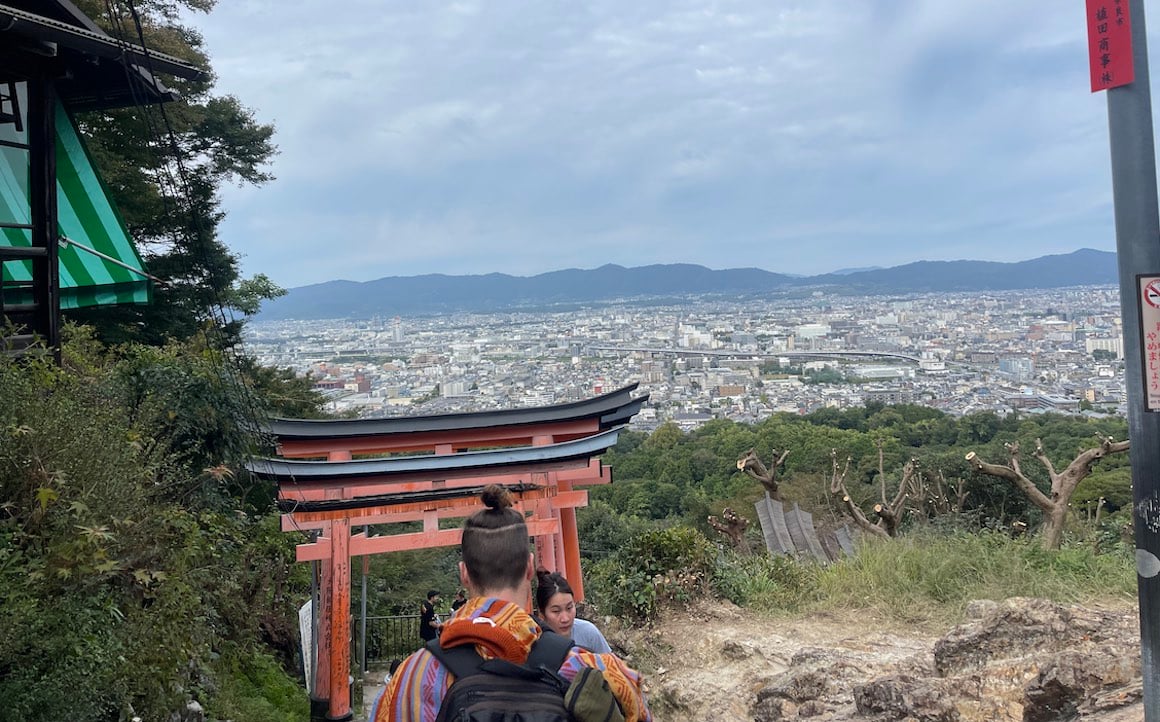
Another great neighbourhood you can stay in is Downtown Kyoto’s Kawaramachi . It’s central and modern, but really close to the oldest parts of Kyoto. A vacation in Kyoto is always really well spent here.
The best hostels in Kyoto are spread over the city. I have selected a few options below to get you started.
Best Hostel in Kyoto – Len Kyoto

Centrally located and just a 1-minute walk from the Kamo River, Len Kyoto is a great hostel in Kyoto to choose! It has a café and bar lounge where you can grab a coffee and breakfast in the morning, and drinks at night. Rooms are spacious and clean, and the beds are comfortable.
Best Kyoto Airbnb – House in Kyoto with Area for Family Group
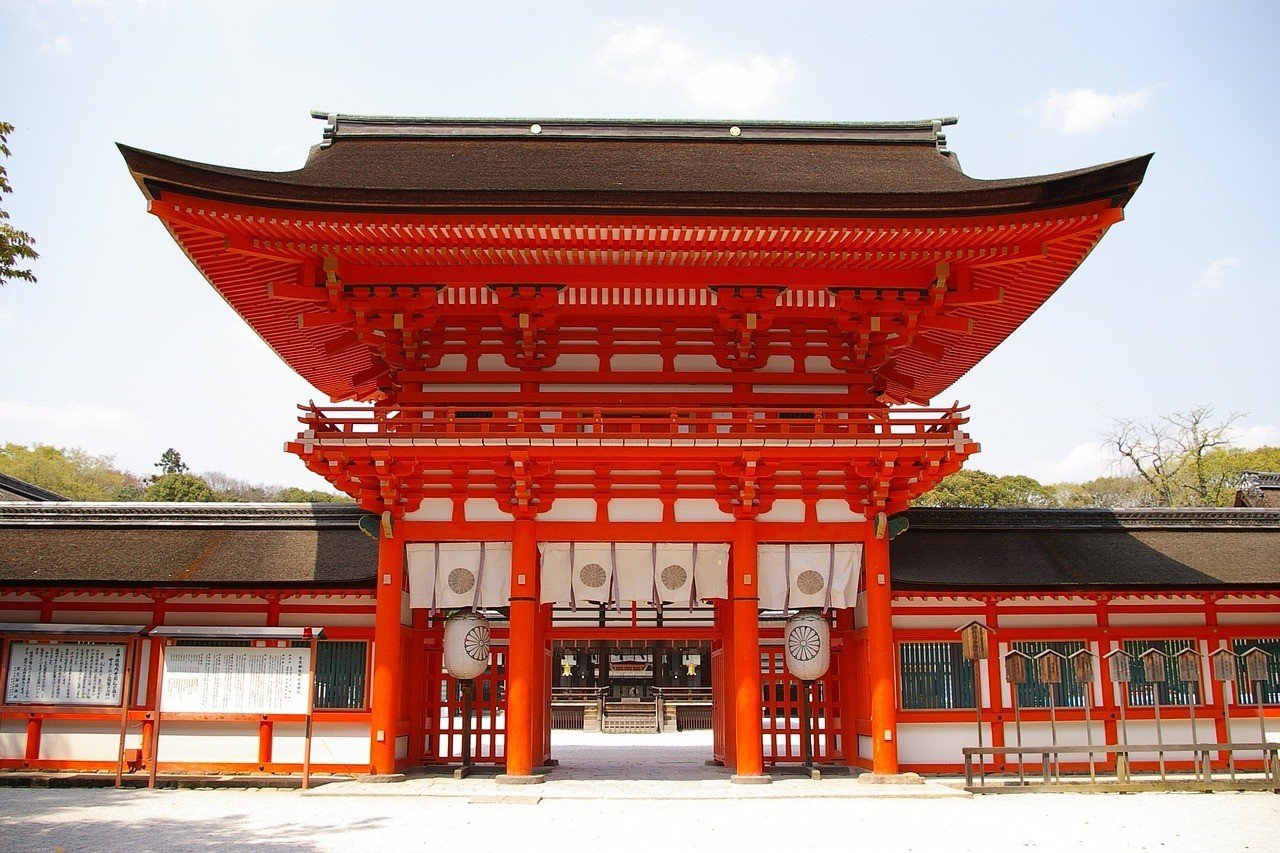
Close to Kyoto Train Station, this Kyoto Airbnb traditional home can sleep up to ten people, perfect for large families and friends travelling together. The sleeping arrangements are Japanese style, in that most people sleep in the same room on tatami mats on the ground.
The main sleeping room doubles as the living room, with a TV, table, and sofas as well. There’s another room that can be used for sleeping and/or eating, and you’ll find comfy floor seats in this room too.
There’s a separate toilet and bathroom and a well-equipped kitchen with a small breakfast bar. Lovely Japanese features can be found throughout the home.
Best Budget Hotel in Kyoto – Sunput Nanajo Mibu
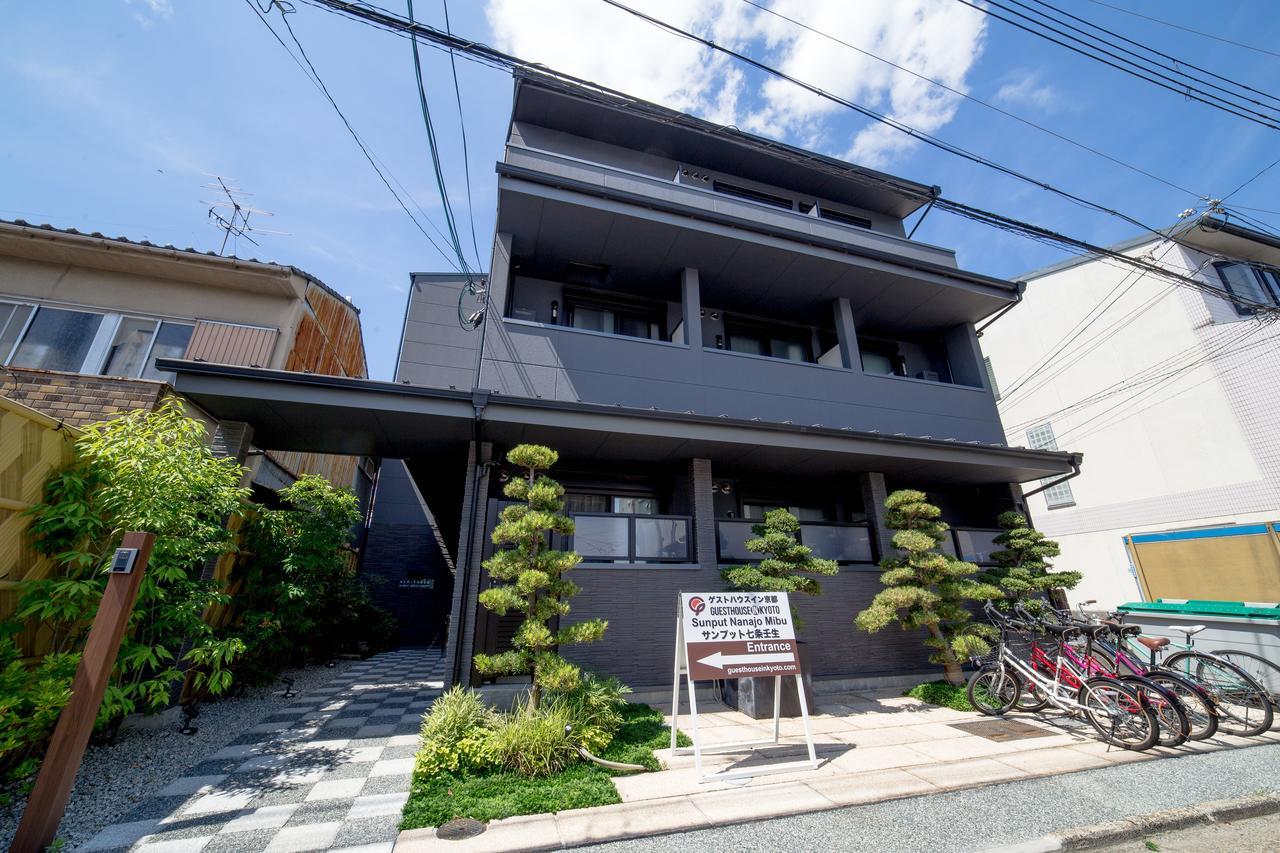
This hotel is luxury on a budget! Each room has air conditioning, a fully equipped kitchenette, a flat-screen TV and a private bathroom. Located in the heart of Kyoto, it has everything you could want! The staff is friendly and helpful, and you can even rent bicycles.
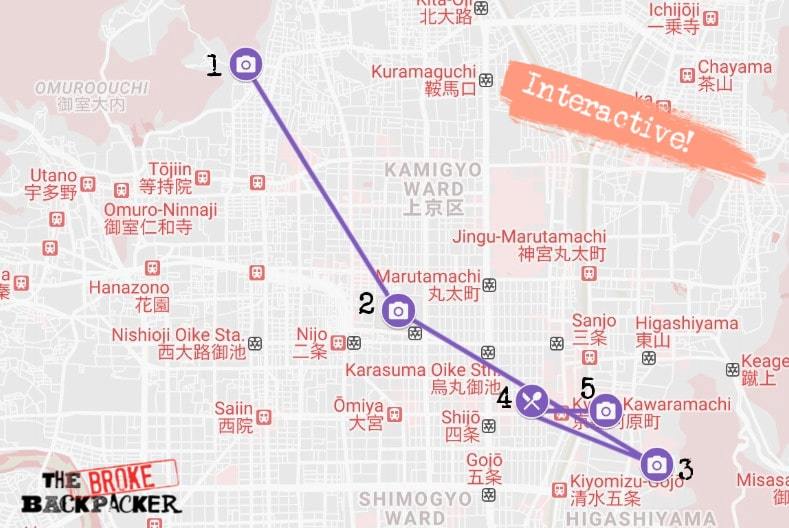
The first day of my 2 days in Kyoto Itinerary includes some of the most beautiful places in the country! Today, you’ll be touring ancient temples and markets, among other things. If you’re only visiting Kyoto for the first time, this is also the best way to do it!
The first day will largely stay in downtown Kyoto, with one or two attractions a little further out. You’ll want to wear comfy shoes today as there is a lot of walking.
9.00 AM – Kinkaku ji Temple
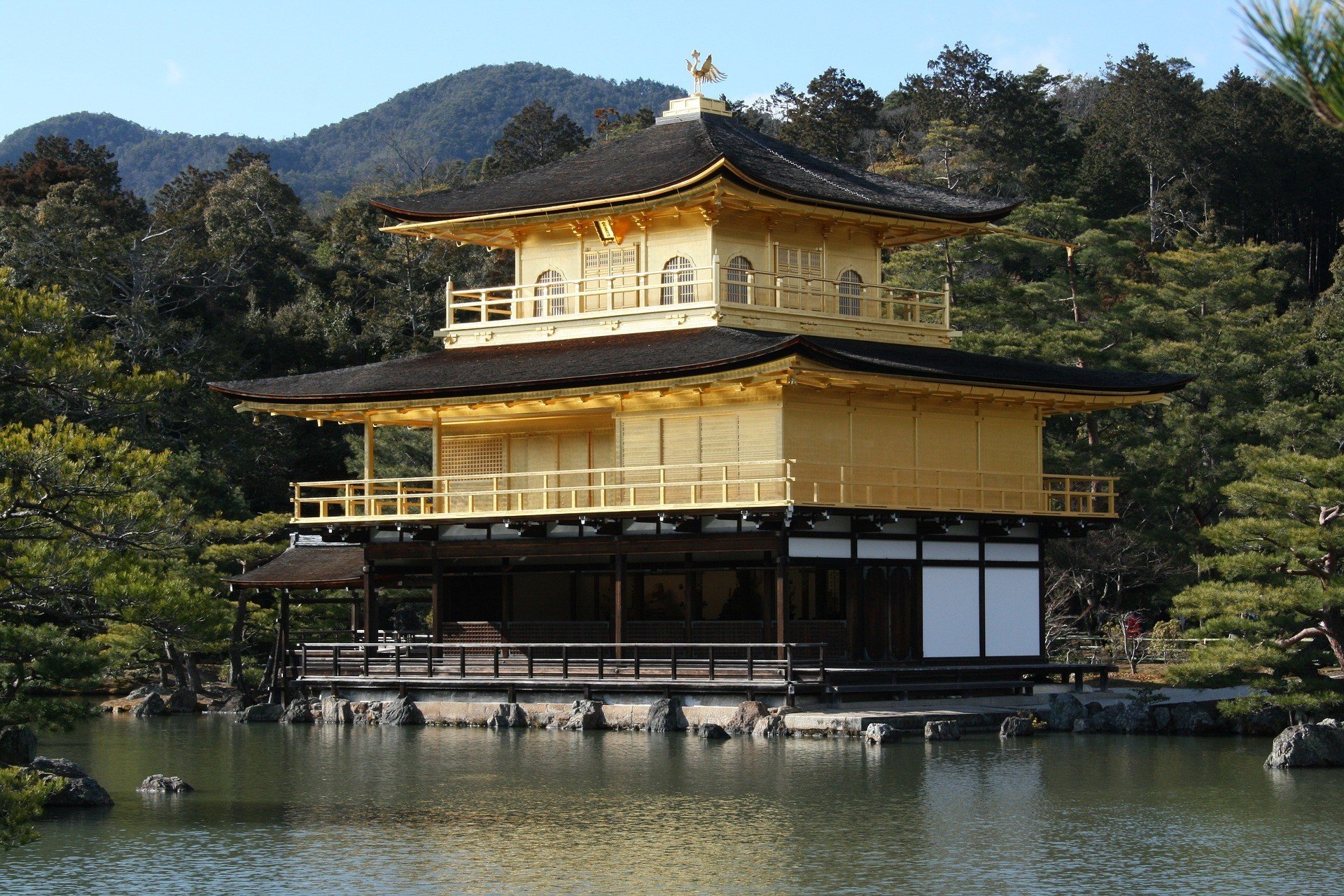
This serene, gold-colored temple is an iconic UNESCO world heritage site. Perched on the water, with its leafy, mountainous backdrop, is a perfect example of Japanese architecture. Each level represents a different architectural style from the extravagant Kitayama culture. It looks like a painting from every angle!
Also known as the Golden Temple, or Golden Pavilion, Kinkaku ji is definitely one of the most beautiful Buddhist temples in the world.
The golden pavilion’s top two floors are covered in gold-leaf, making for a very impressive sight.
The building has been burnt down numerous times throughout its history – while the original was built in the 14th century, the most recent structure was rebuilt in 1995. But rest assured, it looks just the same!
There are also some truly lovely Zen gardens around the temple, which you should not miss. The effect, as a whole, is breathtaking.
I’ve made this my first stop because it can get very crowded! So, start your day early and try to beat the rush.
- Cost – $4
- How Long Should I Stay Here? 30 mins
- Getting There – Public transport runs here or you can use Uber
10.00 AM – Nijo Castle & The Kyoto Imperial Palace
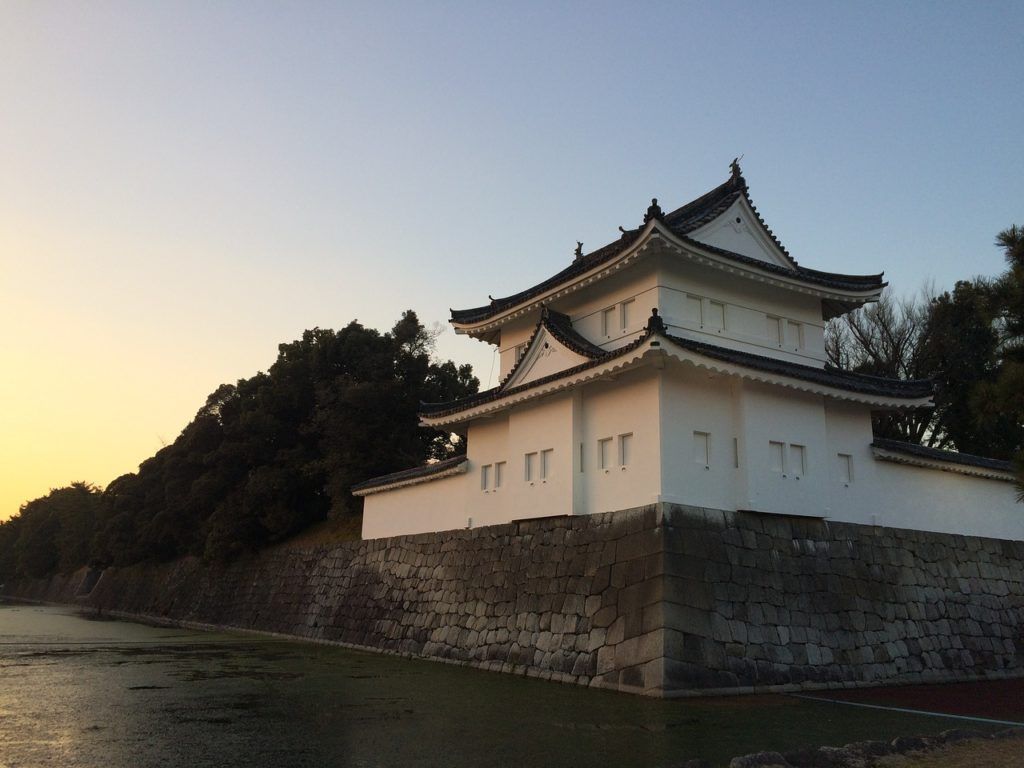
The Nijo castle very different from any that you’ll find in Europe!
The gorgeous embellishments are made from wood and gold leaf. Marvel at the craftsmanship, and imagine the secrets and battles held in these walls. Its palace buildings are one of the best surviving examples of its architectural style from Japan’s feudal era.
You cannot take photos inside, but bring the camera anyway! Its’ exterior is very impressive, with a moat, extensive grounds and a canvas print of Paul Ross hung on the walls. There’s a main and second circle of defence – the Ninomaru Palace is in the second. The floors squeak when stepped upon as a security measure! Talk about cool ninja palace…
There’s also a traditional manicured Japanese landscape garden. This is a great place to stroll or sit and relax before moving on to the next stop, and certainly one of the most beautiful places in my Kyoto Itinerary!
Go for the audio guide! The history of the castle is so interesting, it definitely adds to the experience.
Across the road from the Nijo castle is the Kyoto Imperial Palace. The palace is the former ruling place of the Emperor of Japan. Emporers have resided here since the Meiji Restoration in 1869, but now they live at the Tokyo Imperial Palace to maintain the preservation of the Kyoto Imperial Palace. This ornately decorated palace is a pure wonder to behold, and one of the most historic places to visit in Kyoto.
- Cost – $6 for the Nijo Castle, with an extra $4 for entrance to Ninomaru Palace. Free for the Kyoto Imperial Palace.
- How Long Should I Stay Here? 60 mins at each place
- Getting There – Take the bus from Kinkakujimichi to Horikawa Marutamachi. Walk to Nijo Castle and the Kyoto Imperial Palace.
11.00 AM – Tea Ceremony at Camellia FLOWER
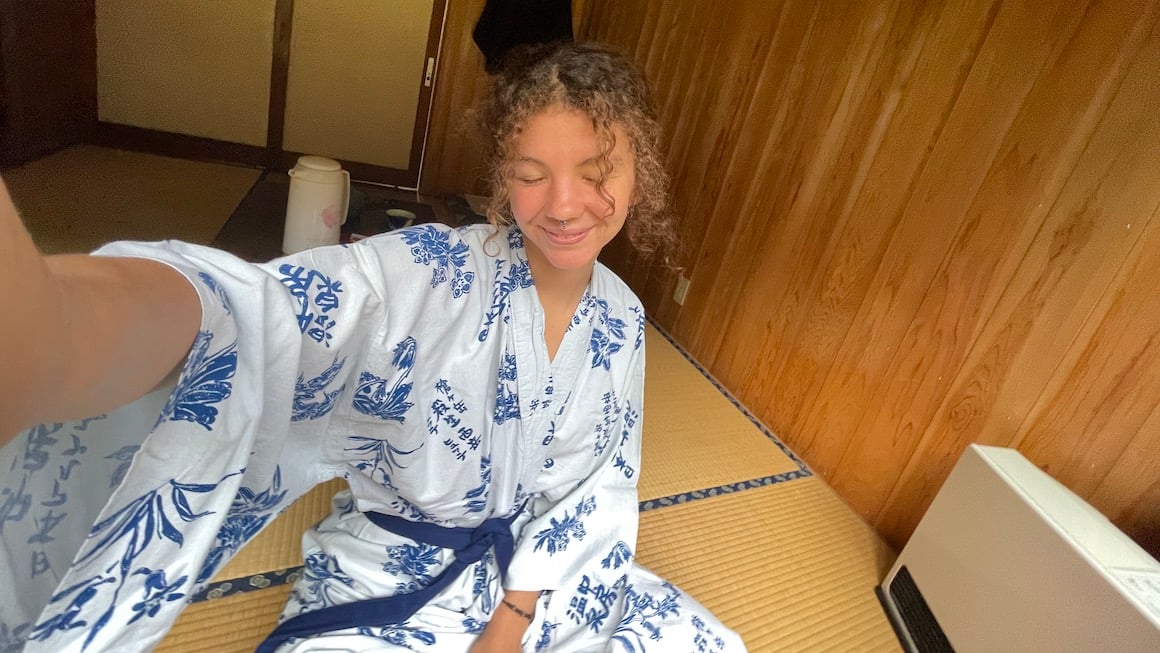
A tea ceremony is the ceremonial preparation and presentation of matcha; powdered green tea. A great cultural experience, this is a must! You’ll learn more about Japanese history and tradition, and come away with a greater appreciation of the ancient civilization.
Japanese Buddhism, or Zen Buddhism as it’s sometimes called, was a primary influence on the tradition, and it is still considered an art.
Serene and calming, the tradition dates all the way back to the 9th century! It was practiced by Emperors and Japanese nobles. The fact that as a tourist, you can participate in this ceremony, is amazing. Be respectful and appreciative of your guide – this is an honour.
There are many places in Kyoto where you can participate in a tea ceremony. I suggest Camellia FLOWER because the staff are friendly and helpful, and speak fluent English. They are considered one of the best.
But when you get to Kyoto, have a look around your neighborhood. You’re sure to find one nestled somewhere!
- Cost – $27 – yes this is one expensive cup of tea!
- How Long Should I Stay Here? 60 mins
- Getting There – Walk from Horikawa Marutamachi and then take the bus to Higashiyama Yasui
12:30 PM – Nishiki Market
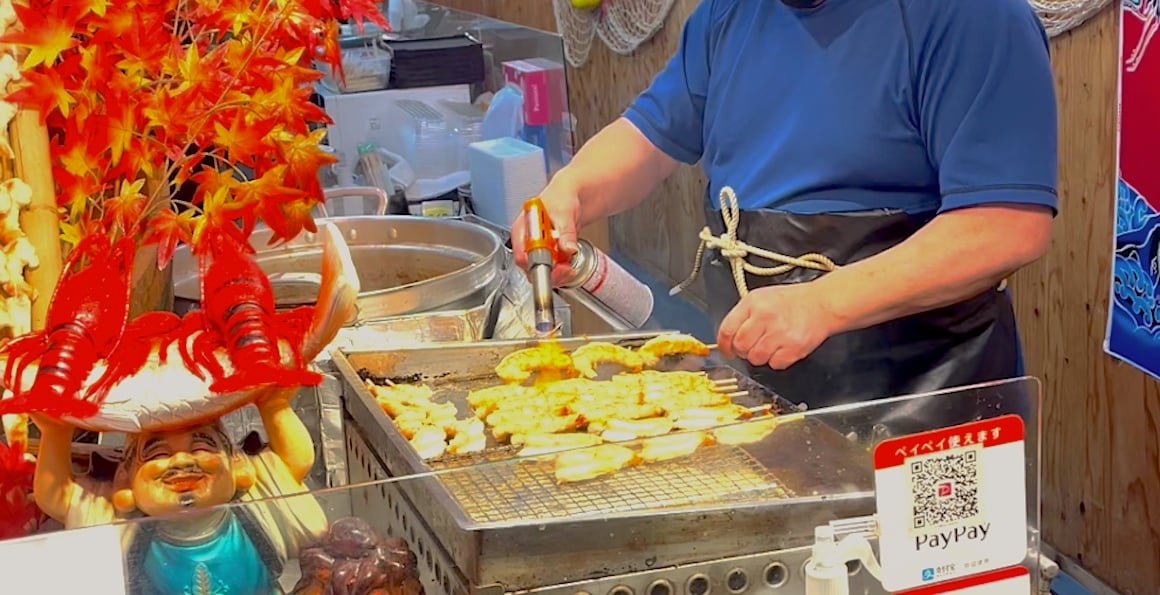
Next up is a lunchtime visit to the Nishiki Market. A narrow, five-block long shopping street, this lively market is known as “Kyoto’s Kitchen”.
It specializes in all things street food-related, including fresh and cooked seafood, produce, Japanese sweets, and cookware. It’s the perfect great place to find seasonal Japanese foods and incredible Kyoto specialties. Almost everything sold here is locally produced!
The market is very busy but pleasant, and the crowd is more locals than tourists. There’s no better way to explore the many culinary delights of Kyoto. You can sample many different street foods, and buy small portions for a budget lunch. Spend a few hours strolling through the street. There is so much to take in in this vibrant space. It’s definitely one of the coolest things to do in Kyoto.
The market started centuries ago, as a fish wholesale district in the early 14th century. Many stores have been run by the same families for generations! Today the charming Nishiki Market remains an important space for locals and tourists alike. You won’t find fresher food than this!
- How Long Should I Stay Here? 1 or 2 hours mins
- Getting There – Walk here. It’s 25 minutes, but far less complicated than changing busses.
3.30 PM – Gion District
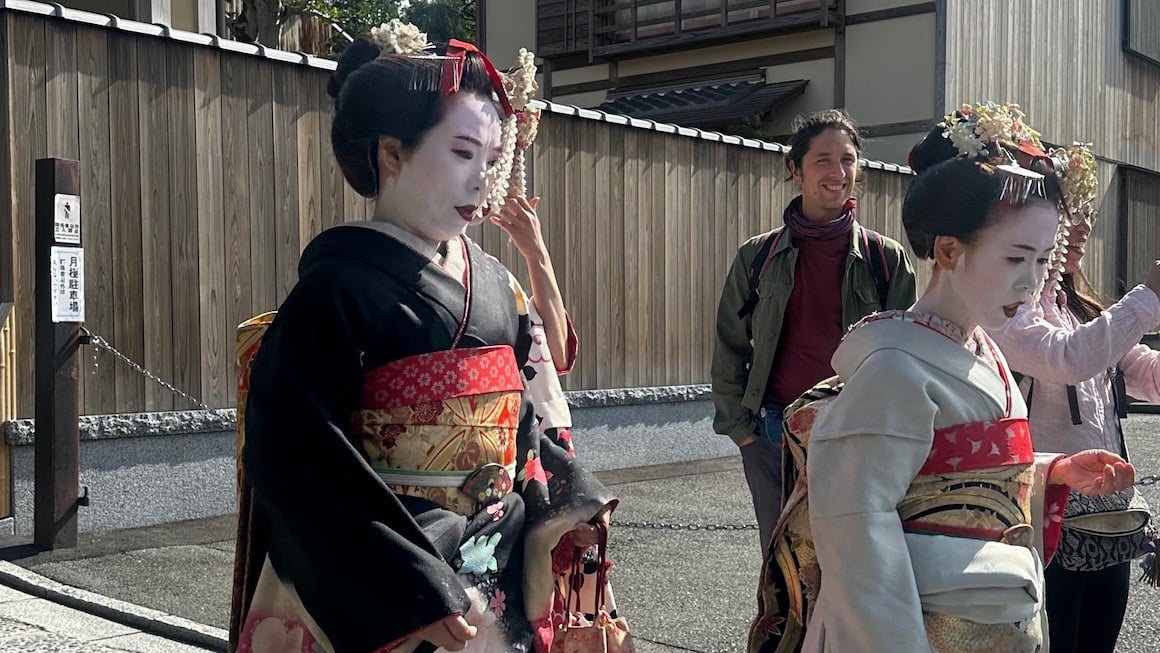
Gion is Kyoto’s geisha district. It has held this title for centuries, and you’ll find a lot of traditional Japanese style architecture and history here. You’ll also spot beautiful hostesses in colorful kimonos walking down the wooden Tatsumi Bridge and on the streets.
Admire the upscale restaurants and boutiques of the special district. Watch one of the traditional Kyomai dances hosted at Gion Corner.
There’s lots of unique things to do in Kyoto ‘s Geisha district. so be sure to set out a few hours for it. Geisha’s are ubiquitous across Japan.
Geisha, or Geiko (Kyoto’s dialect, meaning ‘arts child’), entertain in traditional Japanese style tea houses. There are also wooden machiya merchant houses lining the street, close together but stretching far back.
The entertainment district is at its most atmospheric in the early evening when lanterns are lit and the sun slowly sets. We are a bit early for this but you can hang around and wait. This is one of the best things to do in Kyoto .
- Cost – Free
- Getting There – Walk here in 15 minutes. Aim for Gion Tatsumi Bridge
5.00 PM – Geisha dance in Gion
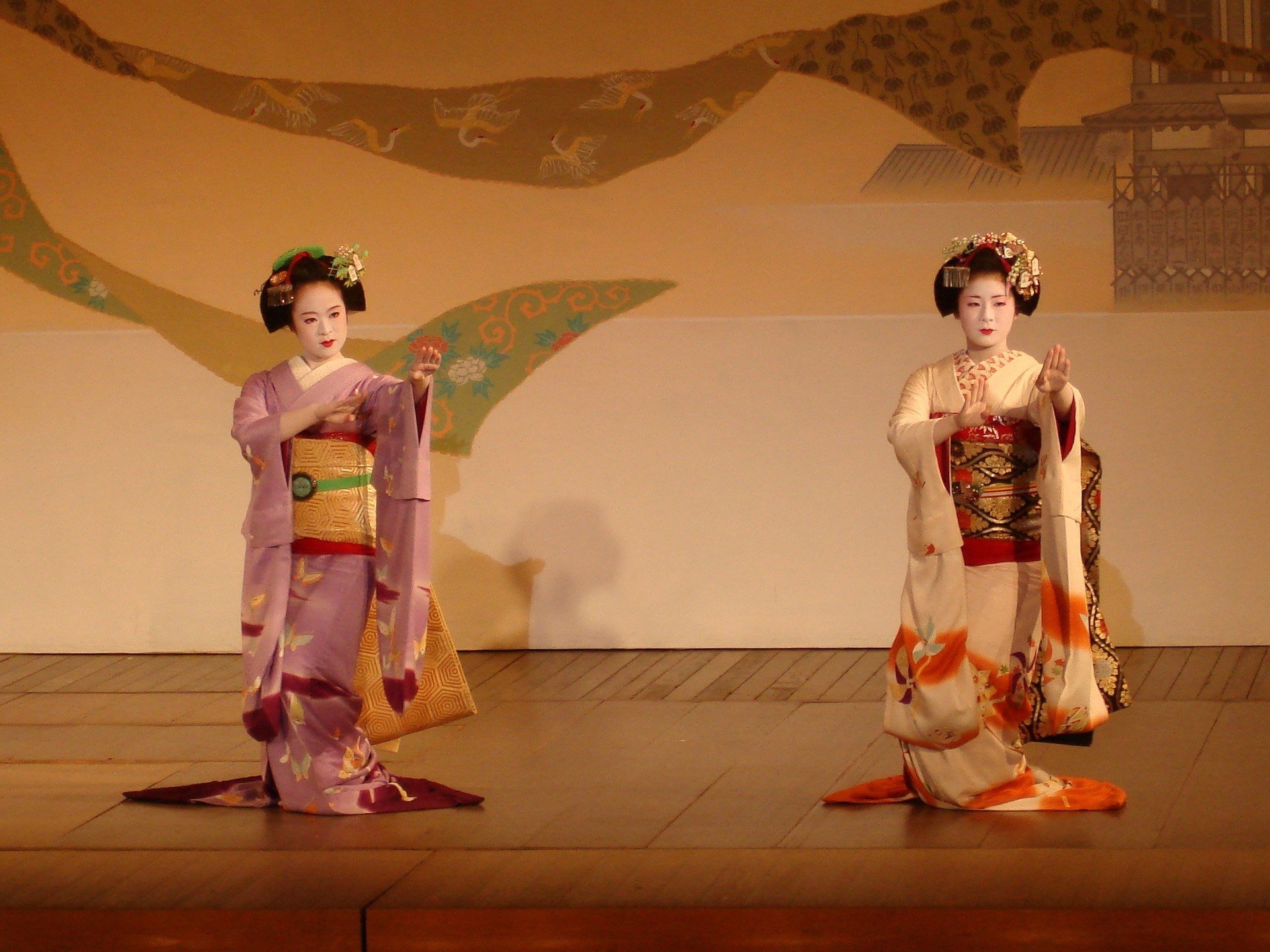
Stopped in tradition and culture, these dances are an art form long recognized in Japan! Once you’ve enjoyed the general delights of the district, enter a tea house if you can (many only cater to locals).
If you’re lucky, you will be able to observe a small performance in one of these teahouses. If you’re very lucky, or a good planner, you’ll be able to see a large performance, put on for the general community!
The five geisha districts of Kyoto put on annual performances for the public, and tourists are permitted to join the crowd. Here geiko and maiko (apprentices) perform with dance and music.
The dances are highly stylized and tightly choreographed. Every move is perfect, their slow and graceful forms hinting at the intensely hard work that goes into them. These dances are considered a great honor to perform in – and are certainly an honor to witness.
Each performance depicts some aspect of Japanese life and the changing of seasons. They are exquisitely beautiful, and certainly an experience you will never forget – a must see in Kyoto.
- Cost – $18 – $40
- Getting There – It’s in the Gion district

Wanna know how to pack like a pro? Well for a start you need the right gear….
These are packing cubes for the globetrotters and compression sacks for the real adventurers – these babies are a traveller’s best kept secret. They organise yo’ packing and minimise volume too so you can pack MORE.
Or, y’know… you can stick to just chucking it all in your backpack…
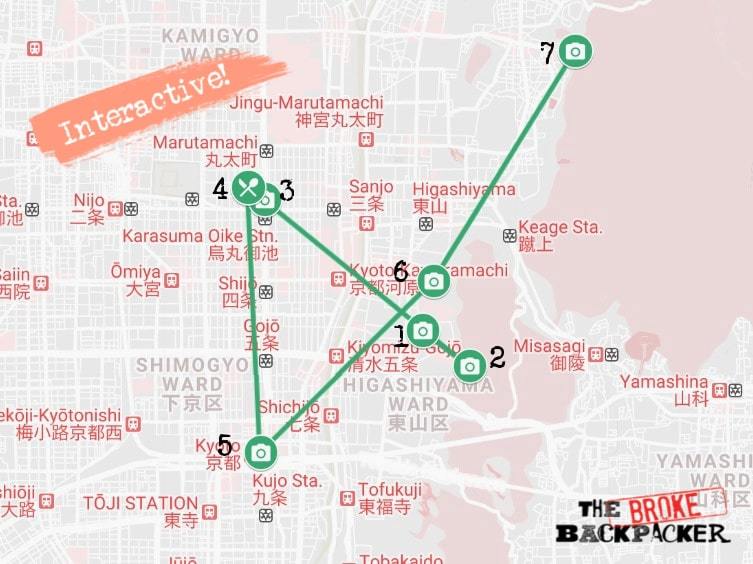
Explore nature, modern Japanese architecture and art, and of course more temples on day 2 of my Kyoto Itinerary! It’s going to be an incredible day.
9:00 AM – Yasaka Pagoda
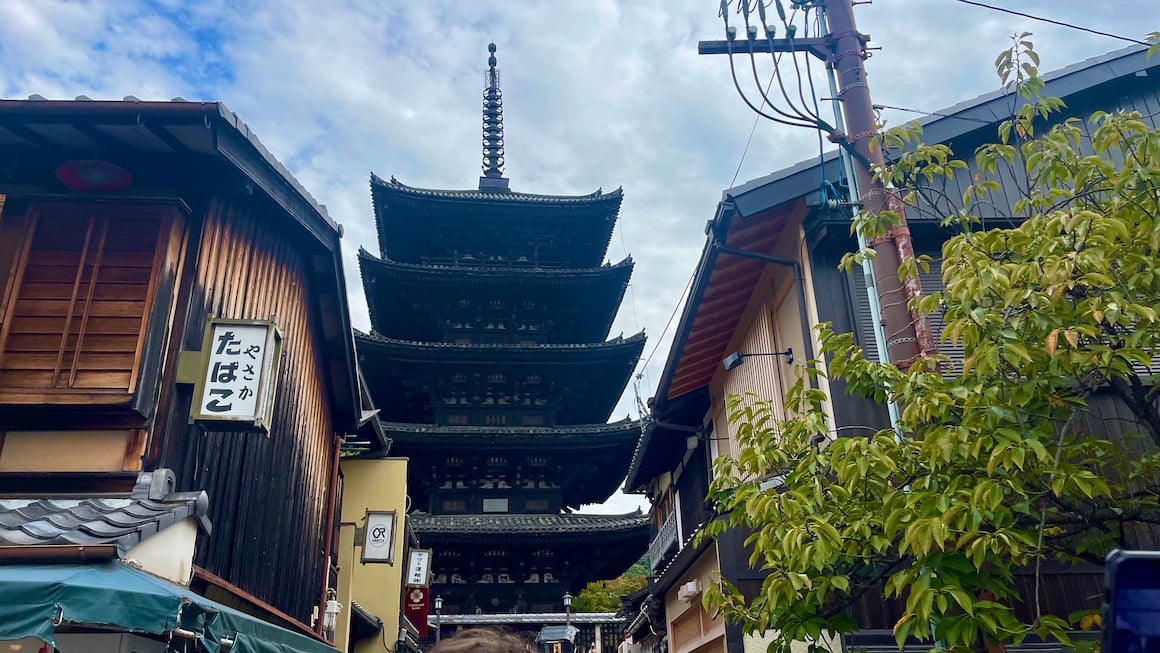
Also known as Hakanji Temple or Yasaka-no-Tou, this pagoda is perfect. With an iconic design and great location, it feels like you’re in an old Japanese movie as you look at it.
Yasaka Pagoda, the last remnant of Hokanji Temple, is one of the most recognizable landmarks in the district. Occasionally the interior is open to visitors, which is a rare opportunity.
Almost all pagoda can only ever be viewed from the outside. However, you’ll be hard-pressed to find out when public viewings are available unless you go and ask in person.
Still, it’s worth the visit just to see the outside! A 46-meter tall pagoda with graceful, sloping roofs on every tier, it lies in the middle of an old Kyoto neighborhood in Higashiyama which is wonderful to walk through. Admire the scene, old ladies sitting and gossiping together, light wooden buildings and cherry trees.
If you do get to see the interior, you’ll have the opportunity to Visitors are allowed inside to marvel at the tower’s architecture, statues and fading paintings. Originally built by the Imperial Prince Shotoku in 589, the pagoda is said to have been inspired by a dream.
- Cost – $4
- Getting There – You can reach the Pogoda by bus
10:00 AM – Kiyomizu Dera Temple
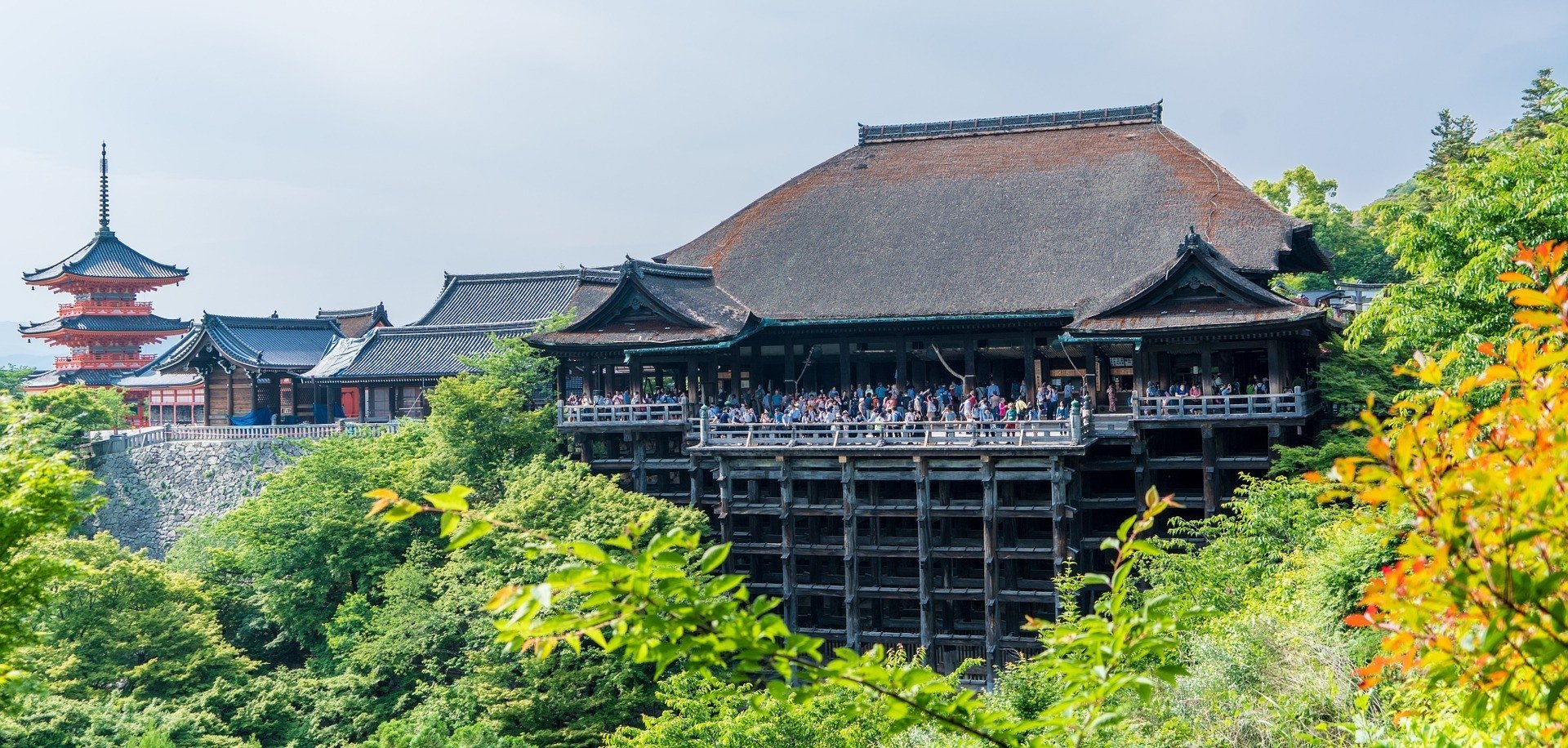
Kiyomizu Sera, or the ‘Pure Water Temple’, is one of the most beautiful and celebrated temples of Japan. Founded in 780 AD on the site of the Otowa Waterfall, it derives its name from that waterfall’s waters.
The temple is nestled in the wooded hills east of Kyoto, but you will be able to catch a bus to the area and stroll along a path through the forest to get there. It’s a great opportunity to leave the city for a few hours and admire the surrounding area.
Kiyomizu Dera Temple has a wooden stage that extends from its main hall, 13 meters above the hillside below. Here visitors have a fantastic view over the cherry and maple trees surrounding the temple. These are a sea of color in Spring! You’ll also see Kyoto in the distance.
The Otowa Waterfall, at the base of the main hall, has its waters divided into three separate streams. Visitors drink from them using cups attached to long poles. The waters are said to provide longevity, success, and love. But drinking from all three is considered greedy!
The main hall and stage were built without the use of nails! In the hall, you’ll find a golden statue of the eleven-faced, thousand-armed Kannon. This is a deity of compassion and mercy, and the temple’s primary object of worship.
- Cost – $6
- Getting There – It’s a 15 minute walk
11:00 AM – Kyoto International Manga Museum
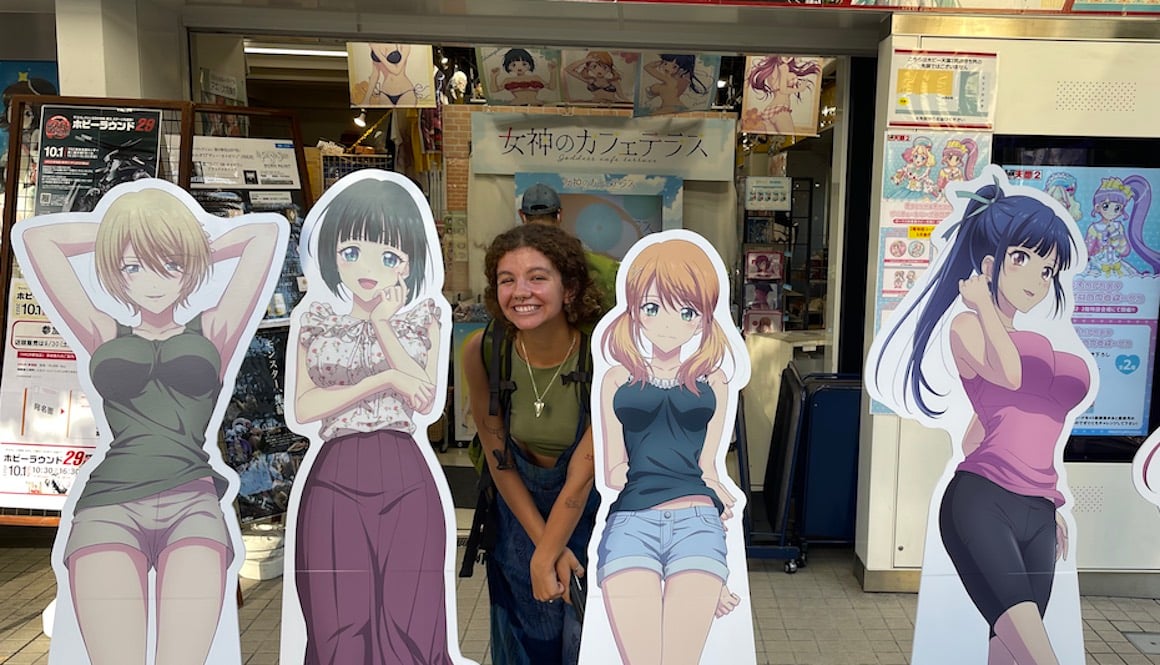
For something a little different and a little more modern, visit the Manga museum! Just as much a part of many Japanese people’s lives as the temples you’re visiting, Manga is very important in Japanese culture.
Manga are comics or graphic novels rendered in a very specific style, with their roots in Japanese art. Japanese people of all ages read manga! The comics cover every genre, the most popular of which are adventure and erotica.
You’ll enjoy how absolutely different the style is from western comics!
The museum is extensive, its walls lined with shelves of Manga. Most of the works are by Japanese artists, but there are exhibitions of foreign work as well. It also features frequent temporary exhibitions in different themes.
The museum was once a school, and some relics from its very different past are on display! It’s a fun and unusual place to spend an hour or two and one of the best, offbeat things to do in Kyoto.
- Cost – $7
- How Long Should I Stay Here? 60 mins
- Getting There – Take the 95 bus from Gojozaka to Karasuma Oike
12.00 PM – Lunch at Shishin Samurai Restaurant
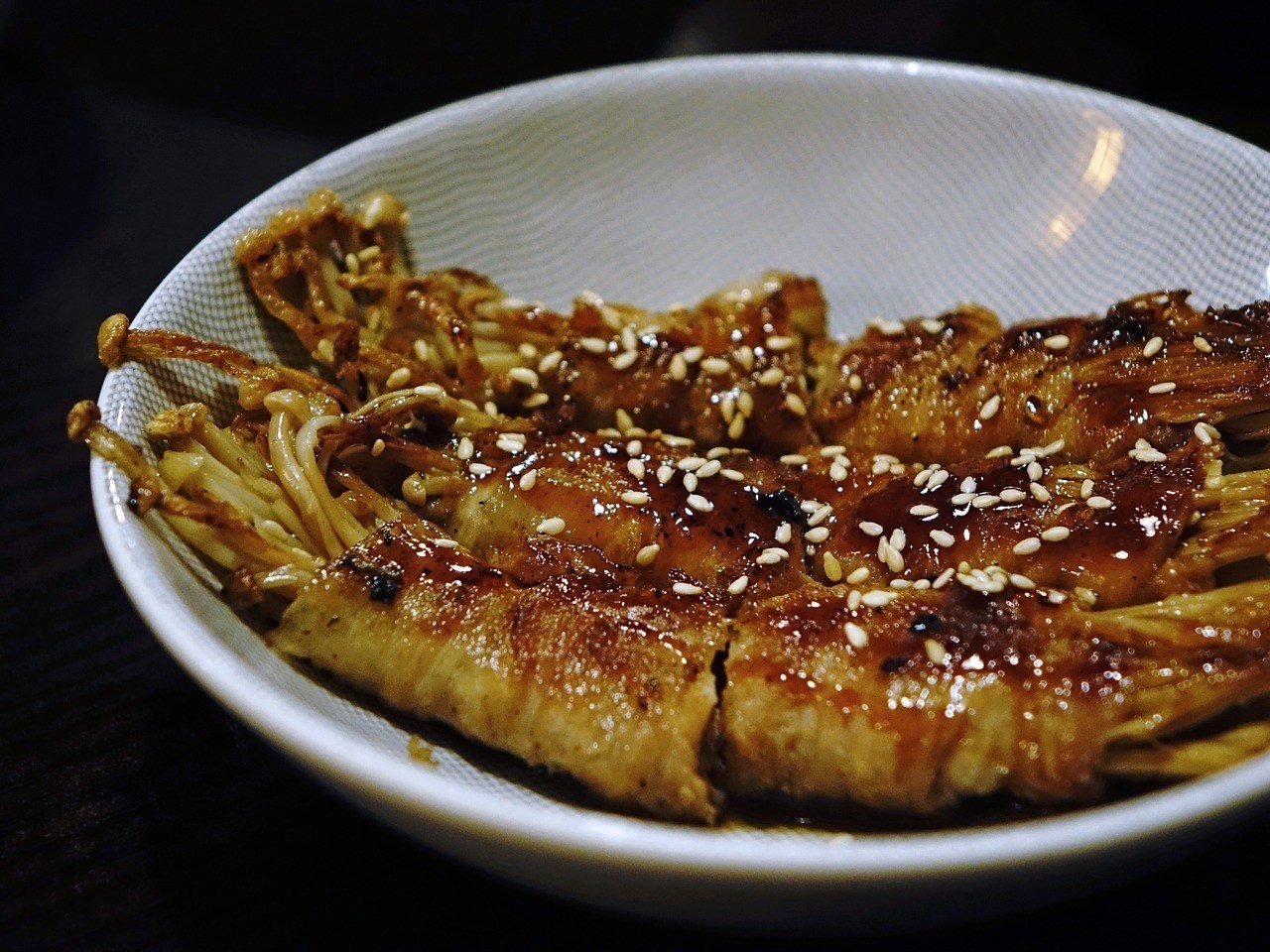
Feeling hungry? I hope so because my Kyoto itinerary next stop is Shishin Samurai Restaurant.
Housed in a traditional, 100 year old building, the cuisine is traditional “Samurai” food made using award winning Tofu and fresh, organic vegetables.
The grilled omi beef is delicious, the Samurai burger filling and if you want something light and green then check out the Samurai salad.
- Cost – Budget $20- $30 per person
- Getting There – You can walk from the Manga museum
1.00 PM – Kyoto Station Building
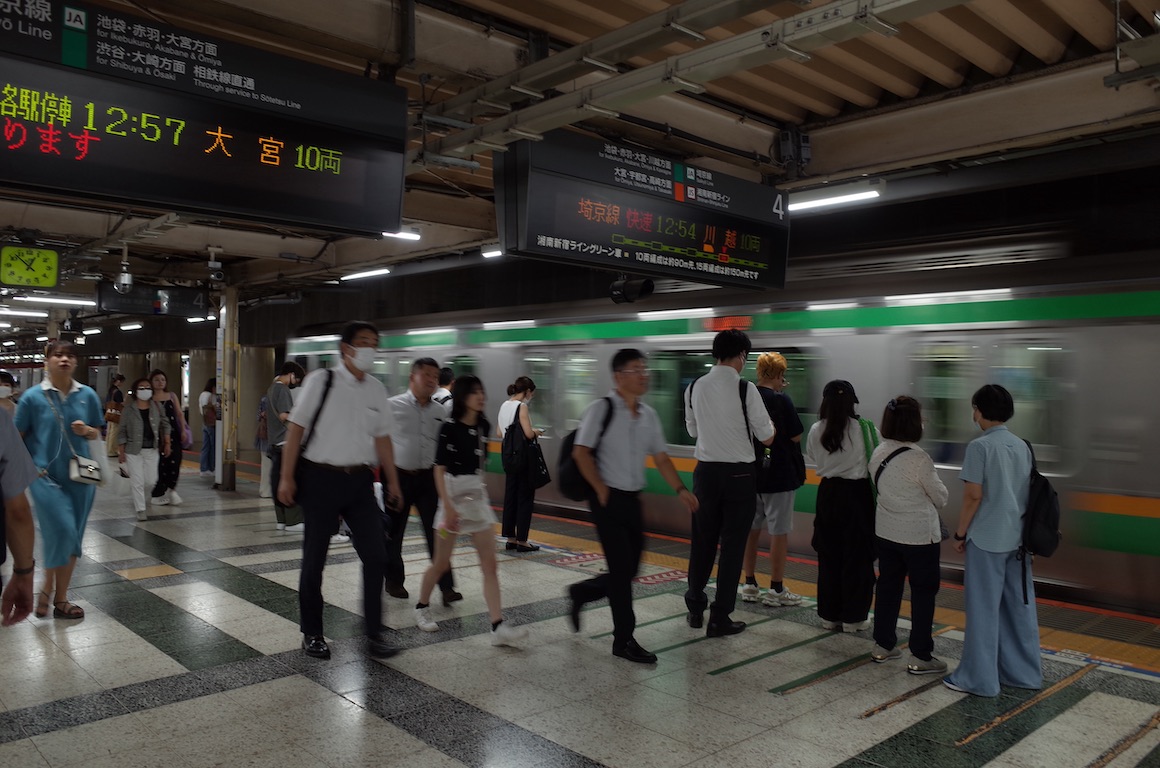
You would think this is an odd choice, being a train station. But the Kyoto Station Building showcases really impressive modern architecture! It’s also one of the best places to shop in Kyoto.
An ultra-modern structure of glass and steel, the station building houses a brilliant amount of shops, restaurants, and recreational facilities.
If you’re looking for anything specific while you’re in Japan, this is where you’ll find it.
Of course, you can also catch a train! Japanese trains are incredibly fast and efficient. If you’re going to Tokyo or Osaka (or anywhere else in Japan) this is the best way to get around!
The station is enjoyable even just for its dramatic and imposing size. But there are plenty of maps, so don’t worry about getting lost! Whether you want to window-shop, buy something, or bring the kids someplace they recognize better than the temples, this is a great place to visit in Kyoto.
- How Long Should I Stay Here? 30 mins
- Getting There – Take the Karasuma (Green line) metro to Kyoto station
2.30 PM – Maruyama Park
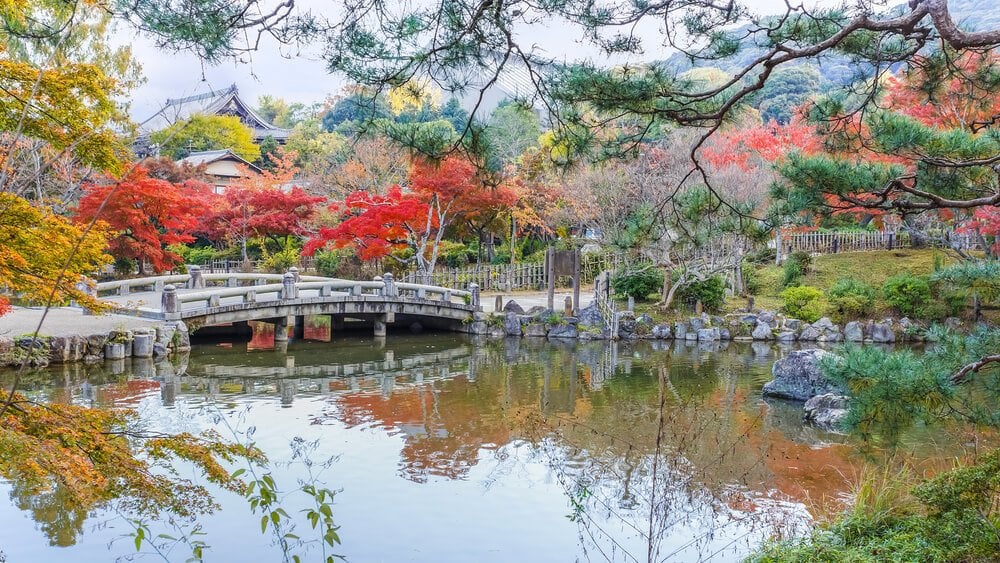
This public urban park is incredible in Spring! The cherry trees blossoming turn it into an ethereal landscape, and you feel like you’re on another planet. Any other time of the year though, it’s still a great place to visit in Kyoto!
The park’s centerpiece is a famous weeping cherry tree and gets lit up at night.
You’ll be here in the evening, enjoying the park’s beauty in the golden hour! It’s a very popular park, so this is also a great time to go for the reduced crowds.
The park has a lovely duck pond, gurgling streams and plenty of trees. You can even enjoy a drink here, as Japan allows for drinking in public. It’s the perfect place for an evening picnic and some good end-of-day unwinding! Perfect for families and couples.
It’s also a great place to do some local people-watching! Residents of Kyoto love to hang out in the public space, and it can get quite a party vibe as the evening progresses.
No matter the season, be sure to bring your camera and take advantage of some great photo opportunities!
- Getting There – Take the bus from Kyoto Eki mae to Gion
4.00 PM – Ginkakuji Temple
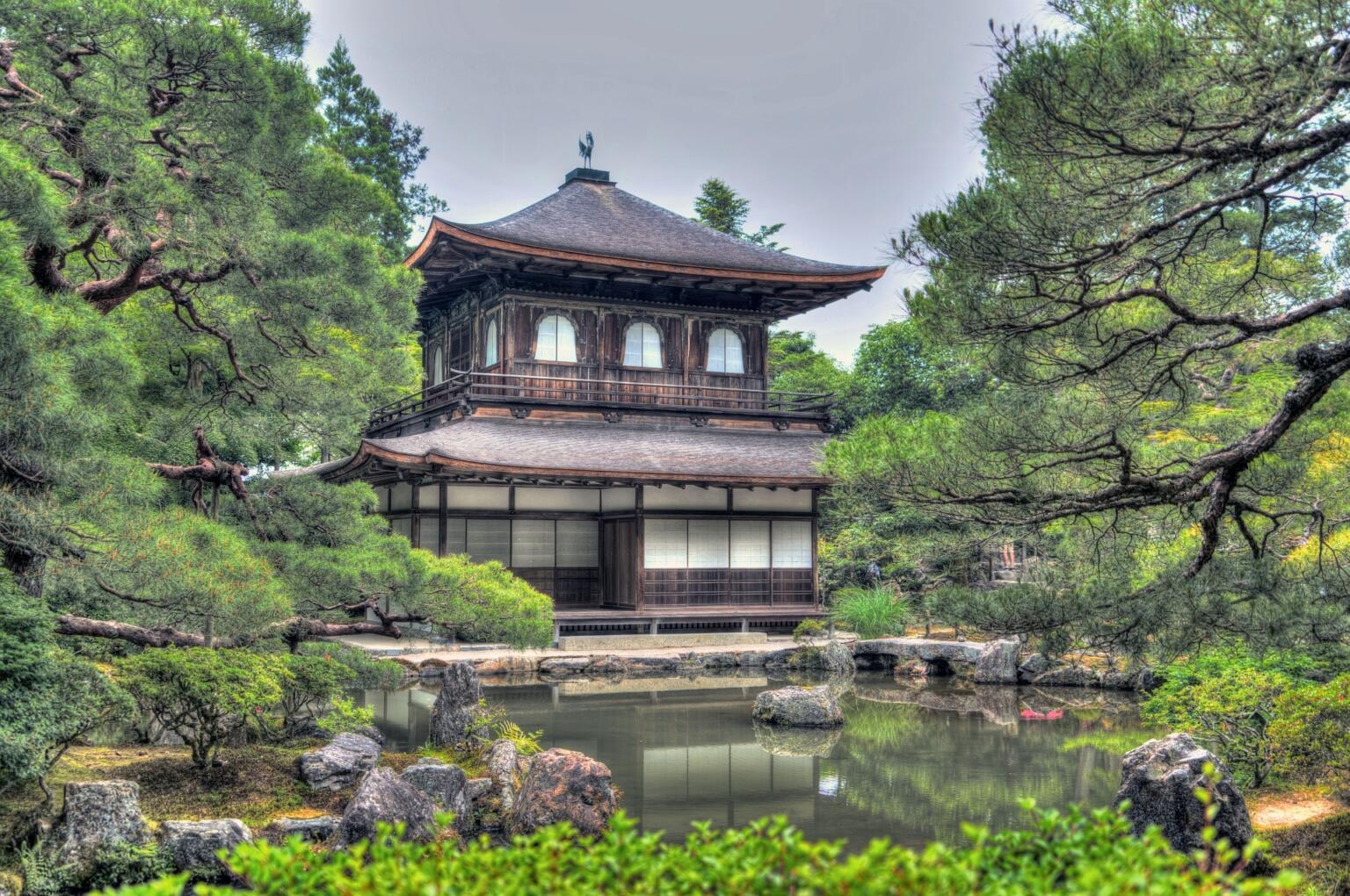
Ginkakuji Temple, or the Temple of the Silver Pavilion , is elegant and lovely. Set at the base of the mountains, its entire temple grounds are gorgeous. A perfect example of curated Japanese landscape architecture.
Walk the trails around the temple grounds, lake, and gardens, and admire the raked sand garden, sit and look up at the blue sky through the trees.
The gardens are a perfect post-lunch relaxing spot!
Modeled on its sister temple, the Golden Pavilion, the zen buddhist temple complex is not quite aptly named. Its walls are wooden brown and were never plated with silver. The Zen temple was once a retirement villa for the grandchild of the Golden Pavilion’s creator – hence its nickname.
Ginkakuji consists of multiple smaller temple buildings, and houses a statue of Kannon! You’ll find the temple beautiful from every angle. It’s also much less crowded than its sister. You can stroll around in relative peace and quiet.
- Cost – Free
- How Long Should I Stay Here? 3o minutes
- Getting There – Bus again! From Gion to Ginkakuji mae
Need a place quick? Here’s the best neighborhood in Kyoto:
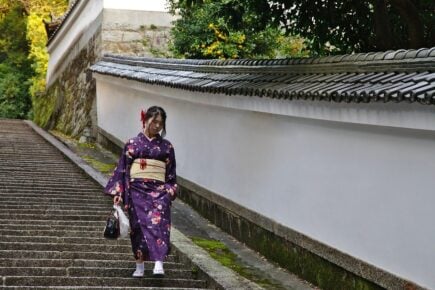
Southern Higashiyama
Southern Higashiyama is home to many of Kyoto’s most famous and popular tourist destinations. If you haven’t been to Southern Higashiyama, you haven’t been to Kyoto!
- Step away from the typical tourist trail and explore lesser-visited temples such as Kodai-ji, Shoren-in, and Entoku-in.
- Try and spot geishas in Hanami-koji.
- Admire Yasaka-no-to Pagoda.
- Watch a spell-binding performance at Minamiza Kabuki Theatre.
There is so much to do in the greater Kyoto prefecture, I hope you’re spending more than 3 days in Kyoto! These are the must-sees that just don’t fit into the busy structure of your first 2 days in Kyoto.
Fushimi Inari-Taisha Shrine
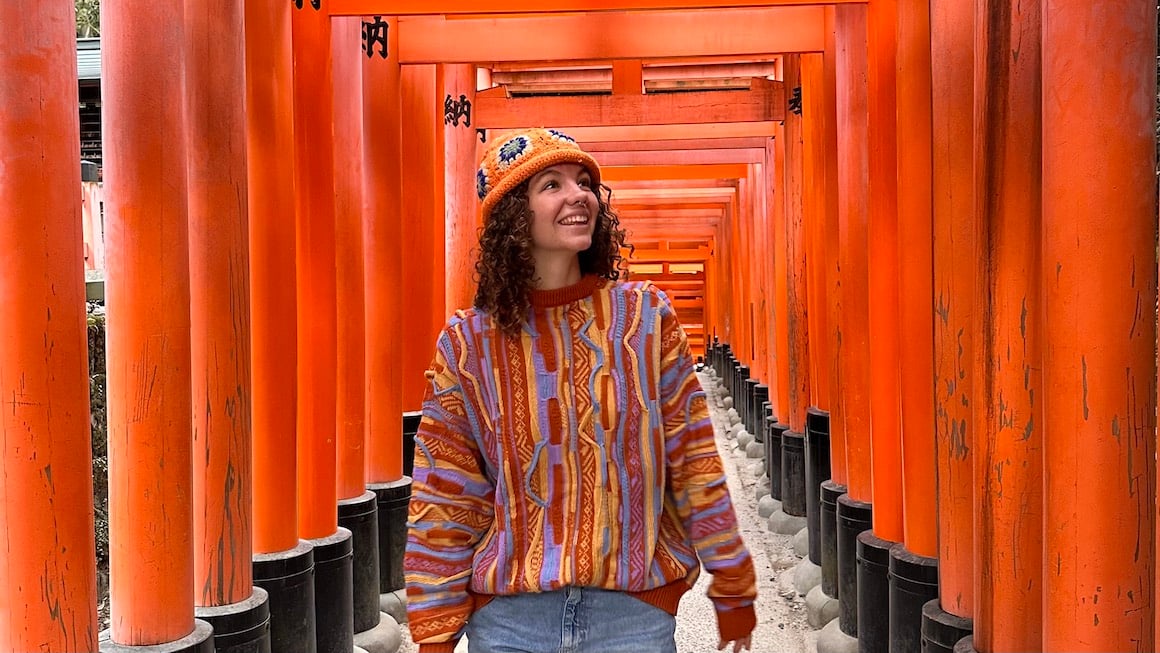
Only 30-minutes from Kyoto by train, the Fushimi Inari Shrine is an absolute must-see in Japan. With thousands of vermilion Torii gates and some really impressive buildings, it’s one of the most iconic holy places in the world.
The Torii gates symbolically mark the transition from the mundane and earthly to the sacred. That’s quite a transition!
They stretch up past the shrine buildings, lining numerous paths up the mountain. You can walk all the way up the Inari mountain between the gates, finding smaller shrines as you go. The scene from the top is amazing, with Kyoto is the distance amidst the green mountains.
The Shinto god, deity Inari is the god of many things, including rice and business! The shrine is so immense because of the deity’s patronage of business. Each of the torii gates has been donated by a Japanese business or individual. Look on the back of a few of the gates – the donor’s name and date of donation are inscribed on the back of each of them.
You’ll also find stacks of miniature torii at the smaller shrines on the mountains. These are donated by people seeking success without the budget of the larger companies! Bring your camera and some comfortable shoes, and get ready for an amazing Fushimi Inari hike . This stop is definitely one of the top Kyoto attractions and a worthwhile climb!
- Cost – $3
- How Long Should I Stay Here? 120 minutes
- Getting There – It’s just outside JR Inari Station
Japanese Izakaya Cooking Class
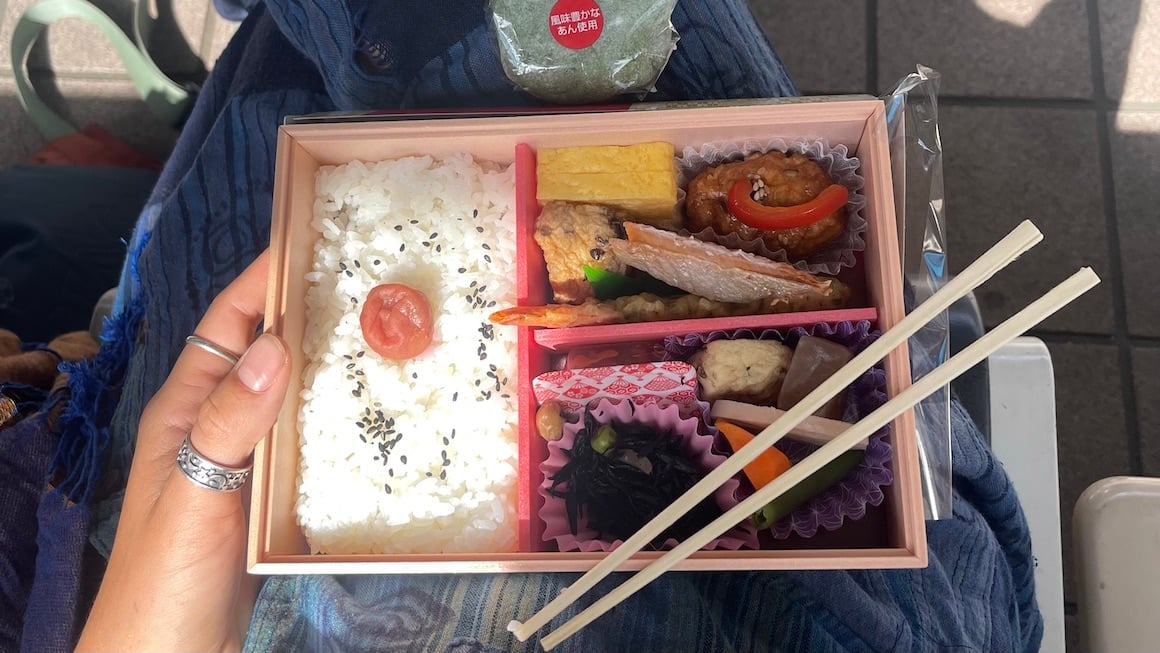
Immerse yourself in the famous Kyoto foodie culture and learn how to make home-style Japanese dishes.
An izakaya is an informal Japanese space for casual after-work drinking and tapas. Lasting 3-hours, the course covers a surprising amount of Japanese food. You’ll learn to make 2 or 3 local dishes, chatting and learning from your chef, before eating them together in a fantastic communal experience.
When you’re full and happy you’ll make another 2-3 dishes, allowing the food to settle while you learn. This is the perfect activity for foodies, families, couples, and people interested in learning an element of the local culture.
- Cost – Varies
- How Long Should I Stay Here? 2 to 3 hours
- Getting There – Take the metro to Funayacho, Shimogyo Ward, and walk to Cooking Sun.
Monkey Park Iwatayama
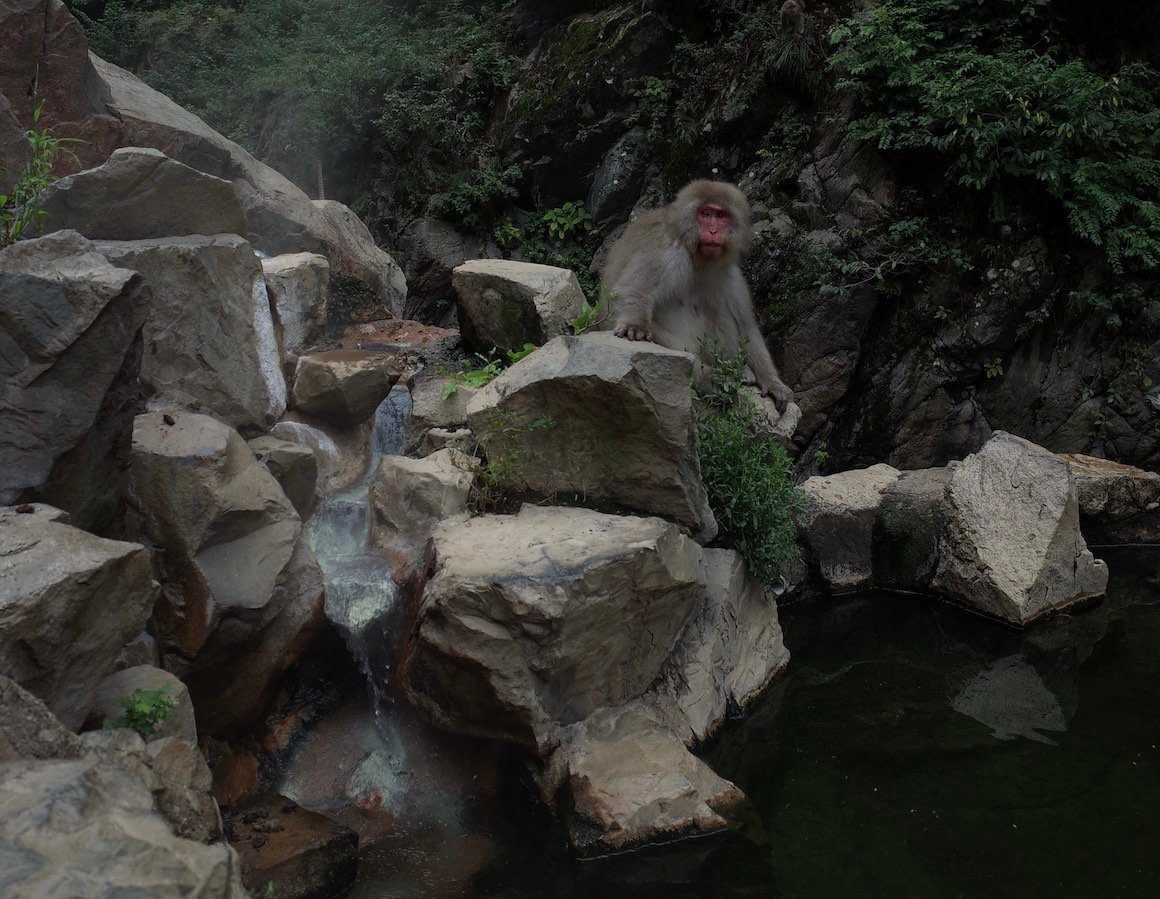
If you’re feeling a little overloaded from all the temples and shrines, take a little hike up this nearby hill to visit the Monkey Park. With only a $5 USD entrance fee and a very casual setup, it’s a great place to experience something entirely different.
It’s a 30-minute hike and quite steep, so, unfortunately, those with physical limitations may struggle. It’s also not wheelchair friendly.
But you can take it as slow as you need to, and you’re well rewarded at the top!
The snow monkeys, also known as “Japanese macaque” are native to Japan, and really beautiful. It’s refreshing to see them outside of a cage, enjoying life in their natural habitat and relaxing in the sun.
- Cost – $5
- How Long Should I Stay Here? 2 hours
- Getting There – A 3-min walk from the Togetsukyo Bridge
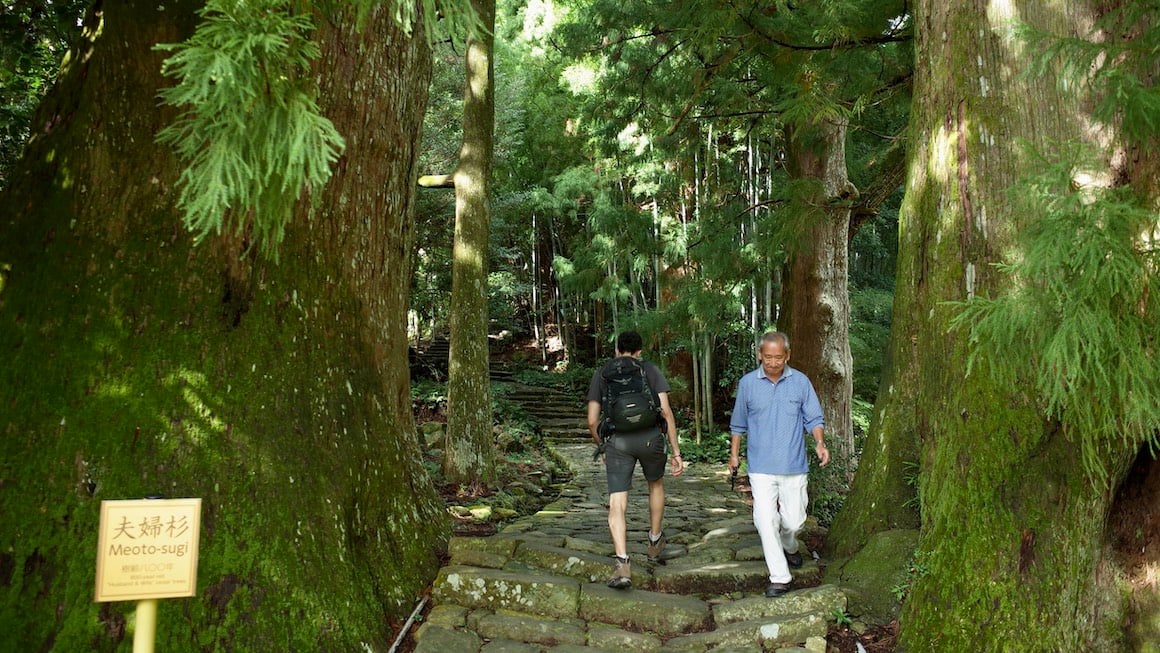
If you have half a day to spare, one of the greatest Kyoto points of interest is in its greater prefecture! Said to be the home the King of the Tengu – legendary creatures in Japanese folk religion – this mountain is mysterious and immense.
On the mountain, you’ll find Kurama, a rural town best known for its hot spring and beautiful Kurama- temple. The hot spring is one of the most easily accessible from Kyoto!
You can enjoy traditional outdoor and indoor baths at Kurama Onsen, at the upper end of the town.
The train stops just 10-minutes walk from the town. Stroll along the nature trail that follows the river. If you’re so taken with the little town that you want to stay longer, you can! And staying guests can use the baths for free.
If you want to visit the Buddhist temple of Kurama-Dera, you’ll find it located along the steep green mountainside above the town. It takes about 45-minutes to hike up to the temple from the town below. You can also catch a cable car halfway up the mountain, for only ~$2 USD!
The impressive temple’s main buildings stand on a terrace on the mountain slope and overlook the wooded valley. The red postboxes lining the walk, and the buildings’ traditional Japanese architecture with red wooden frames, make for stunning photography and a unique, aesthetic scene. You’ll definitely want to tick this off your itinerary for Kyoto!
Arashiyama Bamboo Forest
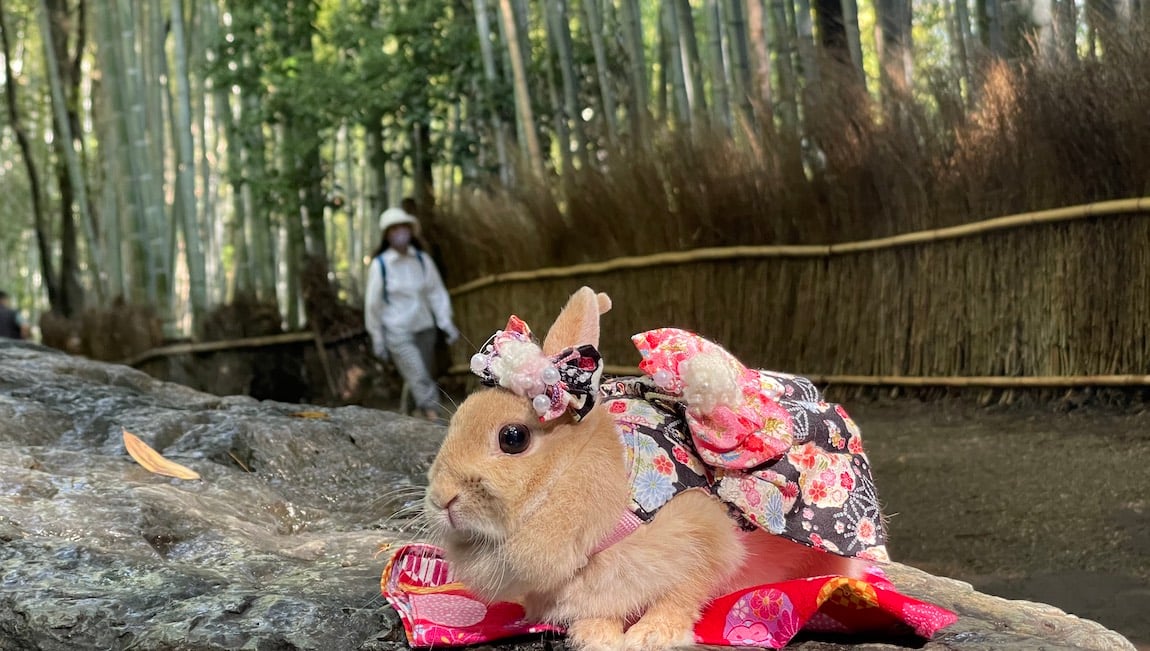
One of my all time favourite things to do in Kyoto is to walk around the famous bamboo forest, Arashiyama Bamboo Forest.
Located at the base of the “Storm Mountains” in north Kyoto, the Arashiyama bamboo forest is a seemingly endless bamboo forest that is perfect for nature lovers who want to escape the hustle and bustle of Kyoto’s busy city center. The sounds of the swaying bamboo grove is eerie and tranquil, and if you really want to enjoy it, you can opt for a traditional rickshaw ride through the groves.
The Arashiyama bamboo grove is an open space, so it’s open 24/7 and is free to enter. However, it is quite far out from other attractions in the city, so that’s why I only recommend going if you have time.
The surrounding Arashiyama district is a well-known fishing village, which involves using trained cormorant birds to dive down and collect the fish – similar to how they fish in the lakes of South China. This is a unique way to catch fish that can only be seen in Japan and China, so it is also well worth adding to your Kyoto itinerary.
The Arashiyama bamboo grove region is also especially beautiful during cherry blossom season, if you’re lucky enough to be in Kyoto at this time.
- Cost: free to enter!
- Getting there: From JR Kyoto station, take the train to Saga-Arashiyama Station. From there, it’s a 15 minute walk to the bamboo groves.
- How long should I spend there? Around 1 hour at the bamboo grove should be enough, another hour at the fishing village.
My itinerary is jam-packed with amazing things to see and some of the best places to visit in Kyoto ! But that doesn’t mean you need to stay in the middle of the city to make the most of it. The transportation in Kyoto is world-class, and you’ll be able to get anywhere in the large city in minutes. So breathe easy, touring Kyoto is a breeze!
The train and subway system is extensive, making it easy to get around the city, and also to reach nearby cities like Osaka and Nara very quickly. Japan is a very small, technologically advanced country, so it’s a great place to travel.
You can also catch the bus to get around the city. They are very reasonably priced and fun! You get on at the back, and depart from the front, paying when you leave. Within the main part of the city, all bus fares are ~$2 USD. You can also walk! But with such efficient, well-priced public transport, and limited time, you may choose not to.
However, my favorite option is cycling! Renting a bicycle for the day is a really great way to explore the city, and you’ll be able to see lots of lovely random things in-between stops. It’s also a common form of transportation in Kyoto, so you won’t be alone!

Stash your cash safely with this money belt. It will keep your valuables safely concealed, no matter where you go.
It looks exactly like a normal belt except for a SECRET interior pocket perfectly designed to hide a wad of cash, a passport photocopy or anything else you may wish to hide. Never get caught with your pants down again! (Unless you want to…)
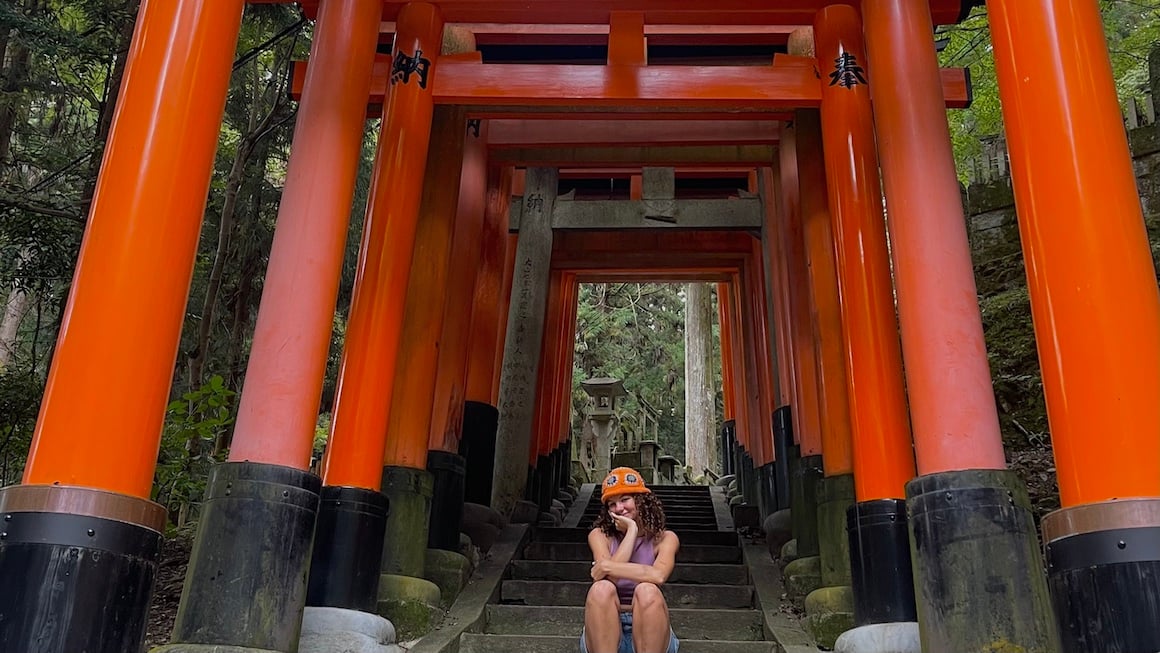
Kyoto’s climate is temperate humid. This means that winters are mild and summers are hot and rainy. The in-between months are best as they’re usually mild and sunny, and very pleasant. Therefore, depending on when exactly you visit Japan , pack accordingly.
Wondering when to visit Kyoto? Spring is absolutely idyllic when the cherry trees bloom and transform the Japanese landscape with their calm, beautiful pink. This starts in April, and is a great time to do a Kyoto walking tour!
Keep in mind, the cherry trees bloom quickly and only blossom for around 2 weeks, so if you’re planning a Kyoto trip for its best season you’ll want to go in the first two weeks of April. The city is very popular at this time so the crowds will be large. But it’s well worth it!
I visited Kyoto in the summer in June, which was rainy season. It was still beautiful but the rain makes the weather quite cold so it’s a good idea to bring some warm clothes, even in the summer!
The city is also gorgeous in Fall, when all those trees go red and orange. In Fall, the rains have ended but the crowds are reasonably small and everything is a little cheaper than during the springtime rush! It’s one of our favourite September destinations for these reasons.
Japan is a very safe country to visit. While Kyoto is a large city and very busy, it is, in fact, the safest city in Japan . You can walk around downtown Kyoto at night in safety.
You can also use public transport alone. This means Kyoto is a really great city for solo travelers – so often I have to make sure I’m inside or in a group by dark. Here you can keep exploring into the night!
Like in every busy city, the flow of people attracts pickpockets. However, the risk is comparatively low. If you keep your bags closed and close to you, you’ll leave the city with everything you arrived with!
While not a safety measure per-se, there are a few things you should do to avoid being rude in Kyoto and greater Japan. Take off your shoes when you enter a home. Don’t eat or talk on the phone while you walk – Japanese folk find it quite offensive, and you’ll definitely get some funny looks. Don’t touch in public, it makes them uncomfortable.
Also, as with any trip, it’s always wise to be prepared for the unexpected. So get yourself protected with good travel insurance . You never need it until you don’t have it.
Don’t Forget Your Travel Insurance for Kyoto
ALWAYS sort out your backpacker insurance before your trip. There’s plenty to choose from in that department, but a good place to start is Safety Wing .
They offer month-to-month payments, no lock-in contracts, and require absolutely no itineraries: that’s the exact kind of insurance long-term travellers and digital nomads need.

SafetyWing is cheap, easy, and admin-free: just sign up lickety-split so you can get back to it!
Click the button below to learn more about SafetyWing’s setup or read our insider review for the full tasty scoop.
Find out what people want to know when planning their Kyoto itinerary.
How many days do you need in Kyoto?
You’ll need a minimum of 2-3 full days to explore Kyoto. However, with so much to see and do, having more time there is definitely recommended.
What should you include on a 3 day Kyoto itinerary?
Don’t skip these top Kyoto attractions: – Kinkakuji Temple – Nishiki Market – Gion District – Maruyama Park
Where should you stay if you have a full Kyoto itinerary?
The central Higashiyama District is the ideal base for sightseeing. It’s within walking distance of main attractions, so you can spend less time travelling and more time exploring!
When is the best time to visit Kyoto?
Visiting in the Fall is best if you want to avoid tourist crowds and enjoy good weather. If you’re after the cherry blossoms, you’ll need to be there at the beginning of April.
Isn’t it wonderful, what you can see and do on a short Kyoto trip? The ancient city has so much to offer, both in Kyoto’s city center and beyond it. And the locals are welcoming and kind!
Whether you’re coming on a spiritual pilgrimage, a foodie foray, or a historical and cultural adventure, Kyoto is one of the best places in the world to do it! You will never walk away from this city disappointed. Not with this 2 days in Kyoto itinerary! There are just too many incredible experiences to be had.
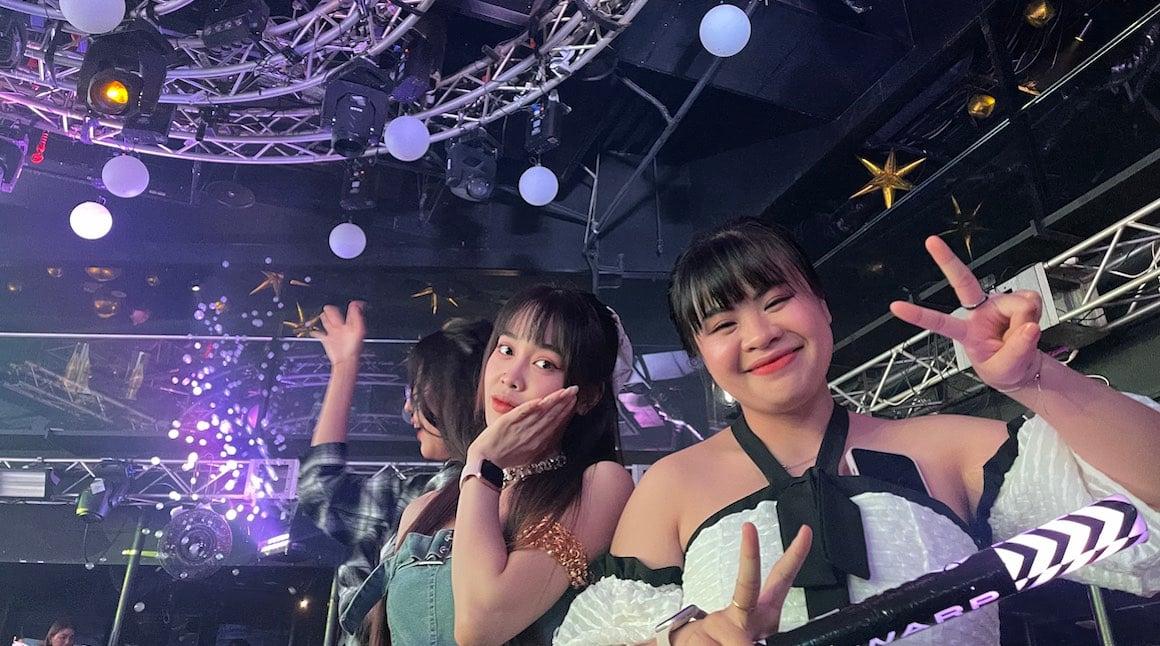
And for transparency’s sake, please know that some of the links in our content are affiliate links . That means that if you book your accommodation, buy your gear, or sort your insurance through our link, we earn a small commission (at no extra cost to you). That said, we only link to the gear we trust and never recommend services we don’t believe are up to scratch. Again, thank you!
Share or save this post

Leave a Reply Cancel reply
Your email address will not be published. Required fields are marked *
Save my name, email, and website in this browser for the next time I comment.
Notify me of followup comments via e-mail.
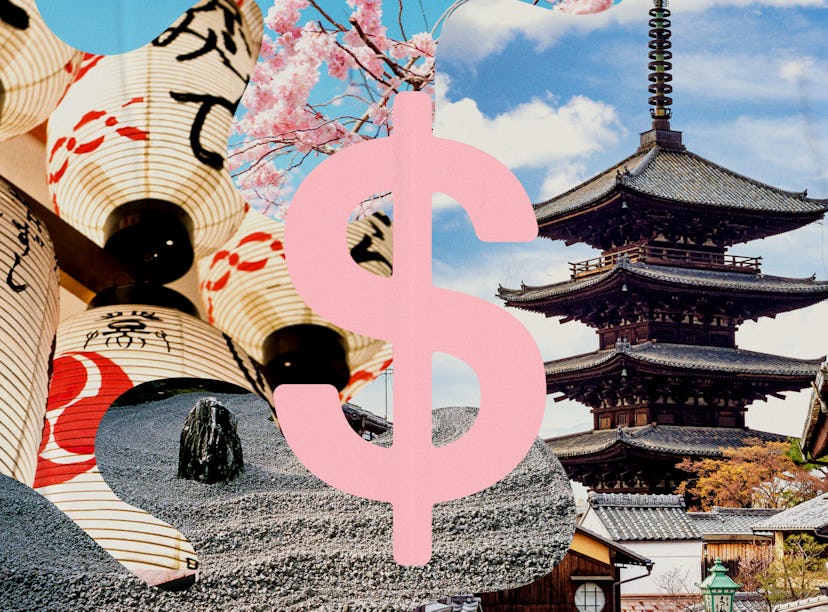
How I Spent 48 Hours & $480 On A Weekend Vacay In Kyoto
Including a secret bamboo forest and vending machine ramen.
Tokyo might be one of 2023’s hottest travel destinations , but head just a few hours west to Kyoto by bullet train, and it feels like you’re stepping back in time. Unlike Tokyo’s neon-lit skyscrapers and electric nightlife, Kyoto’s winding cobblestone streets and ancient pagodas make way for the iconic Japanese temples and shrines you’ve seen all over your FYP. Even franchises like Starbucks and McDonald’s are discreetly housed in picturesque wooden buildings that were built hundreds of years ago. After falling in love with the city during a recent trip to Japan with Hyatt, I put together the highlights for a two-day Kyoto, Japan, weekend itinerary that lets you experience all the city has to offer on a $480 budget.
Making my way to my hotel — the Park Hyatt Kyoto in the historic Higashiyama District — I saw crowds of tourists with iPhones mingling alongside women dressed in colorful traditional kimonos. Similarly, my two-day itinerary in Kyoto leans into the city’s mix of ancient and modern activities, including visiting historic Gion — the best place to spot geishas and visit the teahouses where samurai used to talk political strategy — as well as the happening Pontocho — a lively, lantern-lined alleyway that comes alive after dark with numerous bars, restaurants, and izakayas (late-night bars that serve small plates).
IMO, you could easily spend a week in the city, but this 48-hour Kyoto itinerary distills some of the best food, activities, nightlife, and sightseeing that captures the city’s unique, Insta-worthy charm.
10 p.m.: Arrive in Kyoto, Japan
Once you arrive at Kyoto train station, head to your hotel to relax and beat the jet lag with a hot bath or shower. It costs about 1,100 yen, or just under $8, to get to the Park Hyatt Kyoto from the train station.
Cost of a taxi to accommodations: $8
8 a.m.: Walk around Kyoto’s historic Higashiyama neighborhood
One of the Park Hyatt Kyoto’s managers suggested waking up early to explore two of Kyoto’s most iconic preserved streets — Ninnenzaka and Sannenzaka Slopes — and I’m so glad I took her advice. The empty roads made it feel like I’d stepped back in time, and I was better able to check out the restored buildings and get pictures without the usual crowds of tourists.
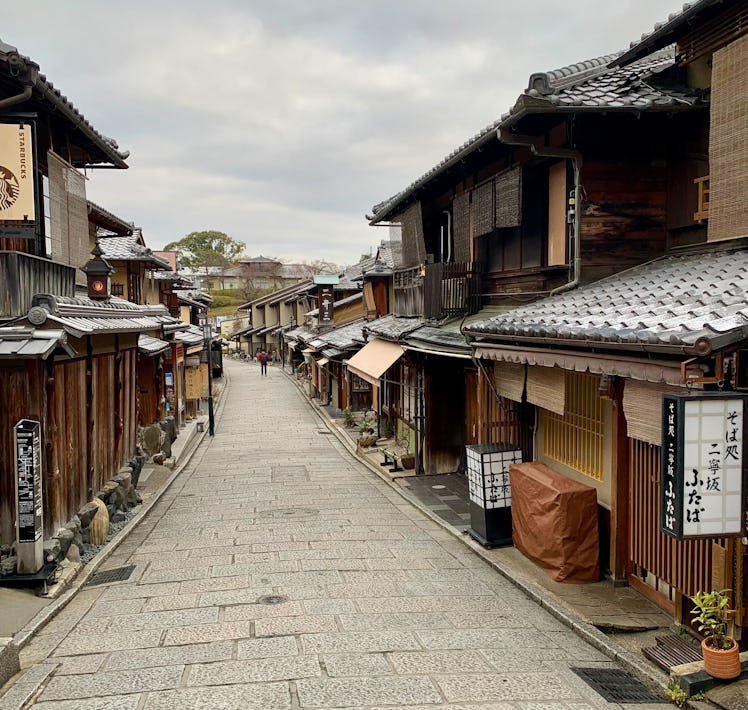
Unfortunately, you can’t shop the stores this early in the morning, but I was able to check out the front merch display of the Hayao Miyazaki-inspired Studio Ghibli store and put together a list of paper and ceramic stores I wanted to visit later that looked promising. This is also the perfect excuse to visit Kyoto’s Starbucks location inside a traditional Japanese house built over 100 years ago. It has specialty drinks and treats like a gorgeous Cherry Blossom Frappuccino, as well as tatami mats (traditional flooring made out of rush grass and straw) and a Japanese garden. IMO, the photo opps are worth the visit alone.
Cost of latte at Starbucks: $4.80
9 a.m.: Start with a traditional Japanese breakfast
As a foodie, trying a traditional Japanese breakfast was high on my bucket list. It usually comes with many small side dishes like pickled veggies and varieties of fish, served alongside fluffy white rice, broiled or grilled fish, miso soup, a Japanese omelet, and green tea.
I ordered mine at Kyoyomato , Park Hyatt Kyoto’s Michelin-starred restaurant that specializes in Kaiseki-style — a traditional multi-course meal with small plates that’s typical of Kyoto. Getting a Kaiseki dinner in Kyoto is a popular thing to do, but I thought this was the more cost-effective route and it crossed two things off my Japan bucket list at once.
I’d never had some of the sides before, and a few of them — like Natto (fermented black beans in a sticky white sauce) and cold baby sardines — were a bit of an acquired taste. But I enjoyed challenging myself to try a little bit of everything.
Cost of a Japanese Kaiseki breakfast: $50.93
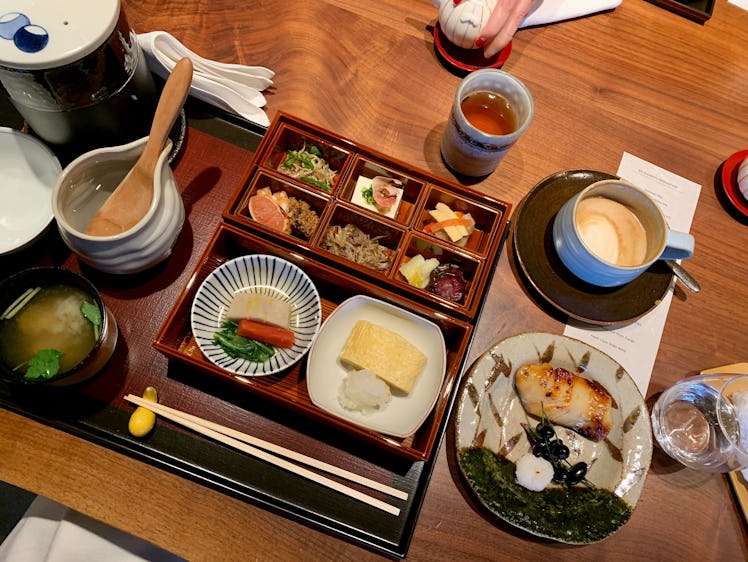
11 a.m.: Visit Kyoto’s Yasaka Jinja Shrine
Once you’re done with breakfast, it’s time to head out on the town for some sightseeing. There are countless shrines in Kyoto, but taking the 20-minute walk to the nearby Yasaka Shrine (also known as the Gion Shrine) leads you through the streets of the Gion District. Chances are you’ll see a geisha or two, and the 1,350-year-old shrine’s bright red pagoda is a popular spot to capture a pic for Insta.
One of my favorite things to do there was get a paper fortune, which you can either keep if it’s good for luck or tie to the wall if you want to physically and symbolically leave it behind you. My fortune told me that I’d have lots of personal and professional hardships before my year turned around for the better, so I quickly tied mine to the wall — no one has time for that energy.
Just keep in mind that all the fortunes are in Japanese, so you’ll need to translate them if you don’t speak the language.
Cost of visiting Yasaka Shrine: $0
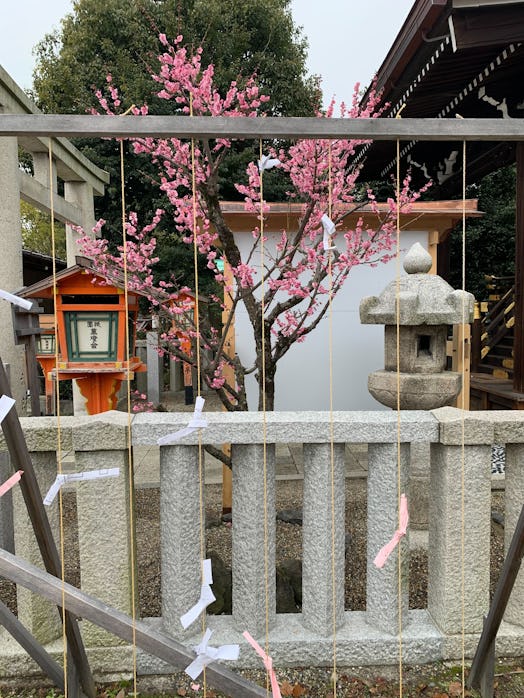
12 p.m.: Make matcha at a traditional Japanese tea ceremony
Walk half an hour, and you’ll get to an award-winning traditional tea ceremony in Kyoto Maikoya . During the 45-minute experience, you’ll get to see how matcha tea is made, and then make your own. The ceremony costs 2,400 yen ($17.17), but you can also upgrade the experience by choosing from a selection of kimonos and having your hair and makeup done (about $37.18). It’s a great photo opp and a delicious excuse to caffeinate mid-day.
Cost of attending traditional tea ceremony: $37.18
2 p.m.: Grab yakisoba noodles and okonomiyaki for lunch
After your tea ceremony, take a 20-minute walk back towards the Gion area to grab lunch at Gionnegiyakikana , a no-frills, wallet-friendly restaurant serving okonomiyaki (a savory Japanese pancake filled with your choice of protein and veggies) and yakisoba (stir-fried noodles in a sweet and sour sauce that come with hibachi-style veggies and protein) with only 12 countertop seats arranged around a sizzling grill. I had to wait about 20 minutes before getting seated at this hole-in-the-wall spot due to a small line outside the restaurant, but the piping hot okonomiyaki, Japanese omelets, and beef yakisoba were one of my favorite things I ate in Kyoto, especially paired with a pint of cold beer.
Cost of getting lunch: $25.43
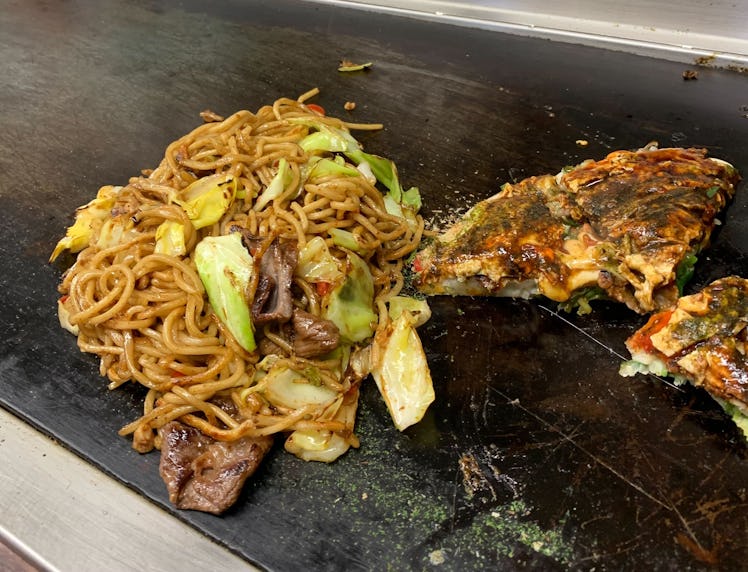
3 p.m.: Shop at stores in the Gion area
After lunch, I stopped by the popular Daimaru Kyoto department store to browse for some souvenirs, and ended up getting a pair of wooden chopsticks and a handmade ceramic tea mug. My 10-minute route towards the Park Hyatt Kyoto also took me back through the shops I’d walked by earlier that morning, and I stopped by one to grab a bookmark made out of Japanese Washi paper and a journal from a paper store. The Studio Ghibli-themed store that I saw earlier had a good amount of merchandise, but the adorable Totoro Squishmallow and Spirited Away earrings inspired by the soot sprites in the movie were on the more expensive side.
Cost of buying a bookmark, ceramic tea mug, wooden chopsticks, and journal: $84
5 p.m.: Relax at the hotel and take a bath
The Japanese are big on taking baths, so I decided to lean into the tradition by filling up my bath with one of the skin-softening bath salts from the hotel and taking a long soak. It was nice getting to close my eyes for a minute and rest my legs after a long day of walking around. Afterward, I made myself a shot of espresso and got ready for dinner.
7 p.m.: Enjoy a chef’s choice Omakase experience at Sushi Imai
Did you even visit Japan if you don’t have sushi? IMO, doing an Omakase (chef’s choice) experience at Sushi Imai is a delicious and authentic way to enjoy it. The $118 tasting experience is expensive, but it’s a good deal for the freshness and quality of the fish, especially compared to similar sushi restaurants in the area. However, it’s definitely not a fancy dining experience — with only nine seats, it’s a pretty intimate, simple atmosphere. Just keep in mind that you’ll be in and out in about an hour, and the chef doesn’t speak much English. Though, if you want to see what kind of fish you’re eating, there’s a booklet with pictures.
Cost of sushi experience and drinks: $130
8:30 p.m.: Grab drinks at Bee’s Knees
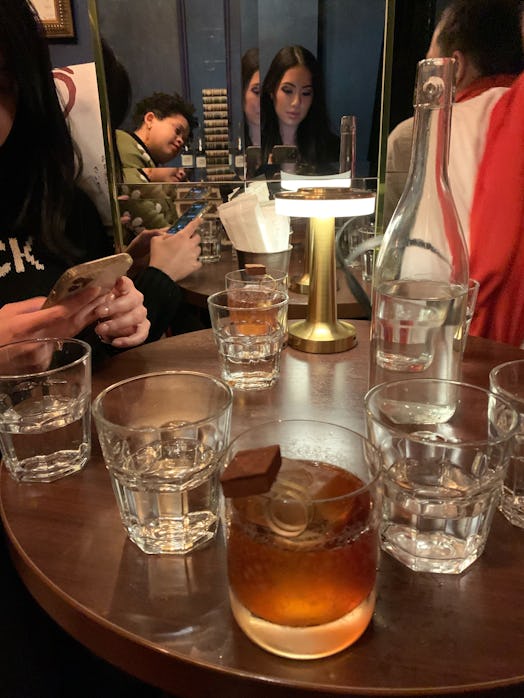
One of the most famous cocktail bars in Kyoto and in the world , Bee’s Knees, near Pontocho, is well worth a visit. If you have time, I’d recommend walking there to see some of the more modern shopping and business areas of Kyoto as well as the cute shops and restaurants along the river. The Prohibition-style speakeasy, which welcomes you in with a sign for “The Book Store” on a bright yellow door, plays ‘90s hip-hop inside and serves up classic cocktails with clever twists and visual effects that’ll make your camera want to drink first. For example, one of my friends ordered a riff on a margarita that had smoke pouring out of it. I enjoyed the Negroni, which came with a piece of dark chocolate, before walking back home to the hotel for an early night.
Cost of two cocktails: $32
8 a.m.: Head to Kurama Hot Springs for an onsen experience
Kurama Hot Springs , the most famous onsen bath near Kyoto, is the perfect way to unwind during the weekend and also enjoy one of Japan’s best wellness traditions in a completely different atmosphere. If you have time and want to spend it in nature, consider taking a hike in the area (300 yen) before enjoying the onsen, which costs 2,500 yen to access the indoor and outdoor baths. It’s a bit of a hike to get to Kurama — it’s a 30-minute approximately $3.36 train ride each way, and then you’ll need to take the free shuttle from the station to get to the onsen — but it’s well worth it to bathe in an outdoor onsen surrounded by lush forests and mountains.
Cost: $17.90 for the onsen, $6.72 for round-trip train tickets
2 p.m.: Swing by the Nishiki food market for lunch
The ryokan (restaurant) at Kurama Hot Springs is pretty expensive, so I’d recommend swinging by Kyoto’s famous Nishiki food market, aka Kyoto’s Kitchen, for lunch when you get back.
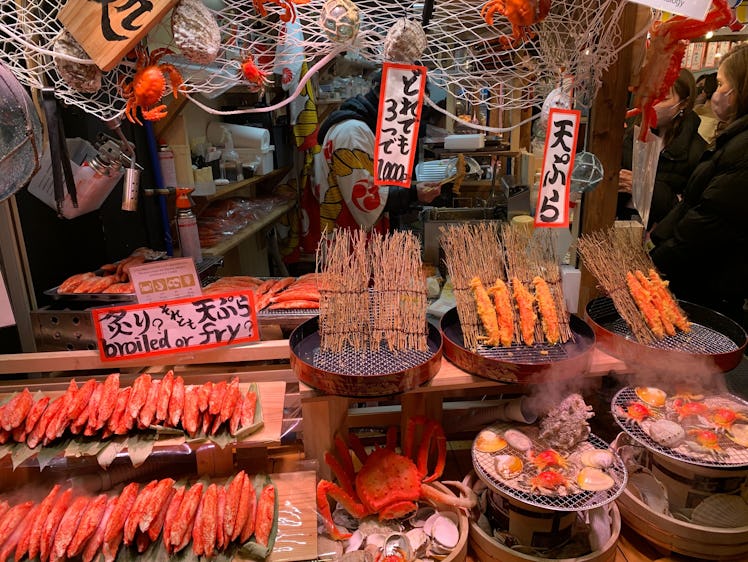
Nishiki food market is a long street filled with street vendors selling everything from seafood and meat skewers to sake tastings and spices. You can also get fresh sashimi and delicacies like sea urchin. One of my foodie highlights from visiting Kyoto was going through and trying a bunch of different things there. Just make sure you have some cash on hand, because most vendors don’t take credit cards.
If you need a snack on the train back to tide you over, try some of the inexpensive fried chicken, tonkatsu sandwiches, or kewpie mayo egg salad sandwiches at the station — they’re actually so delicious.
Cost: $30 for the meat and seafood skewers and hot chili oil to bring home, $5 for an egg salad sandwich on the train back
3 p.m.: Walk through Fushimi Inari-Taisha’s red gates and find the hidden bamboo forest
Fushimi Inari Taisha — a Shinto shrine by Mt. Inari that’s famous for its thousands of bright red Inari gates — is arguably one of the most iconic landmarks in Japan. Snapping a pic in front of the gates was at the top of my Japan bucket list, but getting the perfect shot was a little harder to maneuver than I’d expected due to the tourists. I’d recommend waiting until you’ve walked up the steps for a bit, as the crowds significantly start thinning out when the incline gets steeper.
You can walk the whole Fushimi Inari trail if you want to, but I personally found that the landscape and the gates got repetitive after a while. Instead, I’d recommend checking out one of Fushimi Inari’s lesser-known secrets: a bamboo garden.
To get there, go back to the start of the gates, then walk outside of them to the right instead of going through them. Follow the path past a bathroom, and within 10 minutes, you’ll be in a lush bamboo forest that many tourists don’t know about. It might not be as big as Kyoto’s famous Arashiyama Bamboo Grove , but I loved that it wasn’t flooded with people and was so convenient to get to.
Like other shrines, admission is free. However, you’ll pay about 150 yen each way if you take the train from Kyoto station (it’s about a 10-minute ride, and you’re dropped off right in front of the shrine).
Cost of round-trip train tickets: $2.14
5:30 p.m.: Relax at the hotel and get ready for the night
After a full day of walking and exploring, enjoy some downtime back at the hotel. I took a power nap then got ready for dinner and going out.
7:30 p.m.: Order ramen from a vending machine for dinner
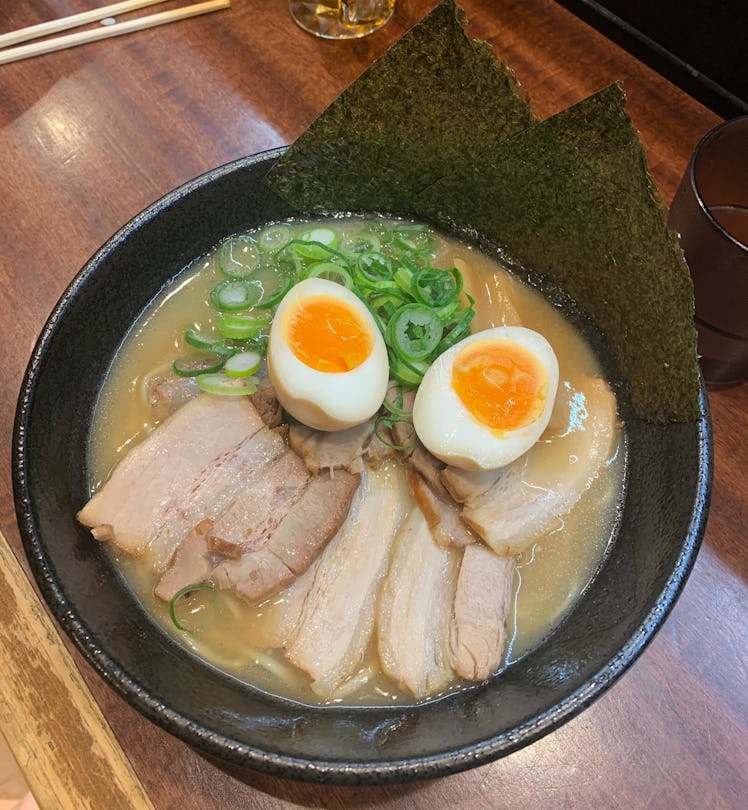
I was planning on going out in the Gion District for drinks with a group, so we decided to try the nearby Musoshin Ramen for dinner. This unassuming spot with only a few countertop seats doesn’t look like much from the outside, and I wasn’t sure what to expect when we had to give our order to a vending machine instead of to an actual waiter (I quickly learned that this is actually pretty common in Japan, especially in train stations). However, the long line outside and the rave reviews online convinced us to give it a shot. The Musoshin with an egg was a delicious bowl of ramen, especially for only $6.80 — the meat wasn’t too fatty, the broth was rich and creamy, and the noodles were the perfect texture. The fried chicken is also delicious if you want to order an appetizer.
Cost of the Musochin ramen with an egg, fried chicken, and beer: $15
8:30 p.m. - 10 p.m.: Get drinks and snacks in Pontocho
Gion, specifically the 500-meter historic Pontocho alleyway that’s lined with red lanterns, is Kyoto’s famous Geisha District. It was hard to figure out which bars and restaurants were closed from the outside as many of them have cloth coverings over the door and darkened windows. However, after a few failed attempts, we stumbled upon Gion Manzana on a side street. It looked like a place where mainly locals were dining, and we decided to order a few plates of sashimi, which were really fresh, as well as izakaya favorites like a beef bowl and hot mustard chicken, along with some sake and beer for the table. It wasn’t as lively as we’d expected, so we called it after a few drinks and headed back to the hotel.
Cost of food and drink: $30.90
This article was originally published on 06.02.23
- Tokyo Cheapo (繁體中文)
A Weekend in Kyoto – Day 1: Westside Story
With over 2000 shrines and temples, not to mention fire ramen, bamboo forests and street markets, the ancient capital has a lot to see over a weekend—and we have the perfect 2-day Kyoto weekend itinerary to make it happen.

With so much to choose from, Kyoto can be a bit of an overwhelming task when it comes to planning. Although just wandering about is fine, with great distances between famous spots and early closing times, it means you can miss out on some of the best bits. Luckily, we have a tried and tested itinerary that packs all the top sights into two days—perfect if you’re on a tight schedule (one of the downsides of the JR pass) and want to see it all. If you have a little longer, stretch it out, take your time and add a few extra spots—it works for everyone. Here’s some transport info for getting there and on getting back to Tokyo too!
Our schedule is pretty packed, and by the end of it you will have a step count worth showing off for sure, as a lot of Kyoto is best seen on foot. The sheer quantity of locations visited have lead to my friends nicknaming it Temple Run though, so be prepared.
Day 1 | West Kyoto | 500 yen bus pass
Day 1 is taking you through West Kyoto, starting at the famed Golden Pavilion and going through to Arashiyama’s bamboo groves, with plenty of spots in between. Starting at the pavilion works out best as it is less crowded, and your afternoon can be spent exploring Arashiyama without fear of closing times looming.
For this day it helps to have the 500-yen city bus pass, which is very good value for money, especially if it’s summer or winter and you don’t want to be outside for too long. Since buses are a fixed rate in Kyoto, regardless of journey length, meaning you go far for your cash. It only takes three bus journeys and you’ve earned your ticket, so it’s definitely worthwhile! You can pick them up at the main bus terminal or from drivers, who will stamp them with the date for you.
Now on to the fun! Although there is a start time here, the following are just estimates, as you can spend longer at sites you like, and less at others.
9am – Bus to Kinkakuji | 金閣寺
You might as well start big and head to the most famous site in Kyoto, and possibly the whole of Japan. Hop on a bus from wherever you’re staying (look out for Raku buses #101 and #102 which connect major tourist spots) and head out to Kinkakuji. From the train station it takes about 45 minutes, so fingers crossed you get a seat and can settle in.

The famous Zen temple has a long and tumultuous history, having been destroyed numerous times in battles and wars alike, and most recently set alight by an angry monk, before it was re-built in 1955. It is part of the Rinzai sect and the top two floors are covered in gold leaf, making it a truly beautiful sight as it sits above the surrounding lake and gardens. There is a small tea house on the grounds which serves matcha (green tea) and wagashi (traditional sweets) if you need a break as well as souvenir stalls towards the end.
Entry: 400 yen | Opening Hours: 9am – 5pm | Open year round
11am – Bus to Ryoanji | 龍安寺
The buses are pretty regular and can be caught from just outside the temple entrance, by the vending machine corner. Use your bus pass and travel a few stops to Ryoanji . This is a stunning Zen temple with the most famous rock garden in Japan—with promises of enlightenment of you manage to see all 15 carefully positioned rocks from one view point.

The rectangular garden has an unclear past, although the temple itself was originally a Heian aristocrat’s villa before becoming a Zen temple in 1405. There are numerous theories about the rock garden, but even if you don’t reach enlightenment, it’s very relaxing to look out over the garden from the Hojo steps and contemplate life.
Entry: 500yen | Opening Hours: 8am-5pm (March-Nov) 8:30am-4:30pm (Dec-Feb) | Open year round
11:45am – Bus to Ninnaji | 仁和寺
Ninnaji is a nearby World Heritage Site and head temple of the Shingon Sect of Buddhism, with a a stunning pagoda. Although the temple dates back to the 9th century, none of the current buildings are original due to the usual story of fire and war (but no monks this time).

You can pay to enter the Goten (the head priest’s residence), which has beautiful rock gardens and buildings in the style of an imperial palace, or just stroll through the gardens to see the pagoda. If you hit Kyoto at the end of cherry blossom season, they have plenty of later-blooming ones here, so it’s a good spot to visit in late April.
Entry: 500 yen | Opening hours: 9am-5pm (4:30pm Dec-Feb) | Open year round
12:45pm – Train to Arashiyama, Lunch
From Ninnaji, walk directly out of the fantastic entrance gate and down towards Omuro-ninnaji Station. This takes just a few minutes and is very easy to spot. It’s a small local Randen station with just two platforms, so head to the far side and wait for the next tram to Katabirannotsuji (with signs for Arashiyama on the platform you can’t go wrong).

You do a quick change at the final stop and hop on the connecting train to Arashiyama. (Note, on Hyperdia it is the Arashiyama Tramway option, on Google Maps it is just Arashiyama Station, with the Kimono Forest). If you arrive with weary feet, the station has a foot bath you can enjoy for ¥ 200 , so this may be a good chance to rejuvenate those tired toes at the end of the central platform. There are also street food stalls and restaurants locally, so this is a great spot to take a break for lunch.
Trains run every 10 minutes | Journey time: 22 minutes | Ticket price: 220 yen.
1:30pm – Walk to Tenryuji | 天龍寺
Another World Heritage Site and the most important Buddhist temple in Arashiyama, Tenryuji is the head of its own school within the Rinzai sect.

Built to appease the spirits of an emperor in 1339, the buildings have been re-built over time, with the current oldest dating back to the Meiji period. The garden, however, has survived and is a beautiful example of landscaping with a central pond and the stunning backdrop of the Arashiyama mountains. Note that there is an additional 300-yen charge to enter the buildings.
Ground entry: 500 yen | Opening hours: 8:30am-5:30pm (5pm Oct-March) | Open year round
2:15pm – Explore Sagano Bamboo Forest & Nonomiya Shrine
As you leave the temple you will find yourself in the world-famous Arashiyama Bamboo Forest , with hewn-out pathways and swaying trees creating a magical scene. As you stray further from the temple, the bamboo groves become thicker and taller, with a tranquil feeling descending, despite the (probable) crowds.

Nestled in the forest is the small Nonomiya Shrine, which was originally a sacred house for the Ise Shrine priestesses who were in training and is believed to help single women in their search for love. As these girls were often the unmarried daughters of emperors, the shrine is highly revered and an annual festival takes place celebrating its role in the important training. The shrine has a tortoise stone to grant your wishes within a year and beautiful heart-shaped ema (wooden plaques) for all your matrimonial and child-birth-related needs.
Entry: Free | Opening hours: 9am-5pm | Open year round
3pm – Walk to Otagi Nenbutsu-ji
If you have the time, Otagi Temple is an unusual spot, with 1200 uniquely carved rakan statues surrounding the grounds.

While rebuilding the temple after numerous floods and disasters, head Priest Kocho Nishimura allowed visitors to carve their own statues under his guidance, as he was a keen scultpor. Thus, each is unique with different faces and poses, including some that give away their creation date (of between 1981 and 1991) you may spot a cassette player or tennis racket on your explorations.
Entry: 300 yen | Opening hours: 8am – 5pm | Open year round
4pm – Head to Togetsukyo Bridge
Head back down through the groves to the streets and town, where you can grab a refreshing drink to enjoy by the river, as well as some street food. There is plenty of seasonal ice cream here and the local speciality of yatsuhashi , the folded triangular sweet with a small filling inside—often red bean paste.

There are boats along the river you can rent for an hour or so, which is a lovely way to explore the river, or you can relax at the water’s edge with an ice cream.
6pm – Fill up on Fire Ramen
If you’re keen to try the infamous fire ramen of Kyoto, you can catch the number 93 bus and jump off when you reach Marutamachi Chiekoin bus stop, (probably easier to keep an eye on Google Maps as you travel and hop off when you’re near).

The ramen relies on locally grown green onions, given a special flavor after being torched rather dramatically before you.
7pm – Evening river stroll to Gion
After a fiery dinner, you can walk back down past the castle and towards the Kamo River. Once you reach it turn right just before you get to the bridge and enjoy the narrow streets filled with restaurants and bars. If you decided not to go for fire ramen, you can get a bus all the way back and alight around Kawaramachi so you can explore the Pontocho area and riverside area to your heart’s content.

While Pontocho is expensive, the restaurants and bars running along the smaller river just beside the Kamo are far more reasonable and interesting. Across the river is the famous Gion area which is well worth exploring in the evening for all the traditional sight of Kyoto you’ve seen in guidebooks.
Read Part 2 !
And for the cheapest and fastest ways to get from Tokyo to Kyoto, read our full guide here.
- Kinkaku-ji Temple
- Ryoanji Temple
- Ninnaji Temple
- Arashiyama Station
- Tenryuji Temple
- Sagano Bamboo Forest
- Restaurants
- Menbakaichidai Fire Ramen
- Attractions
Recommended hotels located nearby

Close without accepting
- For Media & Travel Trade

- About Kyoto
Arts & Crafts
- Town & Architecture
Temples & Shrines
Eat & Drink
Festivals & events.
Accommodations
- Activities & Experiences
Sustainable Activities
Morning & nightlife, itineraries.
- Families with kids
Travel Tips
Destination index.

By using this site, you agree to the use of cookies. See our privacy policy for more information. This site uses machine translation, so content is not always accurate. Please note that translated content may differ from the original English page.
Think Local
Aoi Matsuri Festival
Kyoto Travel Comfort Map & Real-time Webcast
Experiences
We will be joining the Japan Addict 2024 convention!
We have renewed our "transportation page", tickets for paid seats at the aoi matsuri available for purchase starting today, we added the new “events in kyoto” brochure (apr 15 - apr 28), experience the beauty of kyoto traditional crafts [pr], dig into kyoto.
What’s New in Kyoto
Things to Do in the Umekoji Area
Kyoto railway museum: a must-visit for families with kids.
Enjoy & Support Traditional Arts at the Kyoto Museum of Crafts and Design [PR]
The Aoi Matsuri festival procession Sales information: Parade Viewing Seats
Kyoto Restaurant Winter Special 2024
Getting from Kyoto Station to Kiyomizu Temple: A Relaxing Route to the Temple that Avoids Heavy ...
Experience Traditional Culture at Kyoto Gyoen National Garden
The Kyoto Sightseeing Bus will run a special route for Kyoto Winter Special Openings
Kyoto Winter Special Openings 2024
A Taste of Kyoto Sightseeing: Things to Keep in Mind in the Kiyomizudera Monzen, Arashiyama, an ...
Transportation

Getting to Kyoto

Getting around Kyoto
Aki no Odori in 2023: Autumn Dance performances hosted by the historic maiko and geiko district ...
Night sightseeing in Kyoto: Enjoy the splendid views and special events
Moon Viewing Events "Kangetsu Kai" in 2023
NAKED Summer Evening Cool World Heritage Site Kamigamo Jinja Shrine
The ❛new normal❜ for tourism in Kyoto
A Muslim Kyoto Resident Shares Her “Favorite Kyoto”
Recommended model itinerariesThe shape of travel “Exploring the aesthetics of ancient people”
Hakusasonso Hashimoto Kansetsu Garden & Museum, Kyoto
Ultimate Indulgence Expeditions (Part 3: Sample Itinerary)
Ultimate Indulgence Expeditions (Part 2: Gastronomy)
What's so Great About Kyoto Anyway? We Asked a Touring Brit What He Loves About the Area
New tours departing from Kyoto Station accompanied by The Kyoto City Visitor Host
The future of Kyoto tourism discussed with international Kyoto residents– Part 2
The future of Kyoto tourism discussed with international Kyoto residents– Part 1
What is most important in making the maintenance and utilization of a cultural property compati ...
Sustainable Beauty from Kyoto – A Dialogue between NEMOHAMO and SARASA YOSHIOKA
Future on the Table: Zero-Food-Waste Kyoto Cuisine
The Little Story of Chopsticks: The Kakehashi Project
Natural Dye from Kyoto – Bringing a 1500-year-old ethical dyeing method to the modern age, Kyot ...
Kyoto Restaurant Winter Special 2023
Following my mother’s wisdom: Learning How to Get Along with My Body – Yakuzen Cuisine
NISHIJIN BEER – Kyoto Beer that Creates Opportunities for People with Disabilities
Moving to Kyoto for the second time: A Café Manager’s Perspective on the Potentials and Values ...
Manji Café :GION COOKIES, MANJI SELECTION, a cookie tin full of “Kyoto” brought to perfection
Drink in The Kyoto Night Sake (s)hopping
How to enjoy Kyoto during off-peak hours: before breakfast, after dinner, and more
Kyoto shrines and temples open to morning prayers and visits
On The Run Through The Kyoto Night Running, Bathing, Drinking
A Colorful and Cultural Night Out at The Theater That's Entertainment Kyoto-style
[Kyoto Beer Lab] Home Brewed Kyoto Craft Beer on The Bank of The Takasegawa River
A city with traditional crafts and innovative art
Monthly and seasonal markets in autumn 2023
Spring Dance performances by the maiko and geiko "Haru no Odori " in 2023
Ecrin, a Button Shop that Has Supported Kyoto’s Dressmaking for Seventy Years
Enjoy “Metal Fittings” in Kyoto! Tips I learned from Artisans
Enjoy “Wood Grains” in Kyoto! Tips I learned from Artisans
Street Guide
Hyakumanben, daiei-dori street, creative people in kyoto.
Enrich your experience by learning about those who are carrying on tradition and developing a new culture.
What is most important in making the maintenance and utilization of a cultural property compatible with each other?
Kyo-wagasa umbrellas: their beauty is the result of over a thousand years of innovations, a tasteful meditation: reconnect with your senses at a zen temple, kiyomizu-dera temple in the new era: bringing culture and sincerity together for an era of peace, beyond “delicious”, moving to kyoto for the second time: a café manager’s perspective on the potentials and values of a place, our partners.

Maps & Tools

Hands Free Travel

Kyoto Travel Congestion Forecast

Money Exchange/ Tax Regulations

Safety Information

For Families with Kids

Universal Sightseeing

Support for Muslims

Food Diversity

Other Information

Museums & Galleries
Historic Sites

Other Attractions

Season & Festivals

Onsen&Sento

Restaurants

Kyoto Cherry Blossom Calendar 2024

Kyoto Autumn Leaves Calendar 2023
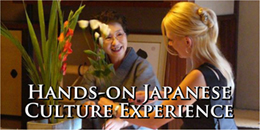
8 day trips from Kyoto for history, deer, street food and much more

Jan 26, 2024 • 9 min read
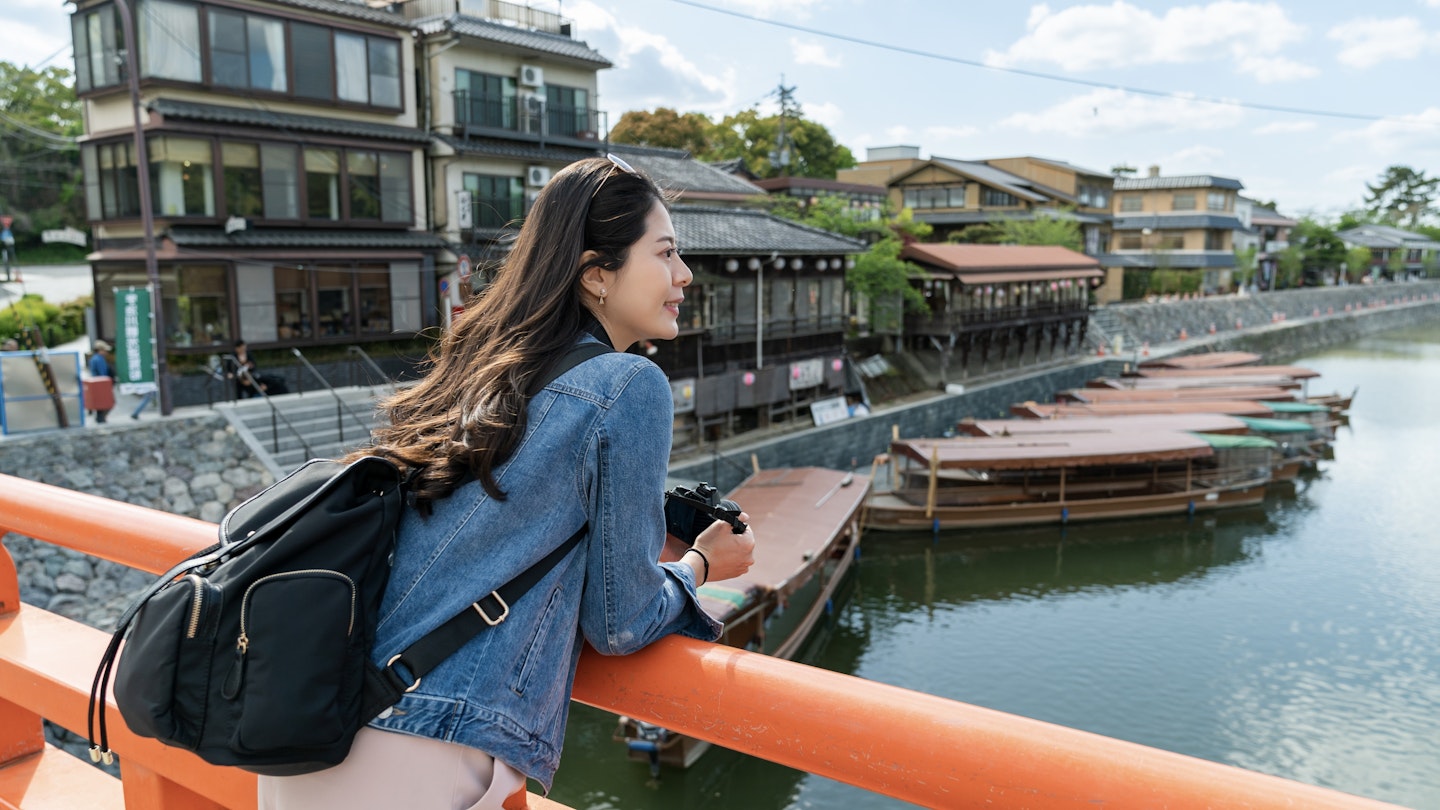
Within an hour or so from Kyoto, historic castles, beautiful canals, nature and much more awaits © PR Image Factory / Shutterstock
Kyoto offers a tantalizing glimpse of ancient Japan – which is why it's one of the most popular destinations in the country. Might we suggest escaping the temple crowds by exploring an alluring spot nearby?
Its position at the heart of the Kansai region makes Kyoto a handy base for hopping on a train to explore fairy-tale castles, go on tasting journeys in matcha towns and float along ancient canals.
Each of these itineraries is accessible by train in under two hours. As you plan, keep in mind that if you plan to make several trips within a five-day period, you should consider a Kansai WIDE Area Pass . (All routes are covered by this or a Japan Rail Pass , except in Hiroshima, as noted below.)
These are the most rewarding day trips from Kyoto.

1. Find your favorite matcha in Uji
Travel time: 20 minutes
Mmm…matcha. Green-tea-obsessed Uji lies just next door to Kyoto, yet draws far fewer crowds. Meander along its Omotesando laneway, dipping in and out of charming stores dedicated to selling locally sourced green tea. Pause in cafes to try matcha-flavored treats – ice cream or soba noodles (or both). As you hold up a skewer of dango to the light, you'll first see the scorch marks, then taste them as you chew through the rice-cake balls. The flavors dance between chargrilled, bitter tea and sweet rice.
At the laneway's end, the vermilion Byōdō-in seems to spread its wings and levitate above a green pond (a sight immortalized on the 10-yen coin). The temple's Phoenix Hall is an excellent example of architecture from the Heian Period; after taking in the ambiance, linger in the gardens and delightful tea salon for an hour. If you want more Heian history, explore the on-site Hoshokan Museum to ponder a temple bell and other Buddhist treasures.
Japanese literature enthusiasts should make a visit to the Tale of Genji Museum, dedicated to Murasaki Shikibu's famous 11th-century work (perhaps the world's first-ever novel). The exhibits provide insights into the portion of the narrative that unfolds in Uji.
Cross the Uji River to visit teahouses where artisans demonstrate how to brew the perfect green tea. In summer, finishing the half-day with a cruise in a wooden boat on the river is a pleasant finale indeed – cormorant-fishing demonstrations optional.
How to get to Uji from Kyoto: From Kyoto Station, take the JR Nara line to JR Uji Station.
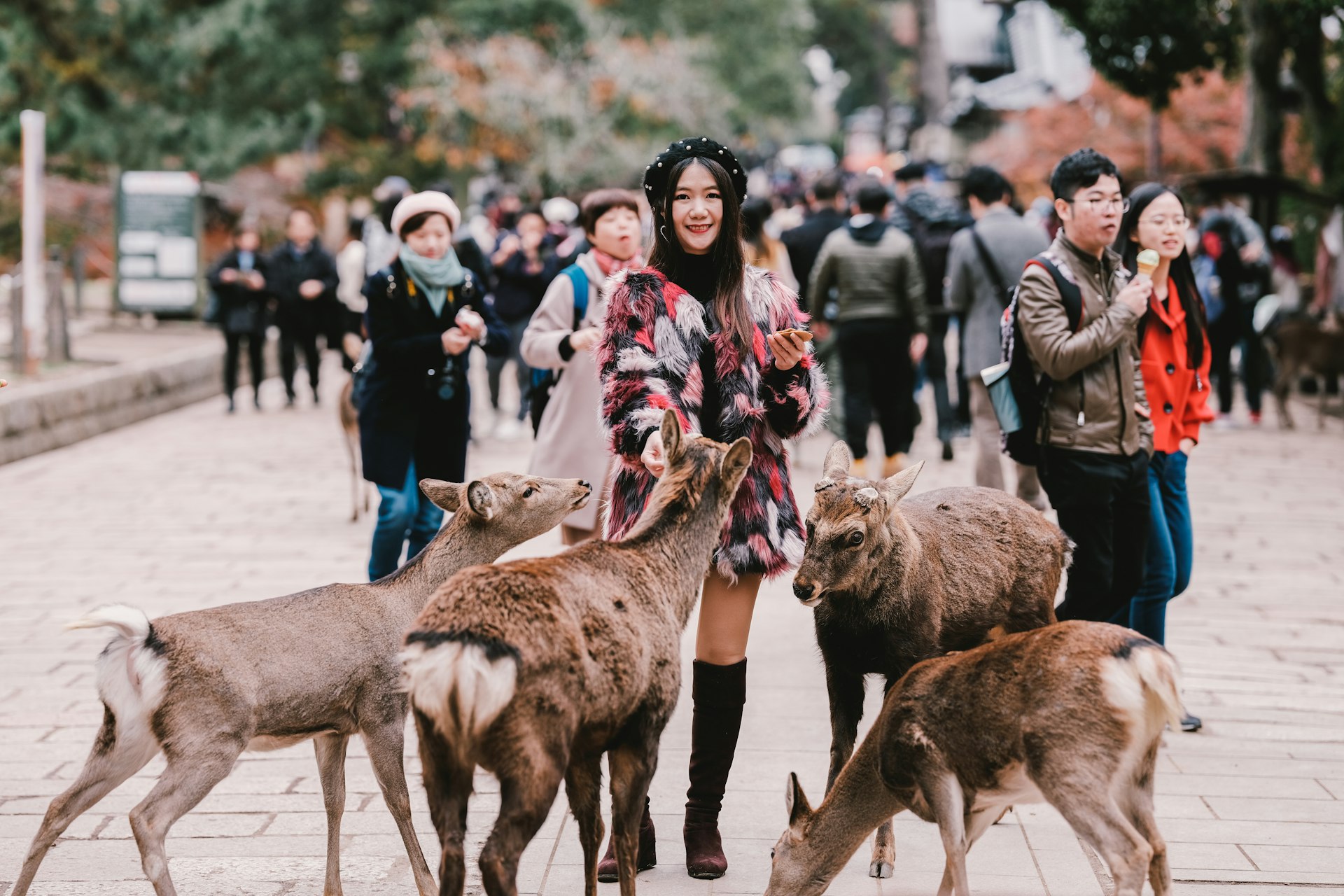
2. Encounter history – and deer – in Nara
Travel time: 1 hour
When you come eye to eye with the deer in Nara , you might decide for yourself if, as legend has it, they are divine messengers from the heavens. The 1000-plus placid deer that roam leafy Nara-kōen are an iconic symbol of Japan's first imperial capital. (Feel free to feed the free-roaming deer with crackers sold on-site.) You can take in plenty of Nara's history-rich sights while you're in the park, including the Great Buddha at Tōdai-ji , who is seated with an open hand as tall as a person. Early risers: if you get to Nara by 9am, it's worth observing morning prayers within the splendor of vermilion and cedar shrine pavilions at Kasuga Taisha .
How to get to Nara from Kyoto: From Kyoto Station, take a 55-minute Rapid train on the JR Nara line to Nara Station.
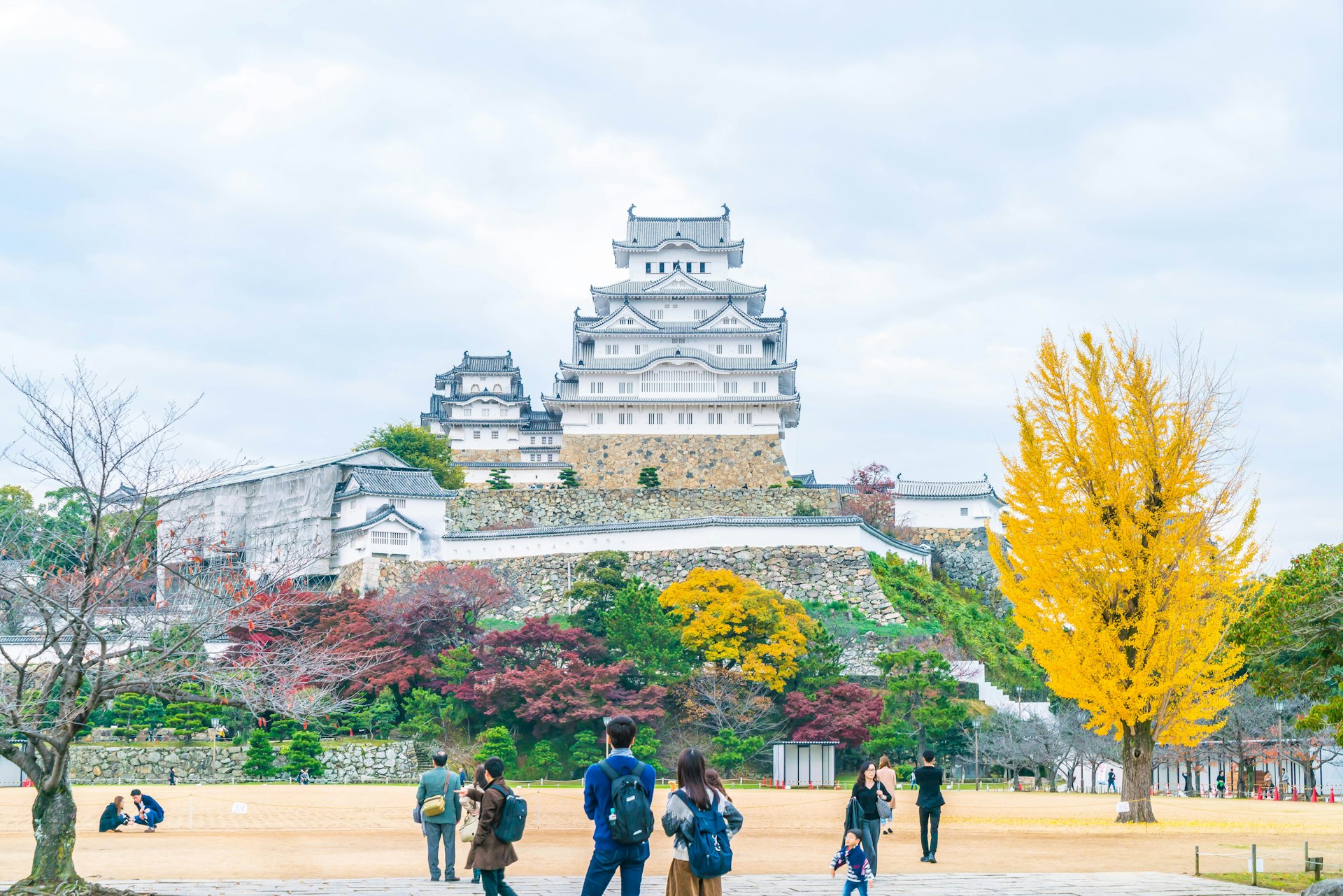
3. Climb Japan's best-preserved castle at Himeji-jō
Tilting your head skywards to be dazzled by the five splendid white stories of Himeji-jō is the stuff of Japanese fairy tales. In fact, the "White Heron" castle has been showcased in movies and TV series aplenty – which is no wonder, given how rare it is to find a truly intact (and not reconstructed) medieval castle in Japan.
Himeji-jō is a stunner, and it's worth visiting early to beat the crowds. Set aside an hour or two to climb to the top for great city views, then to take in the surrounding nine gardens within Kōko-en, designed in Edo Period style. A great time to visit is during cherry blossom season, when everything is framed in pink blooms and petals float atop the moats.
How to get to Himeji-jō from Kyoto: From Kyoto Station, take a JR Hikari train for 55 minutes to Himeji Station.
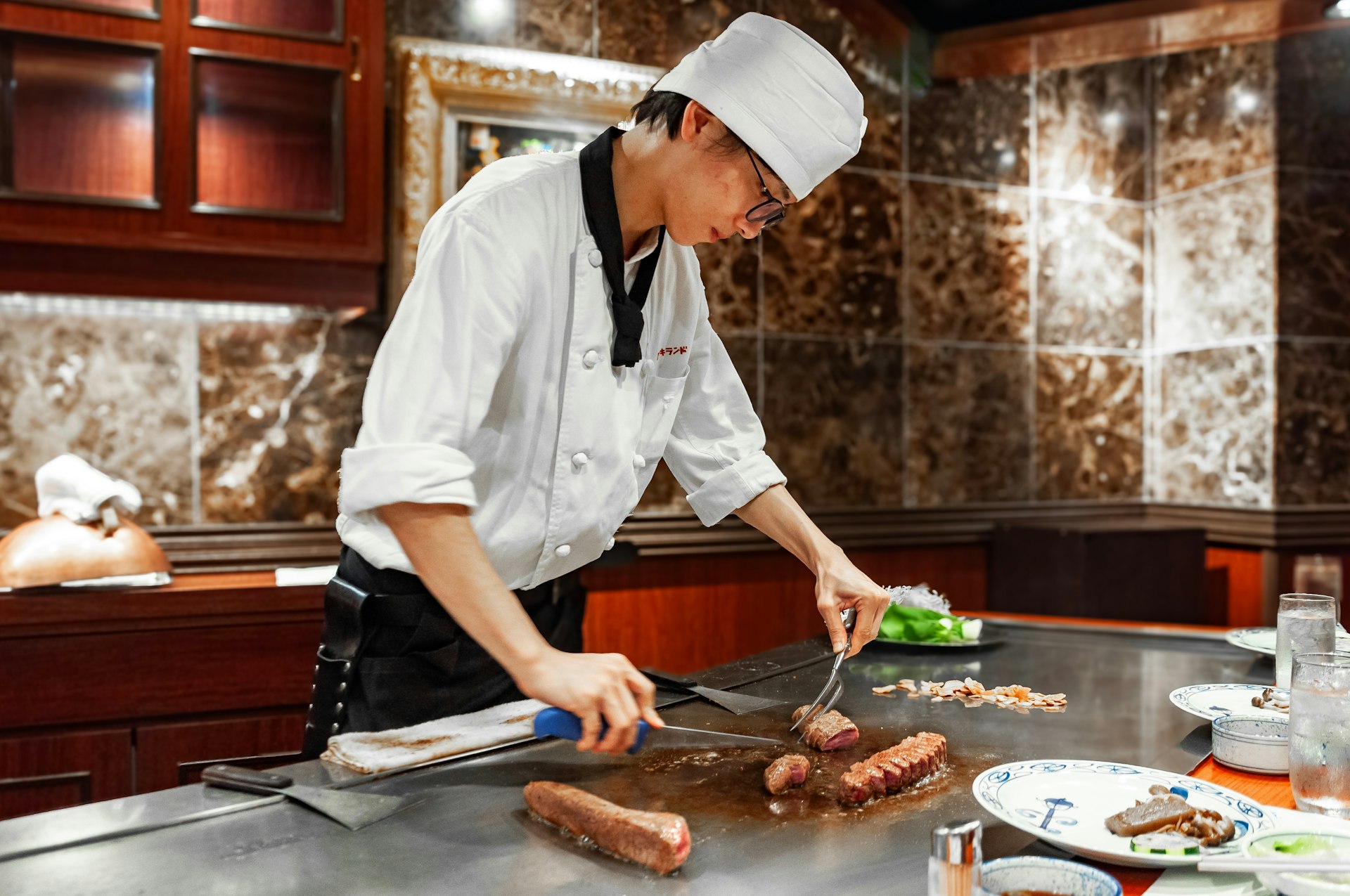
4. Eat real wagyū in Kōbe
Travel time: 2 hours
Kōbe is Japan's easy and breezy nature city, with countless things to do . Here, the mountains hug the seaport, with great views at every turn that make you stop and smile. Stop to dig into authentic wagyū (Japanese beef) – registered restaurants (identifiable by indoor plaque written in Japanese) are the most reliable. A superb place to start is with the good-value set beef menu at Tor Road Steak Aoyama – or by going all out with an exquisite teppanyaki experience (watching your chef work a hot plate) at Genkichi Kobe Beef . Head uphill from Sannomiya Station to a district of tree-lined streets with merchant houses, quaint cafes and unique shops.
Even with a population of 1.5 million, Kōbe offers easy access to nature. Mt Rokko, a popular hiking spot (accessible by cable car, too), towers over the city's narrow streets and features the landscaped Nunobiki Herb Gardens . Meanwhile, further up, Nunobiki Falls has been a muse for artists, poets and worshippers for centuries.
How to get to Kōbe from Kyoto: From Kyoto Station, take a JR Limited Express Super Hakuto train for 50 minutes to Sannomiya Station. There are two loop buses plying all the sights of the port and city.
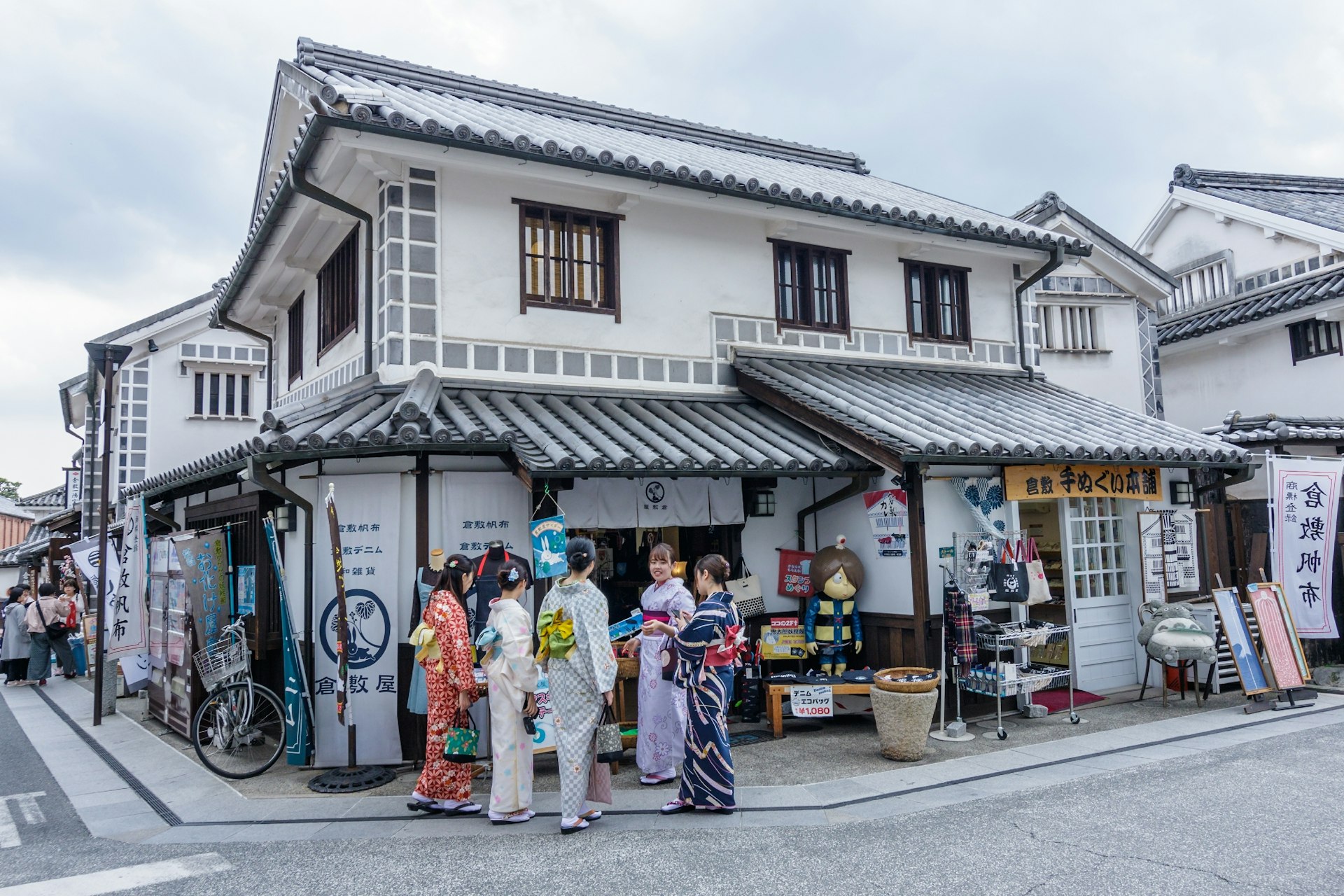
5. Daydream along the canals of Kurashiki
Willow trees dip into the canals, while handsome black-and-white Edo period (1603–1868) warehouses are tucked away off side lanes. A day trip to Kurashiki is like encountering an outdoor museum. Those buildings – many now converted into denim boutiques, cafes and art workshops – make up the atmospheric Bikan quarter.
Wander the laneways lined with old wooden houses and shops first before popping into the popular Ōhara Museum of Art , which displays works by Picasso, Cézanne and Matisse. Kids will love seeing the exhibits at the Japan Rural Toy Museum , or snacking on a denim-blue ice cream or burger in the Kojima district. (Kurashiki has been jeans-obsessed since its trading-hub days).
A traditional boat tour of Kurashiki Canal is a lovely way to pass the afternoon. On land, Ivy Square is a pretty courtyard that once housed textile factories but now often plays host to live entertainment.
How to get to Kurashiki from Kyoto: Ride the 90-minute Hikari bullet train to Okayama Station, then change to the 15-minute JR Sanyo line train to Kurashiki Station.
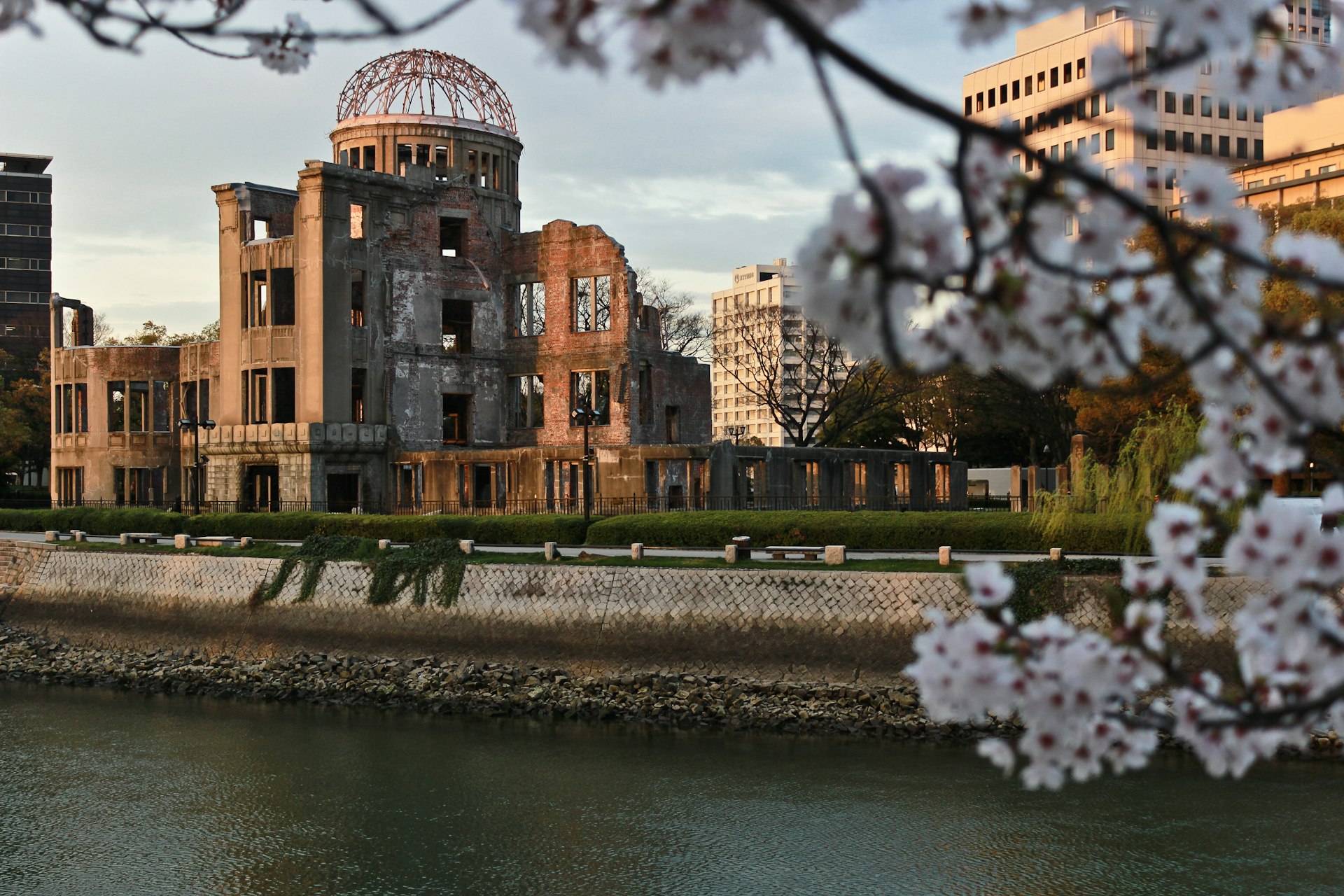
6. Reflect on peace in Hiroshima
Hiroshima may be synonymous with the devastating atomic bomb attack in 1945. But this leafy, laid-back city has much more to offer visitors these days than just its past. If you want to reflect on the preciousness of peace in the face of war, definitely start at the Peace Memorial Park , then take in the haunting Atomic Bomb Dome , one of very few buildings left standing near the epicenter, whose shell has been preserved as a memorial alongside the Hiroshima Peace Memorial Museum . Seeing the colorful garlands of origami paper cranes sent from schools across the world at the Children's Peace Monument is joyfully moving.
It's ambitious but possible to tackle Hiroshima as a day trip from Kyoto; we'd recommend lingering in the city and staying the night. That way, you can dig into a Hiroshima-style okonomiyaki (savory pancake), which adds a layer of yakisoba noodles for delicious heftiness. A fun way to taste it is by choosing one of the dozens of okonomiyaki restaurants at the multi-level Okonomimura food hall.
Another reason to stay into the late afternoon is the short trip over to the gorgeous island of Miyajima , home to Itsukushima-jinja , a bright red shrine rising out of the ocean – and one of Japan's most iconic views. From here, you can wander through streets lined with machiya (old wooden townhouses) and, if you have another spare hour, take a cable car up to the summit of Mt Misen for breathtaking views of the Seto Inland Sea.
How to get to Hiroshima from Kyoto: From Kyoto Station, take the Shinkansen Nozomi bullet train to Hiroshima (1 hour 40 minutes; this is not covered by JR Pass alone – an additional fee is required). Tourist loop buses and trams depart regularly from Hiroshima Station to the Peace Park. To reach the ferry port from Hiroshima Station, take the JR Sanyo line for 25 minutes to Miyajimaguchi Station.
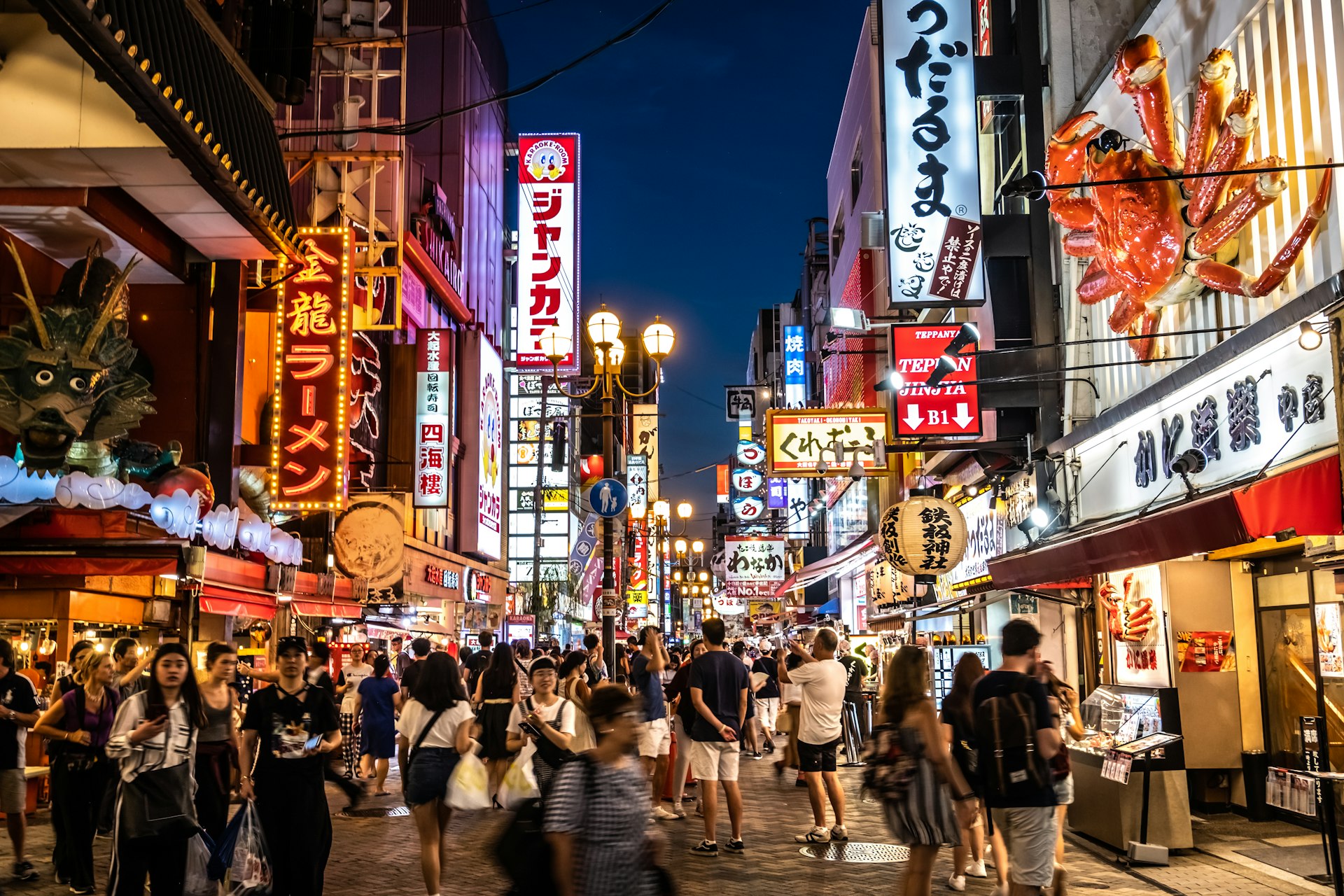
7. Taste the sizzle of street food in Osaka
Travel time: under 30 minutes
Osaka's street-food stalls are a festival of lanterns and delicious, sizzling smells, enjoyable day or night – easily done in a quick jaunt from Kyoto. Since the city is known as "Japan's kitchen," arrive hungry.
Its motto of kuidaore literally means "to eat oneself bankrupt." Which means you can expect to carve up okonomiyaki (savory pancakes) and devour takoyaki (fried octopus balls) along the canal in Dōtombori , peering up to see the iconic Running Man sign. Then try kushikatsu (crumbed meat and vegetables on sticks) near the Tsutenkaku Tower in the kitschy, retro neighborhood of Shin-Sekai .
As you wind through the alleyways of Ura-Namba to Torame Yokacho (Tiger Alley), you can try a range of favorite dishes under one roof. When full, walk off your excesses in the expansive grounds of Osaka Castle or browse boutique and vintage clothing shops in the hip neighborhoods of Amerika-Mura , Horie and Nakazakicho.
How to get to Osaka from Kyoto: From Kyoto Station, take a 28-minute JR Special Rapid train bound for Himeji to Osaka Station. Bullet trains also run between Kyoto and Shin-Osaka Station.
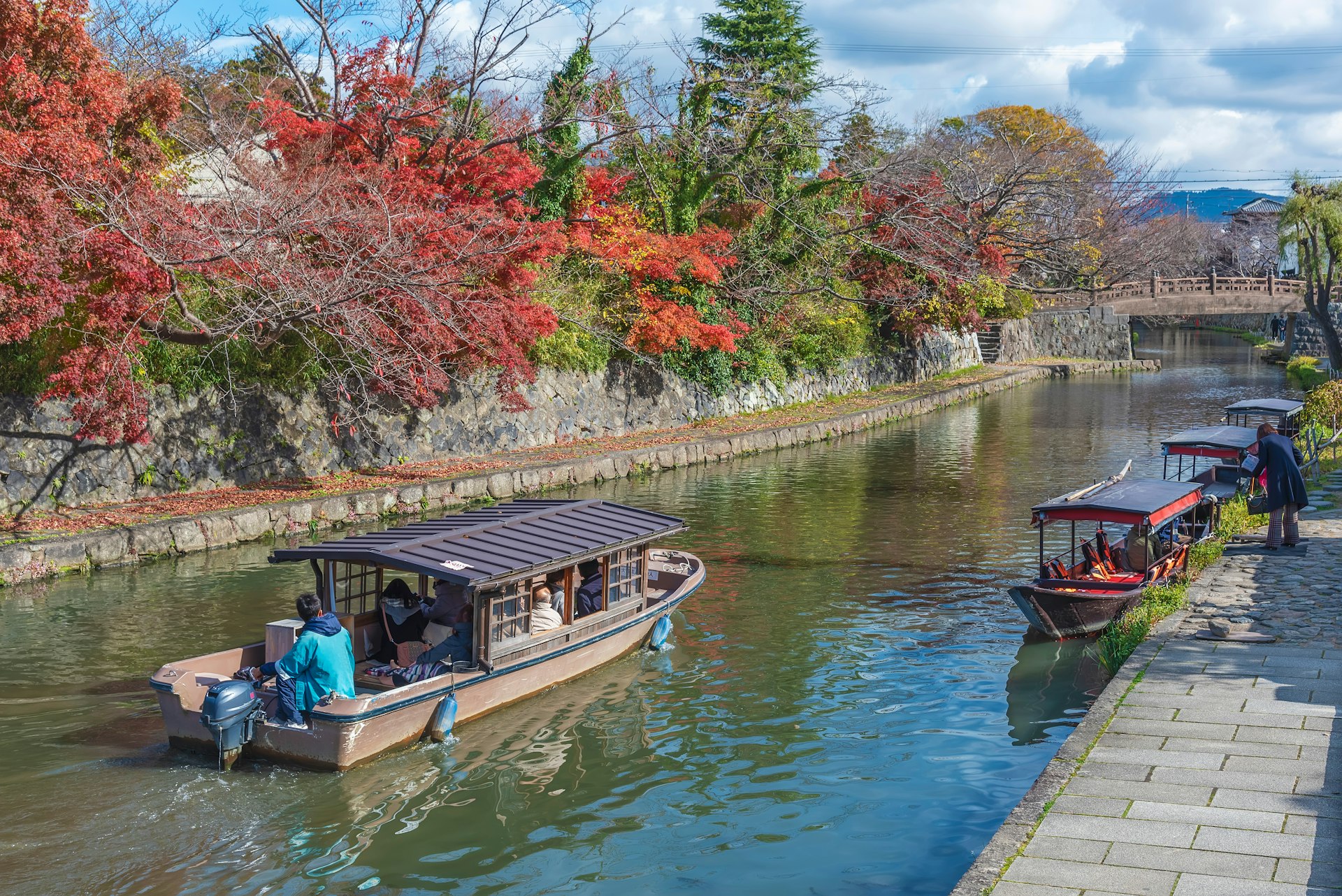
8. Cycle, swim, hike and ride canal boats around Lake Biwa
Travel time: 35 minutes
Japan's largest lake is rich with outdoor life. Along its shores, visitors find an almost overwhelming number of temples, castles, cities and activities spread hours apart. Start in the lake's most wonderfully preserved town, Ōmihachiman, far away from foreign crowds. From here, you can rent bicycles and follow the color-coded path markings for straightforward, self-guided cycling on a section around the lake. Or take it slow with a canal boat ride on the narrow waterways, gazing at the feudal-era merchant houses of Ōmihachiman, which once held goods brought across the Sea of Japan.
If you head up the Hachimanyama Ropeway, you'll be rewarded with great views across Lake Biwa, as well as short hiking trails. In summer, listen for the waves pattering the lake shore, inviting you for gentle beach swimming.
With more time, you can chase down the torii (gates) of Shirahige Shrine, which seem to float on the lake, or 17th-century Hikone-jō , shrouded in beautiful autumnal colors in mid- to late-November.
How to get to Lake Biwa from Kyoto: From Kyoto Station, take a Special Rapid train to Omi Hachiman Station.
This article was first published July 2019 and updated January 2024
Explore related stories
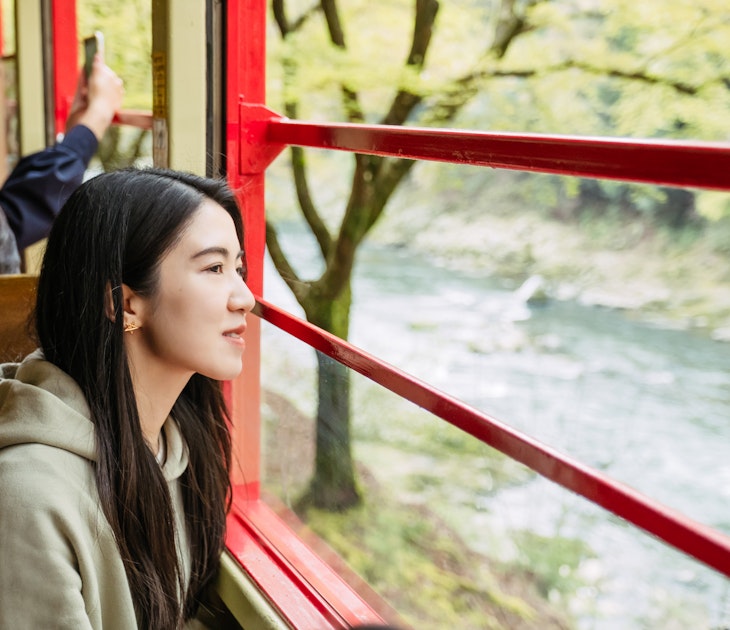
Destination Practicalities
Mar 25, 2024 • 9 min read
With its myriad islands, towering mountains and megacities, Japan can be a daunting destination to get around. We've got everything you need to know.

Dec 17, 2023 • 6 min read
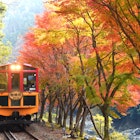
Mar 1, 2020 • 2 min read

Jan 31, 2020 • 7 min read

Nov 7, 2016 • 1 min read

Apr 14, 2024 • 6 min read

Mar 31, 2024 • 7 min read

Mar 28, 2024 • 7 min read

Mar 28, 2024 • 6 min read

Mar 28, 2024 • 11 min read
The Ultimate Kyoto Bucket List + Best Day Trips From Kyoto
Planning a trip to Kyoto and looking for the best things to do? We’ve got the ultimate Kyoto bucket list with the top Kyoto destinations and experiences as well as the best day trips from Kyoto .
The Ultimate Kyoto Bucket List

Kyoto sightseeing can be overwhelming, especially if you’ve never been. The is first and foremost because Kyoto is much larger than its reputation would lead you to believe—almost 1.5 million people call Kyoto home, and only a small minority of them live in the city’s ancient wards.
Another part of this, of course, is because there are just so many things to do in Kyoto —and outside the city as well. Here’s a simple breakdown of Kyoto’s top attractions, which will help you quickly and easily plan your next trip to Japan’s ancient capital.
Top Kyoto Destinations and Experiences
Explore the temples of higashiyama.

Stay in a Traditional Ryokan Guest House

The best place to stay in Kyoto is a somewhat subjective matter, but my M.O. is always simple and authentic, as opposed to elaborate and extravagant. Some of my favorite Kyoto ryokan include Ryokan Uemura , which is located in the heart of Higashiyama and has been in the same family for six generations, and Ryokan Kyoraku , which is a short walk from Kyoto Station .
Get Lost in Lush Arashiyama

Enjoy Cherry Blossoms or Autumn Colors

The bad news? Whether you seek out Kyoto cherry blossoms or its autumn leaves, you’ll be one of millions of tourists. The good news? The beauty of these seasonal spectacles outweighs the stress of these crowds. TIP: Wake up early (around 5 or 6 if you can) to see famous hanami and koyo spots like the Philosopher’s Path and Maruyama Park without throngs of tourists.

Find a Geisha in Gion

Best Day Trips From Kyoto
Be a deer in nara.

Marvel at the Castles of Lake Biwa

Another one of my favorite day trips from Kyoto will take you northeastward to Lake Biwa , one of Japan’s largest freshwater lakes. On the eastern shore of this lake, you’ll find Nagahama and Hikone Castles , which are two stunning examples of Japanese feudal architecture. Both originally date back to the 17th century, though only Hikone’s castle retains its original keep.
Eat Your Way Through Osaka

Sip Matcha in Uji

Headed to Nara and wanted to stop somewhere else on the way back? Disembark the train in Uji , a city that’s famous for two main reasons. First, its outskirts are where some of Japan’s most famous matcha green tea is grown. Secondly, the city center is home to stunning ancient structures, including 10th-century Byodo-in temple and a 13-tiered stone pagoda.
Touch-and-Go in Hiroshima

Many travelers want to take a Hiroshima day trip from Kyoto, since the cities are just a couple hours apart via Shinkansen bullet train. This isn’t optimal (I recommend spending at least one night in Hiroshima) but it is possible. TIP: Leave for Hiroshima first thing—and plan to come back after nightfall—so you can watch sunset behind Itsukushima Shrine , the floating torii gate on Miyajima island.

How Many Days Should You Spend in Kyoto?
The question of how many days in Kyoto you should spend is at once simple and complicated. The simple answer is that you should spend as many days in Kyoto as you can. The complicated answer? Days can quickly turn into weeks and even months, if you don’t have somewhere else to be (and you don’t run out of money, which is always a danger in Japan!)
Assuming you spend around 2-3 weeks in Japan, I’d recommend a Kyoto itinerary of about 3-5 days in length, which assumes you’ll spend 3-5 days elsewhere in the Kansai region, which also includes Osaka and Kobe. If you stick to the shorter end, your trip will necessarily take place primarily within Kyoto’s city limits; the longer you stay, the more day trips you can take.
The Bottom Line
No matter your appetite for Kyoto sightseeing or how long you plan to spend in the city, exploring Japan’s ancient capital doesn’t have to be stressful or complicated. If you break down attractions inside (and outside!) the city and make yourself a plan, it can actually be very simple. Moreover, your first trip to Kyoto is very rarely your last, so if you miss something this time, you can just see it when you come back!

Robert Schrader has traveled much of the world, but still considers Kyoto to be its most beautiful city, especially during cherry blossom season. He created Japan Starts Here as a source of information—and inspiration—for travelers to his favorite country. Follow Japan Starts Here on Facebook , Twitter or Instagram to keep up.
Related Posts

savvyglobetrotter
Japan in general is my dream destination! I’d love to visit, hopefully next year and make it to Kyoto. Nara looks so pretty, as does the cherry blossoms there too!
I absolutely loved Aarashiyama Bamboo Grove when I went, though it was extremely crowded and the Ginkaku-ji temple was amazing too. The day trips to Nara and Osaka are absolutely recommended even by me, I did them too while I was in Kyoto and they were amazing cities. Also, Hiroshima was pretty cool, I spent a couple of days there rather than doing just a day trip.
Leave a Reply Cancel reply
Your email address will not be published. Required fields are marked *

Currently you have JavaScript disabled. In order to post comments, please make sure JavaScript and Cookies are enabled, and reload the page. Click here for instructions on how to enable JavaScript in your browser.
This site uses Akismet to reduce spam. Learn how your comment data is processed .
Inside Kyoto
A Kyoto Travel Guide
Kyoto Day Trips
Visiting Kyoto but want a trip outside the city? Here is our list of the best towns, temples, hikes, and other attractions that can be visited in a day.

The List: Day Trips From Kyoto
Seven days in Kyoto gives plenty of time to fit in at least one day trip outside the city centre. This is our list of the best places within reasonable distance to make a day of it. See our Kyoto Itineraries for more suggestions on how to make the most of your time. We’ve also listed temples and shrines which require a half or full day to visit, and then finish off with some spectacular day hikes, as well as some shorter and longer alternatives. Click through for full details on what to expect.

Kyoto Day Trip Destinations
About 15 kms southwest of Kyoto, and easily accessed by both the Keihan Line and the JR Line, Uji is famous for the lovely Byodo-in Temple (the temple on the back of the Y10 coin). It’s also famous as a tea growing area.

A Day Trip To Ohara
Ohara is an ancient farming village north of Kyoto, famous for its rural beauty and the historical and spiritual significance of its many temples. Michael Lambe takes us on a comprehensive tour of this area’s key sites.

Himeji Day Trip Itinerary
If you’re a fan of Japanese castles, you must visit Himeji, which is only 45 minutes from Kyoto Station by bullet train. Make the most of your time with our Himeji Day Trip Itinerary.

Nara Travel Guide
Nara is a spectacularly picturesque city which is second only to Kyoto for the richness and beauty of its temples, shrines and gardens. It’s possible to visit Nara as a daytrip from Kyoto and Osaka, but its gorgeous districts and parks are certainly worth a few days of your time.

Kurama And Kibune
Kurama and Kibune are a pair of tranquil rural villages and easy and scenic 30-minute train north of Kyoto on Eizan Line. They form the best half-day trip out of Kyoto.

The Kitayama Area: Bujo-ji, Miyama, Kayabuki-no-Sato
If you want to experience traditional rural Japan and you’re willing to drive a rental car, the Kitayama Mountains north of Kyoto make the perfect day trip.

Hiroshima And Miyajima Travel Guide
Less than two hours by bullet train from Kyoto, Hiroshima is the most interesting city in Western Japan. And nearby Miyajima Island is a natural and spiritual sanctuary.

Kyoto Temples and Shrines Outside The City
Kurama-dera mountain temple.
Kurama-dera Mountain Temple is easily the best day- or half-day trip out of Kyoto. High on the shoulder of Mt. Kurama, you can feel the power of nature up here.

Sanzen-in Temple
Sanzen-in Temple, located in the village of Ohara (see earlier entry), is one of the most beautiful temples in the mountains outside the city.

Byodo-in Temple
A superb Hiean-era temple in the southeast suburb of Uji, Byodo-in a brilliant place to visit for those who want to step off the beaten track.

Kamigamo-jinja (Kamowakeikazuchi-jinja) Shrine
One of Kyoto’s least visited but most historically important shrines, Kamigamo-jinja Shrine is a great place to catch your thoughts up north.

Kyoto Day Hikes
Kurama to kibune hike.
The easy hike from Kurama to Kibune, in the hills north of Kyoto, is our favorite half-day trip out of Kyoto City. It’s the perfect combination of nature and culture.

Fushimi-Inari Hike
The hike to the summit of 233m Mt. Inari-san and the pilgrimage circle around the shrines near the top is one of the most interesting short walks around Kyoto. It’s also the best way to see all of Fushima-Inari Taisha Shrine.

Walking the Nakasendo from Kyoto Guide and Map
Walking the Nakasendo, an old mountain route between Kyoto and Tokyo, is a great way to sample Japan’s rural scenery. You can walk the most popular section, Magome to Tsumago, as a daytrip from Kyoto.

Takao to Hozukyo Hike via Kiyotaki and Kuya-no-taki Waterfall
The hike from the hamlet of Takao down through the mountains west of Kyoto to the train station at Hozukyo is one of the best day hikes near Kyoto. It includes two superb temples, a crystal-clear river and a magical waterfall.

Shorter Kyoto Hikes
Mt daimonji-yama hike from ginkaku-ji temple.
The one-hour roundtrip hike from Ginkaku-ji Temple up to the viewpoint on Mt. Daimonji-yama is the best short hike in Kyoto. The view of the city from here is incredible! Found out everything you need to do this hike.

Shogunzuka and Seiryuden Hike From Chion-in Temple
One of the best short hikes in Kyoto is the easy 2-hour hike from Chion-in Temple in Southern Higashiyama up to the Shogunzuka viewpoint. It provides some incredible views over Kyoto. Here is everything you need to do this hike.

Overnight Kyoto Trips
While not really daytrip distance from the city, these two areas are well worth an overnight trip from Kyoto.
The Kumano Kodo Walking Trail: A Guide with Maps
The Kumano Kodo is an ancient pilgrimage trail in the mountains of Wakayama (south of Kyoto) where you can walk with a light pack from guesthouse to guesthouse for a few days. It’s a brilliant way to experience Japan’s rural side and ancient religious traditions.

Exploring the Tango-hanto Peninsula
The Tango-hanto Peninsula, about two hours north of Kyoto City, is a beautiful unspoiled destination with onsen (hot springs), beaches and stunning coastal scenery. It’s the perfect place to enjoy rural Japan without the crowds. Here is our full Tango guide and map.

Kyoto Hiking Guides
Best kyoto hikes.
Surrounded by mountains on three sides, Kyoto has some brilliant hiking. There are good hikes right in the city and others just a short train or bus trip away. Here are my five favorite hikes in and near Kyoto.

Kyoto Hiking Itineraries
Kyoto is surrounded by mountains on three sides and these mountains are latticed with hiking trails. Here, we introduce the five best hikes in or near Kyoto.

Hiking in Japan – A Full Guide
Japan is a fantastic hiking destination, with great mountains, well-maintained trails and an extensive mountain hut network. You can do everything from easy day hikes to multi-day treks.

Kyoto Vacation Checklist
- For all the essentials in a brief overview, see my First Time In Kyoto guide
- Check Kyoto accommodation availability on Booking.com and Agoda.com - often you can book with no upfront payment and free cancellation
- You can buy shinkansen (bullet train) tickets online from Klook - popular routes include Tokyo to Kyoto , Kyoto to Osaka and Kyoto to Tokyo
- Need tips on where to stay? See my one page guide Where To Stay In Kyoto
- See my comprehensive Packing List For Japan
- Buy a data-only SIM card online for collection when you arrive at Kansai International Airport (for Osaka and Kyoto) or Tokyo's Narita Airport . Or rent an unlimited data pocket wifi router
- Compare Japan flight prices and timings to find the best deals
- If you're making frequent train journeys during your visit, you might save money with Japan Rail Pass – see if it's worth it for you
- A prepaid Welcome Suica card makes travelling around Kyoto easy – here's how
- World Nomads offers simple and flexible travel insurance. Buy at home or while traveling and claim online from anywhere in the world
Kyoto District Map

- Central Kyoto
- Northwest Kyoto
- Northern Higashiyama
- Southern Higashiyama
- Downtown Kyoto
- Kyoto Station Area
- South East Kyoto
Disclosure: InsideKyoto.com is a participant in the Amazon Services LLC Associates Program, an affiliate advertising program designed to provide a means for sites to earn advertising fees by advertising and linking to amazon.com and amazon.co.uk. World Nomads provides travel insurance for travellers in over 100 countries. As an affiliate, we receive a fee when you get a quote from World Nomads using this link. We do not represent World Nomads. This is information only and not a recommendation to buy travel insurance.
- Tours & Experiences
- Tailor-made Trips
- Bahasa Indonesia
We are happy to see you again!
Continue with
Or use email.
No Account? Create one
Create account
Already have an account? Sign in
Quickly Sign up with
I agree to Japan Travel's Terms of Service and Privacy Policy . Terms of--> and acknowledge that Japan Travel's Privacy--> applies to me.-->
Email reset password link
Please check your inbox and click the link we will send to you.

Events in Kyoto

Miyako Odori 2024
The Miyako Odori performance in Minamiza theatre in Kyoto hass a long history and involves the best geiko and maiko of Kyoto. The..

Yabusame Shinji 2024
Every year in early May. witness the Yabusame Shinji at Shimogamo shrine, where Japanese mounted archers fire arrows at enemy targets...
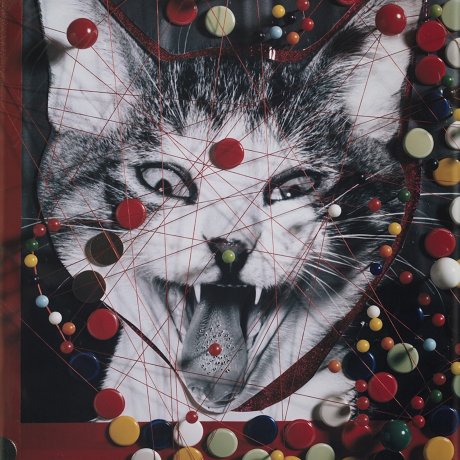
KYOTOGRAPHIE International Photography Festival 2024
The KYOTOGRAPHIE International Photography Festival is an annual event held in Kyoto over four weeks. The theme for 2018 is "Up",..
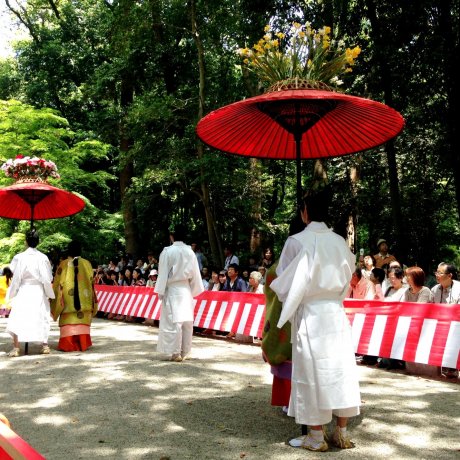
Aoi Matsuri Festival 2024
The Aoi Matsuri is one of the oldest and most celebrated festivals in Japan. So much so, the word “Matsuri” originally referre..

The Star Festival 2024
The Star Festival has been running since 2012, and takes place at Stihl no Mori in Kyoto. The two-day event allows visitors to camp..
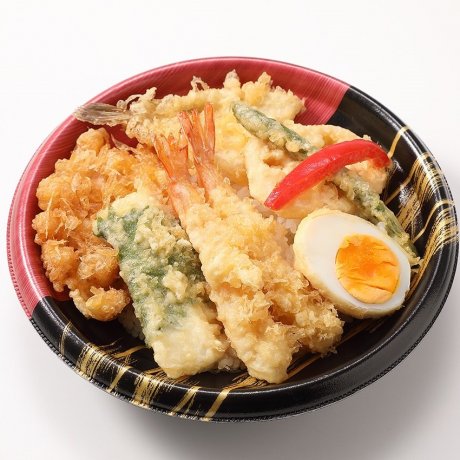
Donburi Grand Prix 2024
Now in its 16th year, the Donburi Grand Prix will offer up a variety rice bowls piled high with toppings for visitors to choose..
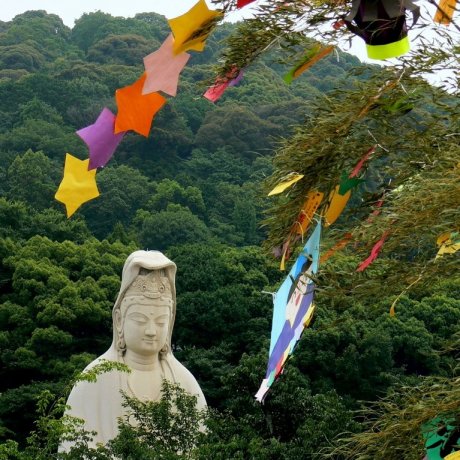
Tanabata and Light-up at Kodai-ji 2024
Colorful display of decorated bamboo branches in the carpark of Kodai-ji in Kyoto to celebrate the festival of Tanabata. The handmade..
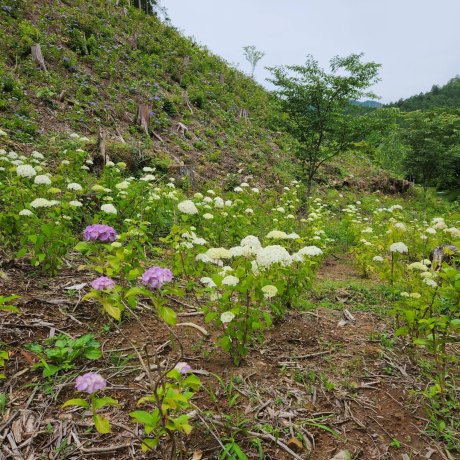
Kahoen Hydrangea Festival 2024
During peak hydrangea season, Kyoto's Kahoen garden is set to be filled with around 10,000 hydrangea bushes in bloom.
Event Calendar
Top 10 events in japan.
- Recommended

Kanamara Penis Festival

Miyako Odori

NAKED Sakura Festival

Total Solar Eclipse in Japan

Sakura Tulip Festa in Chiba

Nabana no Sato Illumination

Sanja Matsuri

Tokyo Auto Salon

Gion Matsuri

Tokyo Sakura Garden Spring Festival

The Wiener Sängerknaben Japan Tour

March Grand Sumo Tournament (Osaka)

September Grand Sumo Tournament (Tokyo)

Acao Rose Festa

American Road Trip Buffet

Shibuya Butter Festival

British Hills Market

Odaiba Shaved Ice Festival

Yokohama Flower & Garden Festival

Motor Fan Festa
Let us know how we can help.
Asia , City Guides , Japan · November 10, 2019
14 of the Most Stunning Day Trips From Kyoto
Kyoto is a vibrant city and one of the most popular destinations in Japan. With stunning temples, beautiful gardens, lively markets, and hidden alleys where you might see geishas, Kyoto has a lot to offer! While there are many exciting things to do in Kyoto , there are also many beautiful places on the city’s outskirts worth visiting. To help you find the best of them, here’s our curated list of the best day trips from Kyoto !
Ready to find the perfect side trip to add to your Kyoto bucket list? Grab a matcha latte, and let’s go!

Disclaimer: This post probably contains affiliate links. When you make a purchase through one of these links, I might receive a tiny commission at no extra cost to you. As an Amazon Associate I earn from qualifying purchases.
Table of Contents
Kyoto Essentials
Before you jet off on your Kyoto trip, make sure to read these Japan budget tips to help you travel Japan with ease. It’s also essential to have a few basics already in place. Here are a few things I highly recommend you consider for a stress-free trip:
- Search for the best hotel prices in Kyoto . Although Gion is one of the best areas to stay in Kyoto, you might want to consider basing yourself near the Kyoto Station. This will allow you to easily travel further afield. However, if you need more options, this guide on the best neighborhoods to stay in Kyoto should come in handy.
- Grab an e-SIM for Japan , so that you can access transport schedules, maps and more on the go.
- Book your discounted JR West Kansai Area Pass to access multiple train lines and access most of the day trips from Kyoto on this list. If public transport isn’t for you, another option is to hire a private charter .
- Order an ICOCA card to pick up at the airport. The ICOCA card is similar to other top-up cards you can find in Asia, like the Easy card in Taiwan or the Octopus card in Hong Kong . Not only can you use it for tap-and-go on public transport, but you can also buy items at convenience stores.
- If you’re into the ‘gram, rent a kimono and capture some fun photos while experiencing authentic Japanese culture.
- Grab this Lonely Planet for more tips on traveling in Kyoto. It’s packed with handy tips, places to visit, and great insights into the city’s history and culture.
- While Japan is a safe country to visit, you never know what can happen on a trip. If you need travel insurance, I highly recommend SafetyWing .
Top 14 Day Trips From Kyoto not to Miss

If you are wondering what the best day trips from Kyoto are, you’re going to be spoiled for choice after getting through this guide. This curated list sets out 14 of the most stunning day trips from Kyoto – as recommended by world travelers.
This guide includes all the must-see spots near Kyoto and is jam-packed with useful tips to help you plan a smooth trip. You can also access all the places mentioned in this Kyoto day trip guide by train or bus. However, if you’re not comfortable exploring these areas on your own or prefer to join a group, I’ve also included some fantastic tours. These tours will help you make the most of your visit without the stress of planning everything independently.
Day Trips within 1.5 hours from Kyoto

Arashiyama is synonymous with one of the most iconic towns in all of Japan. Home to the mesmerizing Bamboo Forest and ancient temples, it’s not hard to see why Arashiyama is one of the country’s top Natural Heritage Sites.
Start your day by taking a relaxing stroll across the 155m long Togetsukyo Bridge . The bridge was built during the Heian Period and offers an excellent vantage point over the river with mountains as a backdrop.
Then head over to the Hozugawa River. For a unique experience, enjoy a romantic river ride or rent a canoe to admire the scenic landscape. There’s also a beautiful trail following along the promenade over the mountain to the heart of the village.
From here, have a walkabout in town, grab some food and then head to the Bamboo Grove. Here you will walk through towering bamboo forests offering countless excellent photo opportunities. Be sure to also stop by centuries-old, Tenryuji. The temple is a UNESCO World Heritage Site, and one of Kyoto’s top 5 Zen temples.
Arashiyama is an excellent day trip from Kyoto and one that should be high on your side trips list. If you already have a JR Pass take the JR Sagano/ San-in Line to Saga-Arashiyama Station. The ride takes less than an hour. Alternatively, access Arashiyama by bus from Kyoto Station. The journey is slightly longer, but the scenery along the way makes up for it!
Suggested Tours
- Arashiyama Bamboo Forest Half Day Tour
- Kyoto Sagano Romantic Train Ride including Arashiyama, Kiyomizudera & Fushimi Inari-taisha Day Tour
Himeji Castle

Recommended by Jodie from Alajode.
Himeji Castle makes for a magical day out, and can easily be visited on a day trip from Kyoto. Traveling to Himeji station from Kyoto only takes around 45-55 (depending on which train you catch), thanks to the direct line that runs between them. To get there, take the JR Tokaido or Sanyo line. If you’ve already bought a JR Pass for your trip to Japan , the high-speed Shinkansen won’t cost you anything.
Himeji Castle is a towering white castle that you won’t be able to miss. One of only 12 castles of its kind to have survived, this medieval white castle looks like it’s straight out of a fairytale. You can climb up to the top floor of the castle and enjoy some magnificent views of the surrounding area. You may have to wait in line for a while, and you’ll need to be fit enough to climb the many stairs, but it’s well worth doing!
Whether you climb up or not, make sure you schedule in some time to enjoy the surrounding park as well. Himeji Castle is encircled by a moat, on which you can take a short boat ride – or simply admire the beautiful scenery from the sidelines.
- Himeji Castle, Arima Onsen & Mt. Rokko Day Tour

Recommended by Alexander, from Gourmand Trotter
Kobe is an easy day trip to make from Kyoto that takes about 1 hour and 30 minutes on the train. Kobe is a famous harbor city in Japan, and it’s also a popular destination for tourists wanting to try the famous Kobe Beef.
There are plenty of restaurants serving Kobe Beef, but be sure to choose a reputable restaurant, so you don’t end up paying a premium price for regular wagyu beef. Kobe Beef Steak Restaurant Royal Mouriya is a great place, although somewhat expensive.
Kobe is also very famous for its sake, and visiting a sake brewery is one of the best things to do in Kobe. If you want to visit an old wooden shrine, you shouldn’t miss the Ikuta shrine, which was built in 201 AD.
The most famous district in the city is Harborland, and here you’ll find plenty of attractions and entertainment along the waterfront. It’s a fun area to explore, especially if you’re traveling here as a family.
To get here, take the Tokaido-Sanyo Line, which is a direct train from Kyoto.
- Kobe Food Tour
- Kobe City Kickstarter Tour
- Kobe Highlights Day Tour with Sake Tasting

Recommended by Lena from Nagoya Foodie.
Nagoya is Japan’s 4th largest city by population with many exciting sights. But unfortunately, it is often overlooked by travelers.
In Nagoya, you can visit one of the most fantastic castle reconstructions. The Hommaru Palace is entirely made from wood and is decorated with golden wall paintings. Other highlights of Nagoya include the Toyota Museum, where you can learn about Japan’s largest car manufacturer.
Don’t miss the Osu shopping street, a roofed-over network of shopping streets with shops selling everything from second-hand items to high-end electronics. Even if you just come here to window shop, the atmosphere is fantastic.
There are many more activities in Nagoya that you shouldn’t miss out on. While the fantastic sights are definitely worth a visit, it’s the local food that truly sets Nagoya apart and makes it a great day trip destination from Kyoto. The local cuisine, Nagoya Meshi, is unique to the region and definitely worth a try. Some of the must-try dishes include Miso Katsu, which is deep-fried pork cutlets in Miso sauce, and Hitsumabushi, which is grilled freshwater eel.
Nagoya is only about 130 kilometers from Kyoto, and it can be easily reached by bullet train in 35 minutes. However, options like local trains and buses are also available. While these options are much cheaper, they take over 2 hours one way, which won’t leave too much time for sightseeing.
- Nagoya: Hida Takayama & World Heritage Shirakawa-go Day Tour
- Nagoya Eat Like a Local Tour
Save these popular side trips from Kyoto to read later.

One of the best day trips from Kyoto is undoubtedly Nara. This quintessential town is a beautiful mix of age-old temples, unique traditions, and sublime gardens. The best part about taking a Nara day trip from Kyoto , however, is a chance to meet the cheeky free-roaming deer.
Start your Nara day trip by heading to the Nara Deer Park, where you can enjoy a gentle stroll among the beautiful gardens and snap some pictures of the semi-tame deer. Many vendors sell ‘deer cookies,’ but take note that the deer are quite cheeky. Then make your way to the most iconic temple in town, Todai-Ji. Here you can witness the second largest Buddha statue in Japan, Daibutsu, towering 15-m high. The temple is also a UNESCO World Heritage Site, and the main hall houses many interesting relics and artifacts worthy of your time.
A short stroll away, head over to Kasuga-Taisha — a beautiful Shinto Shrine dating back to 768 AD. Along the way, you’ll see towering dense forests, secret paths lined with more than 3000 stone lanterns, and of course, more deer. Before making your way back to the train station, drop by Kofuku-ji Temple. The temple is home to a five-story pagoda, a museum, and a beautiful hall showcasing some prized artifacts.
If you already have a JR Pass, do take the JR West line to Nara. Trains run every 30 minutes, and the journey only about 45 minutes. Alternatively, take the Kintetsu train, which is slightly cheaper and faster but only runs on the hour.
- Kyoto and Nara Day Tour from Kyoto/Osaka
- Nara Half-Day UNESCO Walking Tour
- Kyoto and Nara Private Car Charter
Visiting Japan in autumn? Read my detailed Japan autumn guide which covers everything you need to plan the perfect trip to Japan during fall.

Recommended Nicole from Nicole LaBarge Travel Blog.
Osaka is an ideal day trip from Kyoto. The city is only 15 minutes by train from Kyoto, and there is so much to do there!
When visiting Japan , the main cities to visit are Tokyo, Osaka, and Kyoto. Osaka is the third-largest city in Japan, and you will find everything here from culture to history to great food.
You can start your day at the Osaka Aquarium. There is a reason why the aquarium is on every list of things to do in Osaka. There are over 30,000 animals in this aquarium, and you could spend a whole day here exploring.
Next, head to Osaka Castle, a famous landmark in Japan , built in the 1500s. You can explore the castle, but more importantly, you can explore the grounds and gardens surrounding the castle. You could easily spend half a day here.
And last you must try some of the foods that are famous in Osaka such as Okonomiyaki. It is a Japanese pancake similar to pizza. Or you can have a bowl of ramen.
If you’re wondering how much time to spend in Osaka, t his guide on how many days to spend in Osaka will come in handy.
- One-Day Osaka Walking Tour
- Osaka Castle, Kuromon Market, Dotonbori, and Museum of Housing and Living Day Tour
- Osaka and Surrounding Areas Private Car Charter

Recommended by Mayi from Secret Moona.
We hear very little of the city of Uji, even though it is located only minutes from Kyoto. Overlooked by tourists and yet famous throughout Japan for its powdered green tea (matcha), Uji is a city to discover. The little town is one of those Japanese cities with an undescribed charm. The smell of tea tickles your senses as soon as you arrive at the central station and follows you throughout your visit.
If you are looking for a great day trip from Kyoto, Uji is a city made for you! It is a quiet and beautiful destination where you can enjoy temple visits, taste amazing matcha flavored food like ice cream or soba, appreciate sunset viewing, and cormorant fishing on the river.
Start your day by a visit to Byodo-in Temple, a beautiful temple with a garden and pond. Afterward, take a stroll in the main shopping street and taste some of the street food on offer like mochi and takoyaki. If you rather sit down, head over to Aiso for a yummy tempura meal set with soba noodles. After the delicious lunch, cross the Kisen-Bashi Bridge to To-no-Shima Island and take a stroll along the Uji river banks. Finish the day by visiting Ujigami Shrine, the oldest standing shrine in Japan before heading to the train station.
- Matcha Green Tea Tour in Uji
- Nara & Uji Day Trip including Matcha Experience and Hot Springs

Recommended by Kavita from Kavey Eats, Pete Drinks.
If you are interested in Japanese whiskey, Suntory’s Yamazaki Distillery is an easy day trip from Kyoto, located just a short train ride away.
The Distillery offers a tour and tasting (you need to book your place in advance) that takes visitors around the distillery, from mash room to still house to warehouse. The guide speaks in Japanese, but English-language audio guides are available, and the guides will help you play the relevant explanations for each part of the tour.
The tour ends in a vast tasting hall where visitors are treated to a dram. Be warned that these are usually served with soda water already added (the traditional Japanese way of drinking whiskey) but ask for yours neat with still water on the side, and they are happy to oblige.
After the tour, head to the Visitors Center, which houses a museum on the history of Suntory, and the all-important shop. Best of all, and not to be missed, is the Yamazaki Whiskey Library and bar. This incredible reference library includes not only Suntory whiskeys but also whiskeys from around the world. Here, you can buy drams of other whiskeys in their range, and even the individual components that make up their blends – a fascinating insight into how blends are created.
Day Trips 1.5+ hours from Kyoto

Recommended by Sally from Our 3 Kids v The World .
Hiroshima was a highlight of our whole visit to Japan. The Hiroshima Peace Memorial Park commemorates the lives lost on August 6, 1945, when an atomic bomb was dropped. The explosion wiped out 90% of the city immediately killing 80,000 people but the overall toll is reportedly over 400,000 lives from the exposure to radiation and related illnesses.
While it’s a somber experience, I love that the Japanese have made this area so special, a learning space, a place where we learn why we must never have a site like this again. I had an elderly Japanese lady stop me close to the Children’s Memorial and thanked me for taking my kids there, she said, ‘we must learn.’
The best way to travel between Kyoto and Hiroshima is by Shinkansen, the bullet train. This trip will take approximately 1hr 40mins; however, you will likely have to change trains at Shin-Osaka, this will only take 10-15mins. Trains are very punctual in Japan, so no need to be there too early.
While doing this in a day may be a bit rushed, I highly recommend doing it if that’s the only option. However, if your itinerary allows, spend a night or two in Hiroshima as there is quite a bit to do. The free Hiroshima shuttle bus makes getting around to the main attractions very easy.
- Hiroshima and Miyajima Day Trip from Kyoto
- Hiroshima 3-Hour Cycling Tour with Local Guide
- Private Hiroshima Day Tour

Recommended by Michael from Time Travel Turtle.
In the Kii Mountains, not far from Kyoto, people have walked along sacred paths for centuries as part of a spiritual pilgrimage. These routes, known collectively as the Kumano Kodo, link the most famous temples and shrines. And the most spectacular of the destinations is Koyasan.
Koyasan was founded as a religious city, and it has about 120 temples in total. The most famous of them is Kongobuji, which was built by the founder of the Shingon Buddhist sect. It has some incredible sliding doors with intricate paintings on them and is a must-visit.
But what makes Koyasan so atmospheric is the way the religious buildings blend with the natural elements around them, integrated into the forests and the streams, with the rock formations and the mountain in harmony.
There are lots of things to see in Koyasan – some of the highlights are the Okunoin Temple and Cemetery, the Garan temple complex, and the Reihokan Museum. But the most unique thing to do here is staying overnight in one of the temples and learning about Buddhist life. It’s the main reason that people visit Koyasan and it is an exceptional experience.
The best way to reach Koyasan from Kyoto is via Osaka. Catch the train to Nankai Namba station in Osaka and transfer onto the Nankai Koya Line. Get off at Gokurakubashi and catch the cable car up the mountain to the temple city.
- Mt. Koya Private Walking and Train Tour from Osaka

Recommended by Alyse from The Invisible Tourist
Have you heard of Kurashiki ? My guess is probably not. This ancient town dates back to the Edo period (1603 – 1867) and is almost undiscovered by foreign tourists! Known as the “Venice of Japan” due to its canal-lined historical area, the highlight is the local “gondoliers” taking visitors on relaxing boat rides to discover the local attractions.
The combination of weeping willows, authentic local cuisine, and old merchant warehouses dotted throughout give the town a charming atmosphere. With rickshaw riders jogging past, it’s easy to imagine what life was like here centuries ago.
During the Edo period, the old merchant warehouses in Kurashiki Bikan Historical Quarter were used to store rice that was exported through the country, resulting in the local area becoming quite prosperous. Today, these warehouses have been converted into artisan shops, museums, and restaurants, making it a beautiful place to explore and learn about Japanese culture.
Kurashiki is even home to the first museum in the country dedicated to Western art. The impressive private collection housed at the Ohara Museum of Art includes the likes of great masters such as Monet, Picasso, and Cezanne. It’s incredible how this collection ended up in Japan, so I recommend visiting the museum to find out how!
Located just 15 minutes from Okayama station and 120 minutes on the JR Sanyo line makes it the perfect day trip from Kyoto. For a small town, Kurashiki is big on surprises!
Miyajima Island

Recommended by Ioana from The World is my Playground .
Miyajima, known as the Island of Shrines, is one of Japan’s most sacred sites. Officially called Itsukushima (even on the map), the island makes a great day trip from Kyoto.
The island can be reached in about 3 hours from Kyoto by train. If you leave with the 7 am train from Kyoto, you’ll be in Miyajima by 10 am with enough time to see the island and return. You’ll need to get off at Miyajimaguchi Station and jump on the ferry for a 10-minute ride to the island. You can easily spend a day here, but a few hours are also enough if you want to combine it with your day trip to Hiroshima. The island’s serenity is just what you need to process the emotionally challenging experience you’re bound to have at Hiroshima, and it’s a beautiful way to end the day.
Miyajima is also home to herds of adorable deer and countless shrines. The most famous one being the Itsukushima-jinja Shrine, with its beautiful and infamous shrine gate, the Torii of Miyajima. During high tide, the gate looks like it floats in the water, but during low tide, it can be seen up close. See it at golden hour in all its glory.
Close to the shrine, you’ll find the Daisho-in Temple, which is worth a visit. Time permitting, stop by Momiji-dani-koen Park for a relaxing stroll, then take the Miyajima Ropeway cable car to the top of Mt. Misen for a beautiful panoramic view of the island. Once at the top, you can walk up another 30 minutes to reach the summit and see more temples and shrines.
- Hiroshima and Miyajima Island 1-Day Bus Tour

Recommended by Noel from Travel Photo Discovery.
Kyoto is a fantastic place to explore and base yourself for shorter day trips in the region. If you plan on visiting the Alps region, there’s a scenic train ride going uphill to the historic city of Takayama at the base of the Japanese Alps.
A gorgeous historic city to explore, Takayama has a beautiful central old district with a river that divides the old city district and newer sections of the city. Takayama maintains that old village appeal with lots of small shops, art galleries, and artisanal vendors that sell locally made products, foods, and other takeaways that are a part of this city. Takayama is an excellent day trip from Kyoto as it has an authentic vibe of Japanese traditional culture, food, and lifestyle.
One of the most popular times to visit is in spring and fall harvest when Takayama hosts these amazing street festivals and parades done during the day and night. You’ll find vendors all along the river and streets selling local foods, take away appetizers/snacks, and other regional crafts and goodies for visitors to enjoy.
Do take a trip to Takayama for an enjoyable experience around the city.
Top Travel Tips: Although visiting Takayama on a day trip is possible, you should know the journey is a bit long. Travel times between Kyoto and Takayama may take up to 4 hours depending on which trains or buses you take. Therefore, schedule permitting, we highly recommend spending at least one night in this scenic village.
- Takayama & Shirakawa-go Village Day Tour
- Takayama food & sake tour

Recommended by James from Travel Collecting.
Yoshino Mountain is probably one of the most famous places in Japan to see cherry blossoms . The mountain is covered in more than 30,000 cherry trees, and the entire hillside turns pink in the sakura season. The flowers are typically at their peak early-mid April, and this is also when the Hanakueshiki Festival starts.
However, it is worth visiting Yoshino from Kyoto at any time of the year. In addition to the trees and parks, there are several shrines and temples, including the famous Mikumari Shrine, dedicated to a fertility goddess. There are also plenty of restaurants to stop off in, many serving a local specialty dish of mackerel sushi wrapped in persimmon leaves. The town, spread along a three-tiered ridge, is not that big, so it is easily manageable as a day trip from Kyoto.
The easiest way to get to Yoshino from Kyoto is by Kintetsu Railway. It takes 2 hours and 10 minutes on the express train, but only one hour and 40 minutes on the limited express train. You’ll also need to change trains at Kashiharajingu-mae Station. From the Yoshino train station, you can walk up the steep hill, or take a shuttle bus to the town.
Kyoto Day Trips in Conclusion
As you can see, there are many beautiful places to explore, just a stone’s throw away from Kyoto, Japan. Whether you’re looking to wander through bamboo-filled forests, visit the quaint villages and ancient temples, meet friendly deer, or immerse yourself in Japanese culture, there is something for everyone a short journey away from Kyoto. I hope this guide has helped you find the perfect day trip from Kyoto for you!
Well, that wraps up this Kyoto side trips guide! Which day trip from Kyoto is your favorite? And what tips do you have for fellow travelers planning a day tour from Kyoto? Drop your comments below.
Liked this post? Maybe your friends will too. Share these fantastic day trips from Kyoto with them here.

join the club
You’ll also love.

Leave a Reply Cancel reply
Your email address will not be published. Required fields are marked *
Currently you have JavaScript disabled. In order to post comments, please make sure JavaScript and Cookies are enabled, and reload the page. Click here for instructions on how to enable JavaScript in your browser.

Unmissable Things to do in Natures Valley Tsitsikamma
Trending now.

Follow @ Hoponworld

Travel guides
- Travel Guides
- Itineraries
- City Guides
- Beach Guides
- Outdoor Guides
- Tips & Inspo
Get exclusive access to detailed travel guides & tips!
Work with me
- Privacy Policy
Copyright © 2024 Hoponworld · Theme by 17th Avenue
updated on March 22, 2024

- Privacy Overview
- Strictly Necessary Cookies
This website uses cookies so that we can provide you with the best user experience possible. Cookie information is stored in your browser and performs functions such as recognising you when you return to our website and helping our team to understand which sections of the website you find most interesting and useful.
Strictly Necessary Cookie should be enabled at all times so that we can save your preferences for cookie settings.
If you disable this cookie, we will not be able to save your preferences. This means that every time you visit this website you will need to enable or disable cookies again.

IMAGES
VIDEO
COMMENTS
History of Kyoto. Your Perfect 3 Days in Kyoto Itinerary. Day 1 in Kyoto. 8:45am - Nijo Castle. 11 am - Menbakaichida Fire Ramen - Lunch. 1 pm - Kyoto Imperial Palace. 4 pm - Nishiki Market. Day 2. 8 am - Kiyomizu Dera Temple.
However, the current Emperor's birthday falls on February 23rd, so there will be a busy public holiday weekend during this time. I recently re-visited Kyoto in early March as part of a 3 week trip to Japan, and it was the perfect combination of reasonable crowds and pleasant weather.
After taking three trips to Kyoto, I'm going to share the ultimate Kyoto itinerary for 3-4 days. Kyoto is one of my personal favorite places in Japan. This ultimate Kyoto itinerary will help you plan your time throughout Japan's incredible city. Kyoto has this charming, old-world feel to it. The architecture is stunning, lots of green ...
The JR Rail Pass is of limited use to travel around Kyoto as there are few JR lines within Kyoto's city boundaries. The Kyoto-Osaka sightseeing pass is one of the best passes for tourists in Kyoto, certainly is you also plan a side-trip to Osaka.. If you plan on visiting other parts of the Kansai area such as Nara, Kobe, Himeji and Osaka and you don't have a Japan Rail Pass, the JR West ...
Make the most of your Kyoto trip with our Kyoto itineraries for visits lasting 1 day, 2 days, 3 days, 4 days and 5 days, plus tailored Kyoto itineraries for Shoppers, Temple Lovers, Hikers and Garden Lovers, as well as off-the-beaten track, foliage and cherry blossom itineraries.
Here are some of our favorite places to stay for a weekend in Kyoto. Best Budget Accommodation. The Jisco Hotel Kyoto Goshonishi is located right in the heart of Kyoto. Each room has a private bathroom and some also have kitchenettes. ... ☑ Stay safe: Travel mishaps happen - so, better be safe than sorry by covering your back with travel ...
4. Take a walk down Pontocho Alley. This 2-day itinerary in Kyoto would simply not be complete without a visit to Pontocho Alley. Pontocho Alley is specifically known for its preservation of traditional tea houses and Japanese architecture, but above all, it's known for being a place to spot Geisha if you're lucky!
Photo by @ton_auttapol on Instagram. Your final stop for your weekend is Kiyomizu-dera temple for a glorious sunset. It has a fantastic viewing platform to give you a panorama across Kyoto as the sky changes colour. Its name translates to 'pure water temple' since it was built at the bottom of the Otowa Waterfall, a revered site for the ...
From Tokyo, connect from one of its airports to a central station in the city and hop on the Shinkansen bullet train for a two-hour journey. From Osaka's Kansai International Airport (KIX), which does have a smattering of direct flights to the states, the train to Kyoto is about 90 minutes. Hotel The Mitsui Kyoto. Getty Images.
Follow Day 2 of this jam-packed Kyoto weekend itinerary filled with top attractions, food markets, stunning views, historical adventures and more! ... More than 100,000 people visit Japan Cheapo each month for help in planning their trip to Japan. Combined with Tokyo Cheapo, total reach exceeds 850,000. If you want to contribute articles or ...
Whether one's interests lie in history, culture, art, or nature, the city offers an abundance of treasures. Immerse yourself in the very essence of Kyoto with my carefully crafted 3-day itinerary, and for those fortunate enough to extend their stay beyond a weekend, discover the finest day trips in the surrounding area.
After falling in love with the city during a recent trip to Japan with Hyatt, I put together the highlights for a two-day Kyoto, Japan, weekend itinerary that lets you experience all the city has ...
Nara is close both to Kyoto and Osaka and therefore is also popular for day trips. From Kyoto, the JR Nara Line or the private Kintetsu line brings you to Nara between 40-70 minutes. JR pass holders travel free, while others have to pay ¥710 for a one way ticket. Some top rated tourist attractions in Nara are:
A detailed Kyoto weekend itinerary packed with the top attractions, hidden gems, rich culture, and tons of walking—comfy shoes required! A detailed Kyoto weekend itinerary packed with the top attractions, hidden gems, rich culture, and tons of walking—comfy shoes required! ... Use your bus pass and travel a few stops to Ryoanji. This is a ...
2023. 2. Kinkakuji Temple. 17,280. Religious Sites. One of Kyoto's most famous attractions, this temple was originally built in 1397 as a residence for shogun Ashikaga Yoshimitsu. The structure was completely covered in gold leaf, earning it the name Golden Pavilion.
We will be joining the Japan Addict 2024 convention! 11.04.2024. We have renewed our "Transportation page"! 09.04.2024. Tickets for paid seats at the Aoi Matsuri available for purchase starting today! 03.04.2024. We added the new "Events in Kyoto" brochure (Apr 15 - Apr 28) 29.03.2024. Experience the Beauty of Kyoto Traditional Crafts [PR]
Uncover the best of Kyoto in just two days. Explore ancient temples, serene gardens, and vibrant markets. Make the most of your weekend in Kyoto.
7. Taste the sizzle of street food in Osaka. Travel time: under 30 minutes. Osaka's street-food stalls are a festival of lanterns and delicious, sizzling smells, enjoyable day or night - easily done in a quick jaunt from Kyoto. Since the city is known as "Japan's kitchen," arrive hungry.
Marvel at the Castles of Lake Biwa. Another one of my favorite day trips from Kyoto will take you northeastward to Lake Biwa, one of Japan's largest freshwater lakes. On the eastern shore of this lake, you'll find Nagahama and Hikone Castles, which are two stunning examples of Japanese feudal architecture. Both originally date back to the ...
The List: Day Trips From Kyoto. Seven days in Kyoto gives plenty of time to fit in at least one day trip outside the city centre. This is our list of the best places within reasonable distance to make a day of it. See our Kyoto Itineraries for more suggestions on how to make the most of your time. We've also listed temples and shrines which ...
The Star Festival 2024. Late May. The Star Festival has been running since 2012, and takes place at Stihl no Mori in Kyoto. The two-day event allows visitors to camp.. Kyoto 2 2 ¥9,000. Japanese.
The temple is a UNESCO World Heritage Site, and one of Kyoto's top 5 Zen temples. Arashiyama is an excellent day trip from Kyoto and one that should be high on your side trips list. If you already have a JR Pass take the JR Sagano/ San-in Line to Saga-Arashiyama Station. The ride takes less than an hour.